

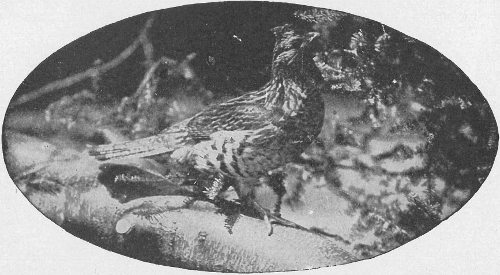
Ruffed Grouse.
BY
CHESTER A. REED
Author of
North American Birds’ Eggs, and, with Frank M. Chapman, of Color Key to North American Birds. Curator in Ornithology, Worcester Natural History Society
GARDEN CITY NEW YORK
DOUBLEDAY, PAGE & COMPANY
1921
Copyrighted 1906.
Copyrighted, 1910, CHAS. K. REED,
Worcester, Mass.
While strolling through a piece of woodland, or perhaps along the marsh or seashore, we see a bird, a strange bird—one we never saw before. Instantly, our curiosity is aroused, and the question arises, “What is it?” There is the bird! How can we find out what kind it is? The Ornithologist of a few years ago had but one course open to him, that is to shoot the bird, take it home, then pore through pages of descriptions, until one was found to correspond with the specimen. Obviously, such methods cannot be pursued today, both humane and economical reasons prohibiting. We have but one alternative left us: We must make copious notes of all the peculiarities and markings of the bird that is before us. On our return home, we get down our bird books, and there are many excellent ones. After carefully looking through the whole library, we find that, although many of our books are well illustrated, none of them has the picture of what we seek, so we adopt the tactics of the “Old-time” Ornithologist, before mentioned, and pore over pages of text, until finally we know what our bird was. It is for just such emergencies as this—to identify a bird when you see it, and where you see it, that this little pocket “Bird Guide” is prepared. May it be the medium for saving many of today’s seekers for “bird truths” from the many trials and tribulations willingly encountered, and hard and thorny roads gladly traveled by the author in his quest for knowledge of bird ways.
CHESTER A. REED.
Worcester, Mass.
1906.
The study of the birds included in this book is much more difficult than that of the small land birds. Many of the birds are large; some are very rare; all are usually shy and have keen eyesight, trained to see at a distance; in fact, many of them have to depend upon their vigilance for their very existence. Therefore, you will find that the majority of these birds will have to be studied at long range. Sometimes, by exercising care and forethought, you may be able to approach within a few feet of the bird you seek, or induce him to come to you. It is this pitting your wits against the cunning of the birds that furnishes one-half of the interest in their study. Remember that a quick motion will always cause a bird to fly. If you seek a flock of plover on the shore, or a heron in the marsh, try to sneak up behind cover if possible; if not, walk very slowly, and with as little motion as possible, directly towards them; by so doing you often will get near, for a bird is a poor judge of distance, while a single step sideways would cause him to fly. Shore birds can usually be best observed from a small “blind,” near the water’s edge, where they feed. Your powers of observation will be increased about tenfold if you are equipped with a good pair of field glasses; they are practically indispensable to the serious student and add greatly to the pleasures of anyone. Any good glass, that has a wide field of vision and magnifies three or four diameters, is suitable; we can recommend the ones described in the back of this book.
WHAT TO MAKE NOTE OF.—What is the nature of the locality where [7] seen; marsh, shore, woods, etc? If in trees does it sit upright or horizontal? If on the ground, does it run or walk, easily or with difficulty? If in the water, can it swim well, can it dive, does it swim under water, can it fly from the water easily, or does it have to patter over the surface before flying? What does it seem to be eating? Does it have any notes? Does it fly rapidly; with rapid wing beats or not; in a straight line or otherwise? Does it sail, or soar? In flocks or singly? These and hundreds of other questions that may suggest themselves, are of great interest and importance.
A PLEA TO SPORTSMEN.—Many of the birds shown in this book are Game Birds, that is, birds that the law allows you to shoot at certain seasons of the year. Some of these are still abundant and will be for numbers of years; others are very scarce and if they are further hunted, will become entirely exterminated in two or three years. Bob-whites are very scarce in New England; Prairie Hens are becoming scarce in parts of the west; the small Curlew is practically extinct, while the larger ones are rapidly going. In behalf of all bird lovers, we ask that you refrain from killing those species that you know are rare, and use moderation in the taking of all others. We also ask that you use any influence that may be yours to further laws prohibiting all traffic in birds. The man who makes his living shooting birds will make more, live longer and die happier tilling the soil than by killing God’s creatures. We do not, now, ask you to refrain from hunting entirely, but get your sport at your traps. It takes more skill to break a clay pigeon than to kill a quail.

TOPOGRAPHY OF A BIRD
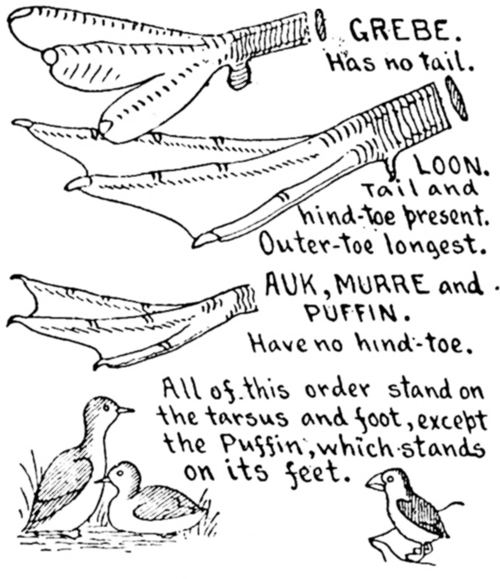
GREBES; Colymbidæ:—Form, duck-like; bill pointed and never flattened; no tail; legs at extreme end of body; each flattened toe with an individual web; wings small. Flies rapidly, but patters along the water before taking wing. Expert divers, using wings as well as feet, to propel them, under water.
LOONS. Family Gaviidæ:—Larger than Grebes; bill long, heavy, and pointed; tail very short; feet webbed like a duck’s, but legs thin and deep; form and habits, grebe-like.
AUKS, MURRES, PUFFINS. Family Alcidæ:—Bills very variable; tail short; usually takes flight when alarmed, instead of diving as do grebes and loons. With the exception of puffins, which stand on their feet, all birds of this order sit upon their whole leg and tail. They are awkward on land; some can hardly walk.
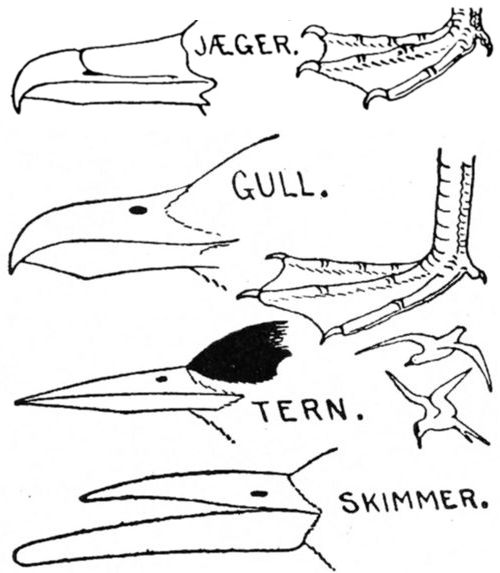
SKUAS, JAEGERS. Family Stercorariidæ:—Marine birds of prey; bill strongly hooked, with long scaly shield, or cere, at the base; claws strong and curved, hawk-like; flight hawk-like; plumage often entirely sooty-black, and always so on the back.
GULLS, TERNS. Family Laridæ:—Gulls have hooked bills, usually yellowish, yellow eyes and pale, webbed feet. Heap, underparts and square tail are white in adults; back, pearl-grey; exceptions are the four small black-headed gulls, which also have reddish legs. Gulls fly with the bill straight in front, and often rest on the water. Terns have forked tails, black caps, and their slender, pointed bills and small webbed feet are usually red. They fly with bill pointed down, and dive upon their prey.
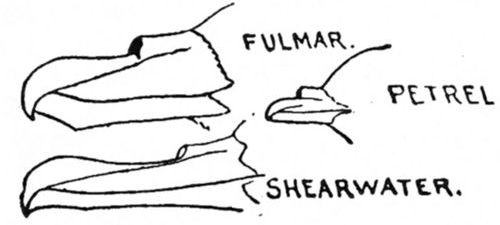
FULMARS, SHEARWATERS, PETRELS. Family Procellariidæ:—Nostrils opening in a tube on top of the hooked bill. Plumage of fulmars, gull-like; shearwaters [11] entirely sooty black, or white below; petrels blackish, with white rumps,—very small birds. All seabirds.
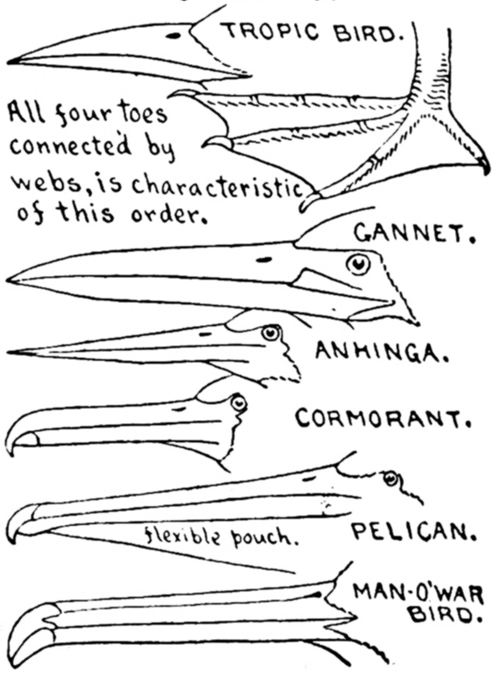
All four toes joined by webs.
TROPIC BIRDS. Family Phaethontidæ:—Bill and form tern-like; middle tail feathers very long.
GANNETS. Family Sulidæ:—Bill heavy and pointed; face and small throat pouch, bare.
SKAKE-BIRDS. Family Anhingidæ:—Bill slender and pointed; neck and tail very long, the latter rounded; habits like those of the following.
CORMORANTS. Family Phalacrocoracidæ:—Bill slender, but hooked at the tip; plumage glossy black and brown; eyes green. They use their wings as well as feet when pursuing fish under water.
PELICANS. Family Pelecanidæ:—Bill very long and with a large pouch suspended below.
MAN-O’-WAR BIRDS. Family Fregatidæ:—very long and strongly hooked; tail long and forked; wholly maritime, as are all but the preceding three.
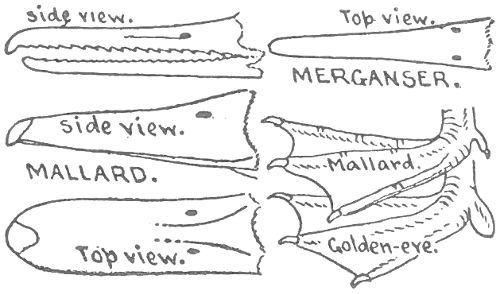
Mergansers, with slender, toothed bills with which to catch the fish they pursue under water.
Other ducks have rather broad bills, more or less resembling those of the domestic duck. Their flight is rapid and direct. River ducks have no web, or flap, on the hind toe; they get their food without going entirely under water, by tipping up. Sea ducks have a broad flap on the hind toe.
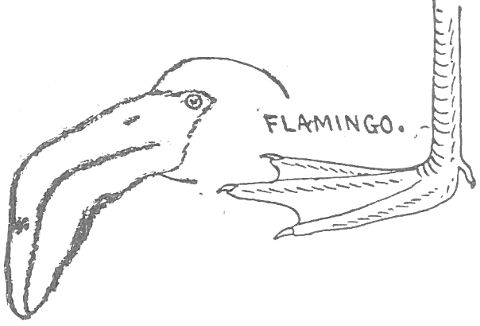
Family Phoenicopteridæ:—Large, long-necked, pink birds with a crooked box-like bill, long legs and webbed feet.

Long-legged, wading birds, with all four toes long, slender and without webs. Usually found about the muddy edges of ponds, lakes or creeks, and less often on the sea shore. Wings large and rounded.
SPOONBILL. Family Plataleidæ:—Bill long, thin and much broadened at the end; head bare.
IBISES. Family Ibididæ:—Bill long, slender and curved down. Ibises and Spoonbills fly with the neck fully extended.
STORKS. Family Ciconiidæ:—Bill long, heavy, and curved near the end; head and upper neck bare.
HERONS, BITTERNS, EGRETS. Family Ardeidæ:—Bill long, straight and pointed; head usually crested, and back often with plumes. Herons fly with a fold in the neck, and the back of the head resting against the shoulders.
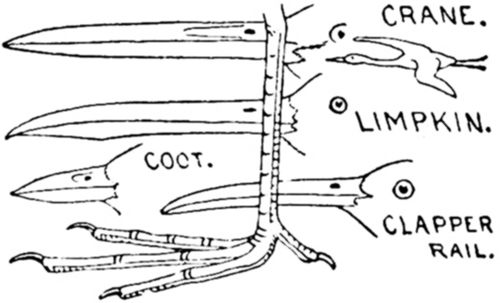
Birds of this order, vary greatly in size and appearance, but all agree in having the hind toe elevated, whereas that of the members of the last order leaves the foot on a level with the front toes; neck extended in flight.
CRANES. Family Grudidæ:—Very large and heron-like, but with plumage close feathered; top of head bare; bill long, slender and obtusely pointed.
COURLANS. Family Aramidæ:—Size mid-way between the cranes and rails; bill long and slender.
RAILS, ETC. Family Rallidæ:—Bills are variable, but toes and legs long; wings short; flight slow and wavering; marsh skulkers, hiding in rushes. Gallinules have a frontal shield on the forehead, Coots have lobate-webbed feet, short, whitish bills.
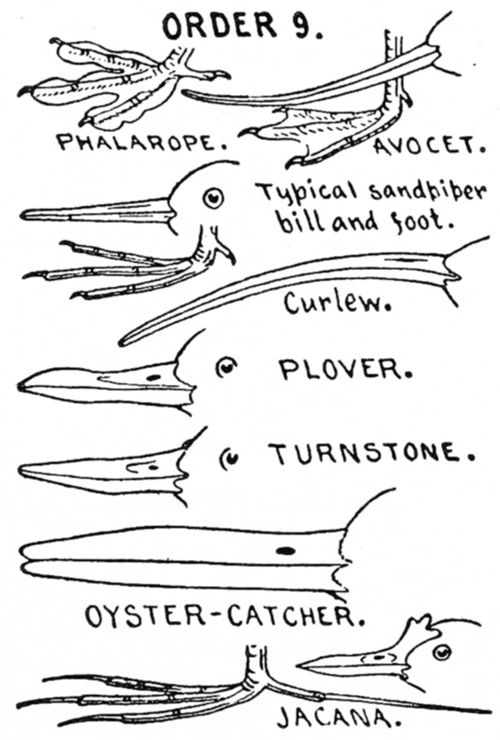
Comparatively small, long legged, slender-billed birds seen running along edges of ponds or beaches.
PHALAROPES. Phalaropodidæ.—Toes with lobed webs.
AVOCETS, STILTS. Recurvirostridæ:—Avocet, with slender recurved bill, and webbed feet; stilt, with straight bill, very long legs, toes not webbed.
SNIPES, SANDPIPERS, ETC. Family Scolopacidæ:—Bills very variable but slender, and all, except the Woodcock, with long pointed wings; flight usually swift and erratic.
PLOVERS. Family Charadriidæ:—Bill short and stout; three toes.
TURNSTONES. Family Aphrizidæ:—Bill short, stout and slightly up-turned; four toes.
OYSTER-CATCHERS. Family Hæmatopodidæ:—Bill long, heavy and compressed; legs and toes stout; three toes slightly webbed at base.
JACANAS. Family Jacanidæ:—Bill with leaf-like shield at the base; legs and toes extremely long and slender; sharp spur on wing.
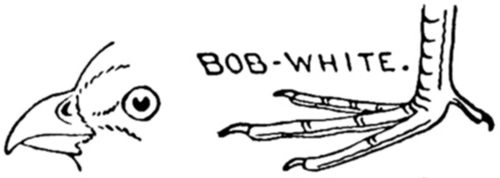
Ground birds of robust form; bill hen-like; wings short and rounded; feet large and strong.
PARTRIDGES, GROUSE. Family Tetraonidæ:—Legs bare in the partridges, feathered in grouse.
TURKEYS, PHEASANTS. Family Phasianidæ:—Legs often spurred, or head with wattles, etc.
GUANS. Family Cracidæ:—Represented by the Chachalaca of Texas.

Family Columbidæ:—Bill slender, hard at the tip, and with the nostrils opening in a fleshy membrane at the base. Plumage soft grays and browns.
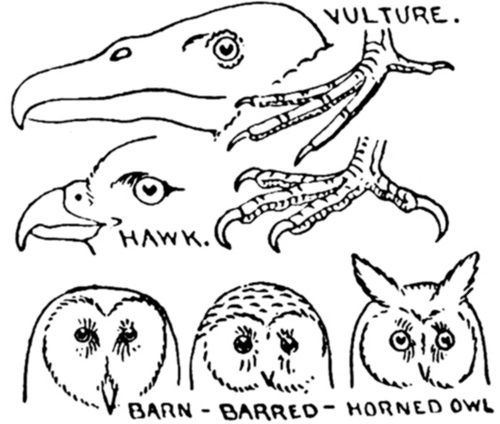
VULTURES. Cathartidæ:—Head bare; feet hen-like.
HAWKS, EAGLES. Falconidæ:—Bill and claws strongly hooked; nostrils in a cere at base of bill.
BARN OWLS. Aluconidæ:—Black eyes in triangular facial disc; middle toe-nail serrated.
HORNED OWLS, ETC. Bubonidæ:—Facial disc round; some species with ears, others without.
PART 1
Water Birds, Game Birds and Birds of Prey
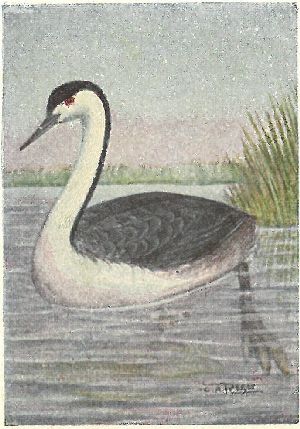
All grebes have lobate-webbed feet, that is each toe has its individual web, being joined to its fellow only for a short distance at the base.
This, the largest of our grebes, is frequently known as the “Swan Grebe” because of its extremely long, thin neck. In summer the back of the neck is black, but in winter it is gray like the back.
Notes.—Loud, quavering and cackling.
Nest.—A floating mass of decayed rushes, sometimes attached to upright stalks. The 2 to 5 eggs are pale, bluish white, usually stained (2.40 × 1.55). They breed in colonies.
Range.—Western North America, from the Dakotas and Manitoba to the Pacific, and north to southern Alaska. Winters in the Pacific coast states and Mexico.
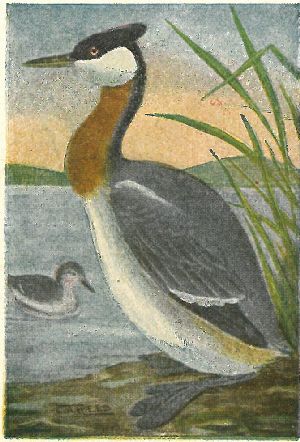
This is next to the Western Grebe in size, both being much larger than any of our others. In summer, they are very handsomely marked with a reddish brown neck, silvery white cheeks and throat, and black crown and crest, but in winter they take on the usual grebe dress of grayish above and glossy white below. Because of their silky appearance and firm texture, grebe breasts of all kinds have been extensively used in the past to adorn hats of women, who were either heedless or ignorant of the wholesale slaughter that was carried on that they might obtain them.
Nest.—Of decayed rushes like that of the last. Not in as large colonies; more often single pairs will be found nesting with other varieties. Their eggs average smaller than those of the last species (2.35 × 1.25).
Range.—North America, breeding most abundantly in the interior of Canada, and to some extent in the Dakotas. Winters in the U. S., chiefly on the coasts.
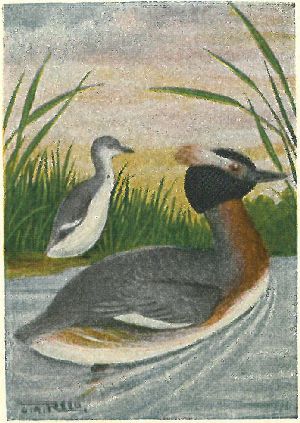
As is usual with grebes, summer brings a remarkable change in the dress of these birds. The black, puffy head is adorned with a pair of buffy white ear tufts and the foreneck is a rich chestnut color. In winter, they are plain gray and white but the secondaries are always largely white, as they are in the two preceding and the following species. The grebe diet consists almost wholly of small fish, which they are very expert at pursuing and catching under water. One that I kept in captivity in a large tank, for a few weeks, would never miss catching the shiners, upon which he was fed, at the first lightning-like dart of his slender neck. They also eat quantities of shell fish, and I doubt if they will refuse any kind of flesh, for they always have a keen appetite.
Nest.—A slovenly built pile of vegetation floating in the “sloughs” of western prairies. The 3 to 7 eggs are usually stained brownish yellow (1.70 × 1.15).
Range.—Breeds from Northern Illinois and So. Dakota northward; winters from northern U. S. to the Gulf of Mexico.
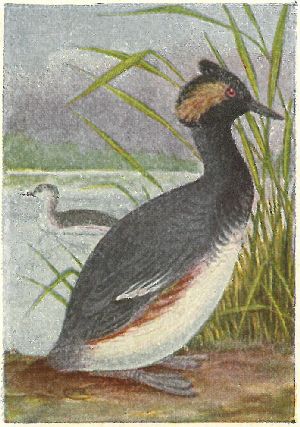
This is a western species rarely found east of the Mississippi. In summer, it differs from the last in having the entire neck black; in winter it can always be distinguished from the Horned Grebe by its slightly upcurved bill, while the upper mandible of the last is convex. In powers of swimming and diving, grebes are not surpassed by any of our water birds. They dive at the flash of a gun and swim long distances before coming to the surface; on this account they are often called “devil divers.” They fly swiftly when once a-wing, but their concave wings are so small that they have to patter over the water with their feet in order to rise.
Nest.—They nest in colonies, often in the same sloughs with Horned and Western Grebes, laying their eggs early in June. The 4 to 7 eggs are dull white, usually stained brownish, and cannot be separated from those of the last.
Range.—Western N. A., breeding from Texas to Manitoba and British Columbia; winters in western U. S. and Mexico.
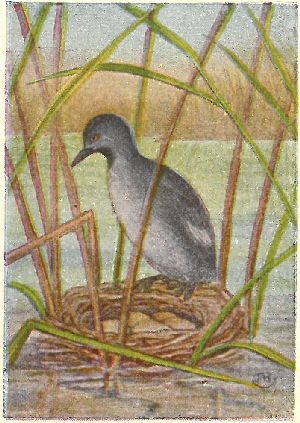
This is much smaller than any others of our grebes; in breeding plumage it most nearly resembles the following species, but the bill is black and sharply pointed. It has a black patch on the throat, and the crown and back of the head are glossy blue black; in winter, the throat and sides of the head are white.
Nest.—Not different from those of the other grebes. Only comparatively few of them breed in the U. S. but they are common in Mexico and Central America. Their eggs, when first laid, are a pale, chalky, greenish white, but they soon become discolored and stained so that they are a deep brownish, more so than any of the others; from 3 to 6 eggs is a full complement (1.40 × .95).
Range.—Found in the United States, only in the Lower Rio Grande Valley in Southern Texas, and southwards to northern South America.
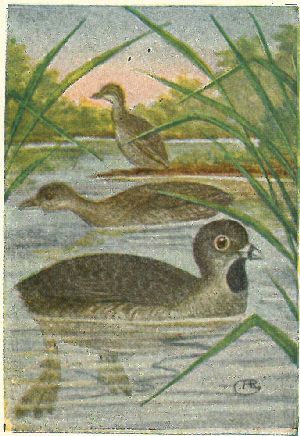
In any plumage this species cannot be mistaken for others, because of its stout compressed bill and brown iris; all the others have red eyes. In summer the bill is whitish with a black band encircling it; the throat is black; the eye encircled by a whitish ring; the breast and sides are brownish-gray. In winter they are brownish-black above and dull white below, with the breast and sides washed with brown. Young birds have more or less distinct whitish stripes on the head.
Notes.—A loud, ringing “kow-kow-kow-kow (repeated many times and ending in) kow-uh, kow-uh.”
Nest.—Of decayed rushes floating in reed-grown ponds or edges of lakes. The pile is slightly hollowed and, in this, the 5 to 8 eggs are laid; the bottom of the nest is always wet and the eggs are often partly in the water; they are usually covered with a wet mass when the bird is away. Brownish-white (1.70 × 1.15).
Range.—Whole of N. A., breeding locally and usually in pairs or small colonies.
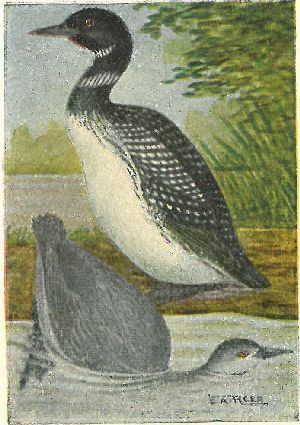
In form, loons resemble large grebes, but their feet are full webbed like those of a duck; they have short, stiff tails and long, heavy, pointed bills. They have no tufts or ruffs in breeding season, but their plumage changes greatly. The common loon is very beautifully and strikingly marked with black and white above, and white below; the head is black, with a crescent across the throat and a ring around the neck. In winter, they are plain gray above and white below.
Loons are fully as expert in diving and swimming as are the grebes. They are usually found in larger, more open bodies of water.
Notes.—A loud, quavering, drawn-out “wah-hoo-o-o.”
Nest.—Sometimes built of sticks, and sometimes simply a hollow in the sand or bank under overhanging bushes, usually on an island. The 2 eggs are brownish with a few black specks (3.50 × 2.25).
Range.—N. A., breeding from northern U. S. northwards; winters from northern U. S. southwards.
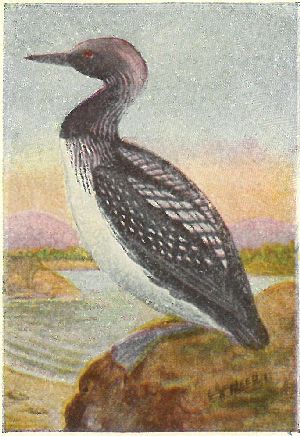
This loon lives in the Arctic regions and only rarely is found, in winter, in Northern United States. In summer, it can readily be distinguished from the common loon by the gray crown and hind-neck, as well as by different arrangement of the black and white markings. In winter, they are quite similar to the last species but can be recognized by their smaller size, and can be distinguished from the winter plumaged Red-throated Loon by the absence of any white markings on the back. Like the grebes, loons have to run over the surface of the water in order to take flight, and they are practically helpless when on land. Their flight is very rapid, in a straight line, and their neck is carried at full length in front. This species has red eyes, as do all the other loons.
Nest.—The same as the last species, but the two eggs have more of an olive tint and are smaller (3.10 × 2.00).
Range.—Arctic America, wintering in Canada and occasionally in Northern United States.
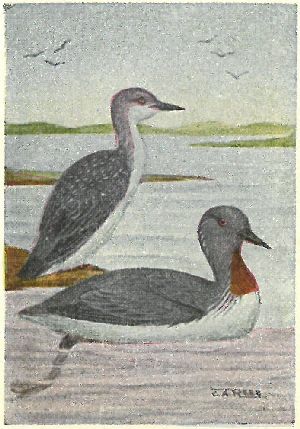
Besides being smaller than the common loon, this species has a more slender bill, which has a slightly up-turned appearance owing to the straight top to the upper mandible; in summer, its back and head are gray, with no white spots, although the back of the head has a few white streaks; there is a large patch of chestnut on the fore-neck; the under parts are white. In winter, it is gray above and white below, but the back is sprinkled with small white spots; at this season it can easily be distinguished from Holbœll Grebe by the absence of any white patch in the wings as well as by the differently shaped feet.
Nest.—A depression in the sand or ground, not more than a foot or two from the water’s edge, so they can slide from their two eggs into their natural element. The eggs, which are laid in June, are olive-brown, specked with black (2.90 × 1.75).
Range.—Breeds from New Brunswick and Manitoba north to the Arctic Ocean; winters throughout the United States.
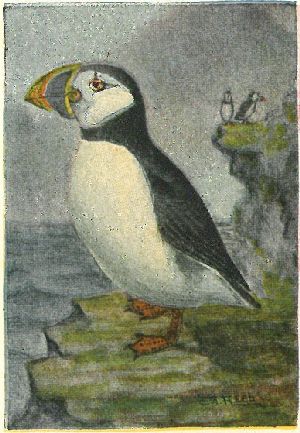
Puffins are grotesque birds, with short legs, stout bodies and very large, thin bills, that of the common Puffin being 2 in. in length and about the same in height; the bill is highly colored with red and yellow, and the feet are red; eyes, white. It will be noticed that the blackish band across the throat does not touch the chin, this distinguishing it from the Horned Puffin of the Pacific coast. Adults in winter shed the greater portion of their bill, lose the little horns that project over the eye, and the face is blackish; they then resemble young birds. They live on rocky shores, the more precipitous the better. They stand erect upon their feet and walk with ease.
Notes.—A low croak.
Nest.—They breed in large colonies on rocky cliffs, laying their single white eggs (2.50 × 1.75) in crevices.
Range.—Breeds from Matinicus Rock, Me., northward; winters south casually to Cape Cod. Large-billed Puffin (F. a. naumanni) is found in the Arctic Ocean.
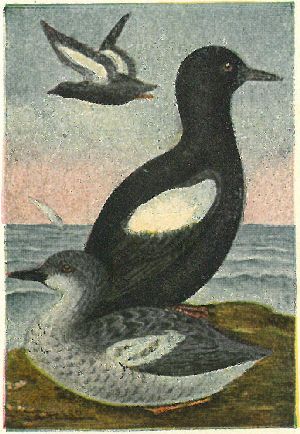
These birds are very abundant about the rocky islands from Maine northward. They may be seen sitting in rows on the edges of the rocks, or pattering along the water as they rise in flight, from its surface, at a boat’s approach. In summer the plumage is entirely black, except the large white patches on the wings; legs red; eyes brown. This species has the bases of the greater coverts black, while they are white in Mandt Guillemot (C. mandtii—No. 28), which is found from Labrador northward. In winter, these birds are mottled gray and white above, and white below, but the patches still show.
Notes.—A shrill, piercing, squealing whistle.
Nest.—Guillemots lay two eggs upon the bare rock or gravel in crevices or under piles of boulders where they are difficult to get at. They are grayish or greenish-white, beautifully and heavily blotched with black and brownish (2.40 × 1.60).
Range.—Breeds on coasts of North Atlantic from Maine northward; winters south to Long Island.
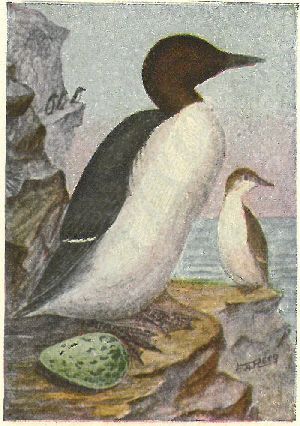
In summer the throat is brownish black, but in winter the throat and sides of head are white; feet blackish bill, long and stout, 1.7 in. long, while that of Brunnich Murre (Uria lomvia—No. 31), is shorter (1.25 in.) and more swollen. The ranges and habits of the two species are the same. Murres are very gregarious, nesting in large colonies on northern cliffs. In summer every ledge available at their nesting resort is lined with these birds, sitting upright on their single eggs.
Notes.—A hoarse imitation of their name “murre.”
Nest.—Their single eggs are laid upon the bare ledges of cliffs. They are pear-shaped to prevent their rolling off when the bird leaves; greenish, gray or white in color, handsomely blotched or lined with blackish (3.40 × 2.00). Their eggs present a greater diversity of coloration and marking than those of any other bird.
Range.—Breeds from the Magdalen Is. northward; winters south to Long Island.
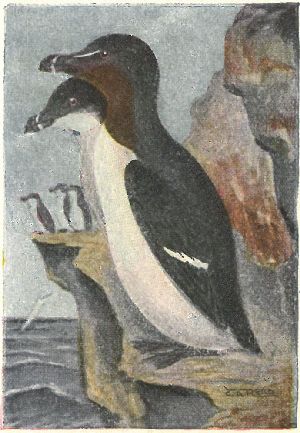
Similar in size and form to the murre, but with a short, deep, thin black bill, crossed by a white line. In summer, with a white line from the eye to top of bill, and with a brownish black throat; in winter, without the white line and with the throat and sides of head white. They nest and live in large colonies, usually in company with murres. Their food, like that of the murres, puffins and guillemots is of fish and shell fish, or marine worms. They get these from the rockweed along the shores or by diving; they are good swimmers, using both their feet and wings to propel them through the water, the same as do the grebes and loons.
Notes.—A hoarse grunt or groan (Chapman).
Nest.—Their single eggs are laid on ledges of cliffs; they are not nearly as pointed at the smaller end, as murre eggs, and are always grayish white in color, marked with blackish blotches (3.1 × 2.00).
Range.—Breeds from the Magdalen Islands northward; winters south to Long Island.
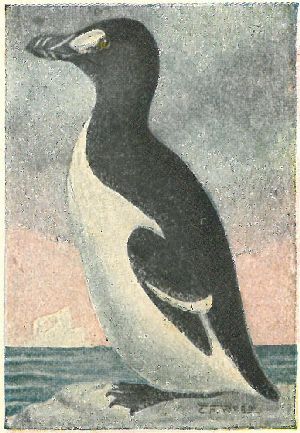
This largest of the auks lived, as far as we have authentic record, until 1844, when it became extinct, largely through the agency of man. Although nearly twice as long a bird as the Razor-billed Auk, their wings were shorter than those of that bird, being only a trifle longer than those of the little Dovekie; they were flightless, but the wings were used to good advantage in swimming. Being in the direct line of travel between the old world and the new, sailors, on passing vessels, killed countless numbers of them for food, and in some cases merely for the love of slaughter. They lived on coasts and islands of the Atlantic from Mass., northwards. There are about seventy mounted birds preserved, of which five or six, as well as some skeletons, are in this country.
Their eggs resemble those of the Razor-bill but, of course, are much larger (5.00 × 3.00). About 70 of these are in existence, six being in this country (Washington, Phila., and four recently purchased by John E. Thayer, of Lancaster, Mass.).
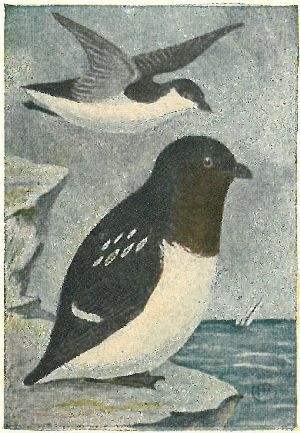
These little auks, called “ice birds” by the fishermen, are very abundant in the far north. In summer, they have a blackish brown throat and breast, but they are never seen in the United States or southern parts of the British possessions in that plumage. In winter, their throats and sides of the head are white as well as the rest of their upper parts. At all seasons the edges of the scapulars and tips of the secondaries are white, as are usually spots on each eyelid. Even in winter, they are only casually found on our coast, for they keep well out at sea. Occasionally they are blown inland by storms and found with their feet frozen fast in the ice of some of our ponds or lakes.
Nest.—They lay single pale greenish blue eggs, placing them in crevices of sea cliffs; size 1.80 × 1.25.
Range.—Breeds on islands in the Arctic Ocean and on the coasts of Northern Greenland; winters south to Long Island and casually farther.
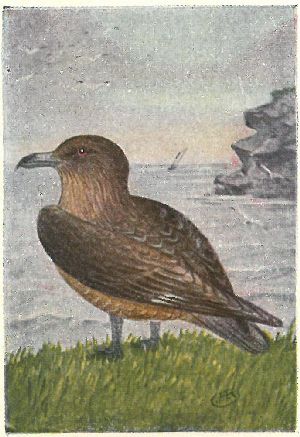
These large birds are the most powerful and audacious pirates among the sea fowl of northern waters. Their whole form is indicative of strength; form robust, feet strong, and bill large, powerful and hooked. Their plumage is of a nearly uniform blackish-brown, with white shafts to the wing feathers and a white patch at the base of the primaries.
Nest.—They do not nest in large colonies, only a single or a few pairs breeding in the same locality. Their nests are hollows in the ground, a short distance back from the rocky shores. The two eggs that they lay are olive brown, spotted with blackish (2.75 × 1.90).
Range.—North Atlantic coasts, chiefly on the Old World side, breeding from the Shetland Islands and possibly Greenland, northwards. They are only rarely found on our coasts even in winter, but have been taken as far south as New York.
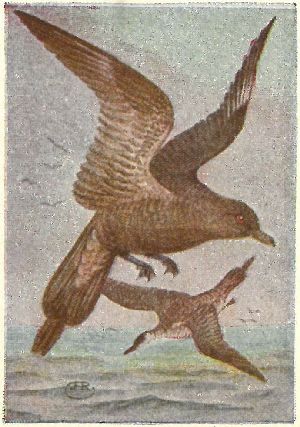
Jaegers are more slender in form than the Skuas, but like them are piratical in their habits, preying chiefly upon terns. Off Chatham, Mass., I have often watched them in pursuit of the graceful terns, but, excellent fliers as the latter birds are, they were always overtaken and forced to drop the fish that they carried, and the jaeger would rarely miss catching it as it fell. This species has two color phases independent of sex or age. In the light plumage the top of the head is black; rest of the upper parts and the under tail coverts brownish black; underparts and bases of primaries, white. Dark phase,—Entirely blackish brown except the white shafts to wing feathers and bases Of primaries. In any plumage they can be distinguished from the other species by the rounded, lengthened central tail feathers.
Nest.—A hollow in the ground in marshy places. The two eggs are olive brown spotted with black.
Range.—Northern hemisphere, breeding north of the Arctic Circle; winter from Mass. southward.
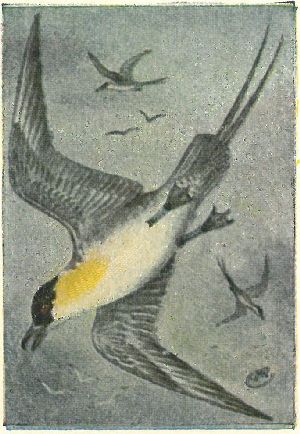
Two phases of color, both similar to those of the last, but the central pair of tail feathers are pointed and project about 4 in. beyond the others; bill 1.4 in. long, with the nostril nearest the end. All jaegers have grayish blue legs with black feet, and brown eyes. They are called “Jiddy hawks” by fishermen, who often feed them fish liver. Their flight is like that of a hawk. The nesting habits and range are the same as the next.
Like the last species, but with the pointed central tail feathers projecting 8 or 10 in. and with a shorter bill (1.15 in.) and the nostril about midway of its length. It is less often found in the dark phase.
Notes.—Shrill wailing whistles.
Nest.—Nest and eggs like those of the Pomarine Jaeger.
Range.—Arctic regions, wintering south to Florida.
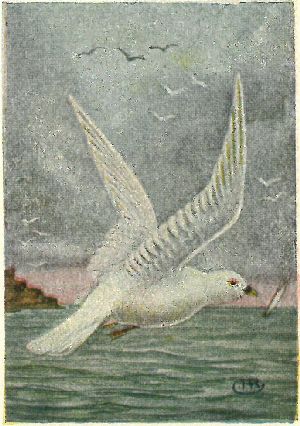
Entirely pure white with the shafts of the primaries yellowish; bill dark at base and yellow at tip; eyes brown, surrounded by a narrow red ring; feet black. Young birds are spotted with brown on the head, tips of wing and tail. This beautiful “Snow Gull,” as it is called by whalers, is abundant at its breeding ground in the Arctic regions, but is rarely seen as far south as the United States. It breeds the farthest north of any of the gulls except Ross Gull.
Nest.—Of grasses and seaweed, usually on ledges of cliffs, but occasionally on the ground farther inland. The three eggs, laid in June, are grayish-buff, marked with brown and black (2.30 × 1.70).
Range.—Breeds only north of the Arctic Circle, and winters south to New Brunswick and British Columbia; casually to Long Island and the Great Lakes.
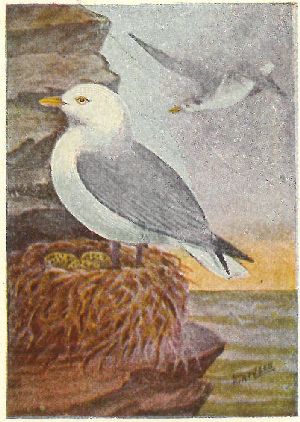
In summer, with plumage white, except the gray back and wings, and solid black tips to the primaries; in winter, the sides and back of the head are washed with the color of the back; young birds are like winter adults but have a dusky spot back of the eye; feet blackish, bill yellow in adults and black in young birds. Kittiwakes are very abundant in their northern breeding ground, and are common off the New England coast in winter. They usually keep well out at sea, often hovering around fishing boats to pick up refuse that is thrown overboard. They can easily be identified by their small size, the distinct black tip to the wings and their black feet.
Notes.—“Keet-a-wake, keet-a-wake.”
Nest.—A pile of small sticks, grass and weeds, placed on ledges of sea cliffs. The 3 or 4 eggs are olive gray, with black markings (2.20 × 1.70).
Range.—Breeds from the Gulf of St. Lawrence north to the Arctic Circle; winters south to Long Island and casually farther.
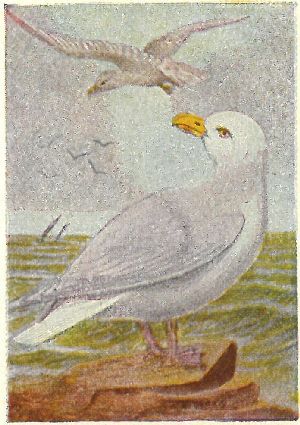
Plumage white with a pearl gray mantle; no black in the plumage, the primaries being white or grayish; bill and eye yellow, the former with a red spot at the end of the lower mandible; feet flesh color. In winter, the head is slightly streaked with brownish. Young birds are mottled grayish brown and white, of varying shades, but always lighter than the young of the Herring Gull. Some specimens are very beautiful, being entirely white, with a few spots of brownish on the back, resembling the markings of a light-colored Snowy Owl. This species is one of the largest and most powerful of the gull family, only surpassed by the Great Black-backed Gull.
Nest.—Usually a bulky structure of grasses, seaweed and moss placed on the ground; the two or three eggs are brownish gray with brown and black spots (3. × 2.20).
Range.—Breeds from Labrador and Hudson Bay northward; winters south to New England, the Great Lakes and Calif.
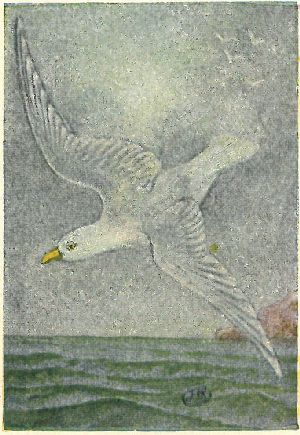
Plumage exactly like that of the Glaucus Gull but the birds are smaller and are found farther north.
Range.—Breeds in Greenland and winters south to Northern New England and the Great Lakes.
Plumage very similar to that of the Iceland and Glaucus Gulls, but with the primaries conspicuously gray, with white tips. As usual with the gull family, this species feeds largely, during the nesting season upon eggs and young of other sea birds. They seem to have a special liking for Cormorant eggs, and these ungainly creatures have to sit on their nests very closely to prevent being robbed.
Range.—Breeds about the mouth of Hudson Bay; winters south to Long Island.
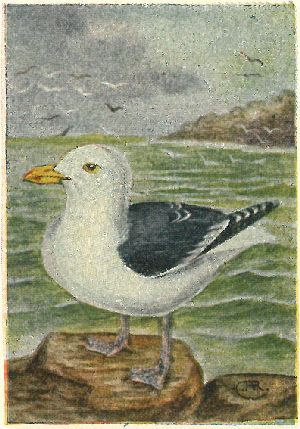
Largest and most powerful of our gulls. Adults in summer have the head, tail and underparts white, back slaty black, eyes and bill yellow, with a red spot near the tip of the lower mandible; feet flesh color; primaries tipped with white. In winter, the head is streaked with dusky. Young birds are mottled with dusky brown above, and streaked with the same below. These birds are very rapacious, and besides feeding upon refuse, fish and shellfish, devour, during the summer season, a great many eggs and young of other sea birds; this habit is common to nearly all the larger gulls.
Notes.—A laughing “ha-ha” and a harsh “keouw.”
Nest.—Either hollows on the ground or masses of weeds and drift, hollowed out to receive the three grayish brown eggs, spotted with blackish and lilac (3. × 2.15).
Range.—These gulls breed from Newfoundland northward, being most abundant on the Labrador coast. In winter they are found as far south as the Carolinas, usually in company with Herring Gulls.
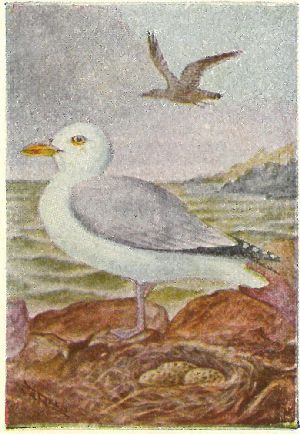
Adults in summer, white, with gray mantle, and black primaries tipped with white. In winter, the head and neck are streaked below with grayish brown. Bills of adults, yellow with red spot on lower mandible; eye yellow; feet flesh color; bill of young, flesh color with a blackish tip. These are the most abundant of the larger gulls and the best known because of their southerly distribution. Several of the smaller Maine islands have colonies of thousands of birds each, and in winter great numbers of them are seen in all the harbors along our seacoast. Young gulls are born covered with down, and can run swiftly and swim well.
Notes.—“Cack-cack-cack” and very noisy squawkings when disturbed at their breeding grounds.
Nest.—A hollow in the ground, or a heap of weeds and trash. The three eggs are olive-gray, spotted with black (2.8 × 1.7).
Range.—Breeds from Maine, the Great Lakes and Dakotas northward; winters south to the Gulf of Mexico.
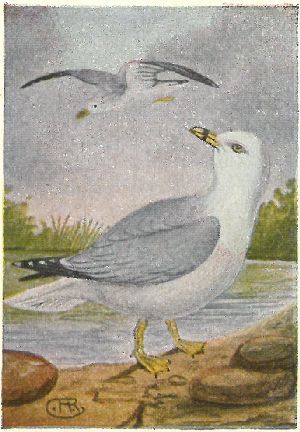
Adults in summer.—White with pearl gray mantle; ends of outer primaries black with white tips; eye yellow; feet and bill greenish-yellow, the latter crossed by a black band near the tip. In winter, the head and neck are streaked with grayish. Young birds are mottled brownish-gray above, and the tail has a band of blackish near the end.
The adults can be distinguished from the Kittiwakes, which most closely resemble them, by the yellowish feet and white tips to the black primaries.
Nest.—In hollows in the ground, usually in grass. The two or three eggs are gray or brownish gray, strongly marked with black (2.80 × 1.75). They breed in large colonies, often in company with other gulls and terns.
Range.—Whole or North America, breeding from Newfoundland, Dakota and British Columbia northwards, most abundantly in the interior; winters from Northern United States southward.
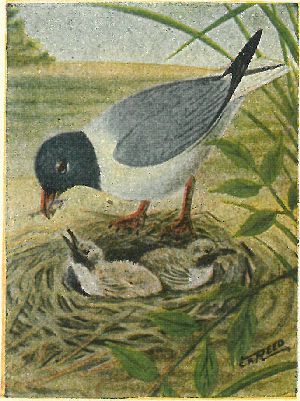
Largest of the black-headed gulls. Bill and feet carmine-red; primaries wholly black or only with slight white tips; eye brown; in breeding season, with the underparts tinged with pinkish. In winter, without the black hood, the head being tinged with grayish, and the bill and feet dusky. Young birds are like winter adults with the back more or less mixed with brownish and the tail crossed by a black band. The most southerly distributed of our eastern gulls, its northern breeding place being on the southern shore of Mass.
Notes.—Strange cackling laughter; hence their name.
Nest.—Heaps of rubbish and weeds on the ground in wet marshes. The 3 to 5 eggs are gray or olive-gray with black spots (2.25 × 1.60).
Range.—Breeds from the Gulf of Mexico north to Mass., and in the interior to Ohio, but most abundantly on the South Atlantic coast. Winters from the Carolinas to Northern South America.

Adult in summer.—Hood dark; mantle lighter than the last species; primaries gray with black ends broadly tipped with white; underparts rosy; bill and feet red, the former dark toward the tip, and more slender than that of the Laughing Gull. In winter, the plumage changes the same as that of the last but the color of the primaries and the shape of the bill will always identify this species. These gulls are strictly birds of the interior, nesting on low marshy islands in ponds or sloughs, often in company with grebes, upon whose eggs they subsist to a great extent.
Notes.—Similar to those of the last species.
Nest.—A mass of weeds, etc., on the ground in marshes, often partly floating in the water. The eggs are similar to those of the Laughing Gull but the markings are usually in the form of zigzag lines as well as spots (2.25 × 1.60).
Range.—Interior of North America, breeding from Iowa and the Dakotas north to Middle Canada; winters from the Gulf States southward.

Adult in summer.—Hood lighter gray and not as extensive as in the last two species; bill slender and black; feet coral red; primaries white with black tips and outer web of first one; mantle paler than either of the last. In winter, the head is white with gray spots back of the eyes. Young birds have the back mixed with brownish and the tail with a band of black near the tip, but the bill and primaries always separate this species in any plumage from the other black-headed gulls. These little gulls are one of the most beautiful and graceful of the family, but they are rarely found in the U. S. with the dark hood.
Nest.—Of weeds and grass on the ground, but not in the watery situations chosen by the preceding species. The three eggs are olive-brown, marked with blackish (1.90 × 1.30).
Range.—Breeds in the interior from Hudson Bay and Northern Manitoba northward. Winters from Maine, the Great Lakes and British Columbia southward.
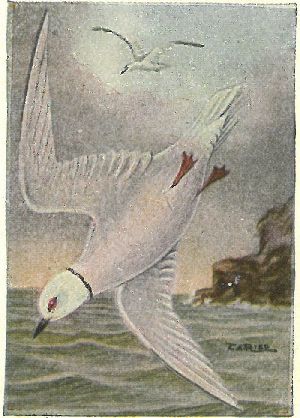
Bill short and slender; tail wedge-shaped. Adults in summer.—With no hood, but with narrow black collar; mantle light pearl; primaries wholly white with the exception of a blackish outer web to the first one; feet coral red, and underparts tinged with rosy in the nesting season. In winter, with no black collar nor pink underparts, and with blackish spot before the eye. Young mixed with blackish above, and with a black band across the tip of the tail; feet black; easily distinguished, when in the hand, by the very small bill, and the wedge shaped tail. This gull has the most northern distribution of any known bird, except, possibly, the Knot. Its breeding grounds were first reported by Nansen in 1896, in Franz Josef Land. It is one of the rarest birds in collections.
Range.—Polar regions, south in winter to Point Barrow, Alaska, and Disco Bay, Greenland.
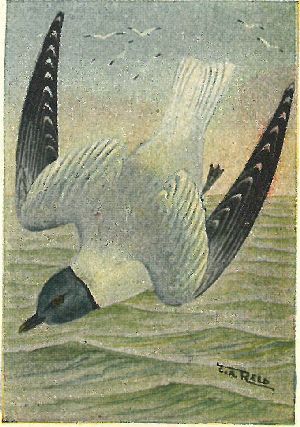
Tail slightly forked; bill small and black, tipped with yellow. Adults in summer.—Head with a slaty-gray hood, edged with a black ring around the neck; outer primaries black, with white tips, and edge of shoulder black; feet blackish; eye ring orange red. In winter, without the hood or collar, but the head is tinged with gray on the ears and nape. Young birds most nearly resemble those of the Bonaparte Gull, but the primaries are blackish, and the tail slightly forked. This species is very abundant within the Arctic Circle, but is not as boreal as the last.
Nest.—In depressions in the ground, usually lined with grass; the three eggs are olive-brown, marked with deeper brown and black (1.75 × 1.25).
Range.—Breeds from northern Alaska and the islands about the mouth of Hudson Bay northwards; winters south on the Atlantic coast to Maine and rarely New York.
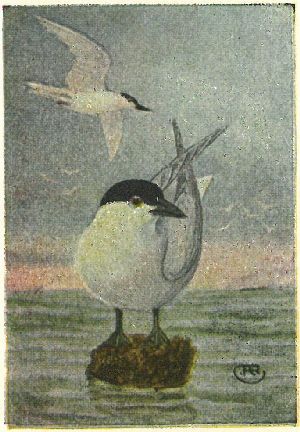
Differs from all other terns in the shape of its black bill, which is stout, but with the upper mandible not hooked nor curved, as in the gulls. Tail forked about 1.5 in. Adults have the crown black in summer, while in winter the head is white, with the nape and spot in front of eye, black mixed with white. Young birds are similar to winter adults but have the back feathers margined with brownish, and the neck streaked with gray. This species is found only on our South Atlantic and Gulf coasts, and is not abundant anywhere.
Notes.—A high, thin, somewhat reedy “tee-tee-tee,” sometimes suggesting a weak voiced katydid (Chapman).
Nest.—A slight, unlined depression in the short marsh grass or on the beaches. The three eggs are olive gray, spotted with black and brown (1.80 × 1.30).
Range.—Breeds in Texas and along the Gulf and South Atlantic coasts to Virginia; later, may wander north to New England; winters south of the U. S.
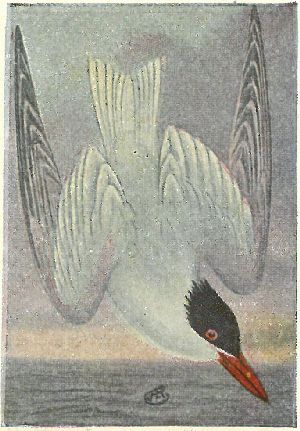
Largest of our terns. Bill heavy and bright red; head crested; tail forked about 1.5 in.; eyes brown. Adults in summer have the crown and occipital crest glossy black. Winter adults and young birds have the crown mixed with white, and the latter are also blotched with blackish on wings and tail.
Nest.—The 2 or 3 buffy, spotted eggs are laid in hollows in the sand. Size 2.60 × 1.75.
Range.—Breeds locally along the South Atlantic coast and in the interior to Great Slave Lake.
Similar to the last, but smaller; bill more slender; tail forked 3.5 in.
Nest.—A hollow in the sand. The 2 or 3 eggs are creamy buff, with distinct blackish-brown spots (2.60 × 1.70).
Range.—Breeds in the Gulf States and north to Virginia and Calif.; winters south of the U. S.
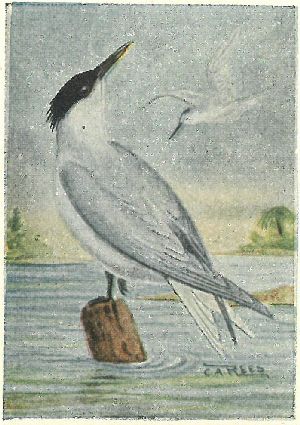
Head crested; bill and feet blackish, the former with a yellow tip. Adults have the crown glossy black. Young birds, and winter adults, have the crown mixed with white, and the former have blackish markings on the wings; tail forked 2.75 in. Like the majority of terns, these breed in immense colonies.
Nest.—Their two or three eggs are deposited in slight hollows in the sand. They are cream colored, boldly spotted with blackish brown (2.10 × 1.40).
Range.—Breeds on the Florida Keys, Bahamas and the West Indies; later may stray north as far as New England; winters south of the United States.
This is a rare South American species, described by Audubon as having occurred in New Jersey and New York. It has the form of the Forster Tern, a bright yellow bill and no black crown, but a black line through the eye to the ears.
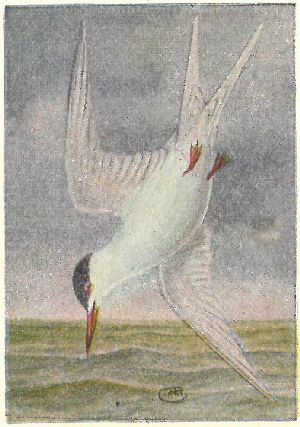
No crest on this or any of the following terns. Tail forked 4 in.; below pure white. In summer, with bill and feet orange red; crown black. In winter, the crown is white, but there is a blackish patch about the eyes, and the bill and feet are dark. These beautiful birds are often known as “Sea Swallows,” because of their similarity in form and flight to those well known land birds. They are the embodiment of grace as they dart about high in the air, bill pointed downward, alert and ready to dart down upon any small fish or eel that may attract their fancy. They usually get their food by plunging.
Notes.—A sharp, twanging “cack.”
Nest.—A hollow in the ground, in which the 3 eggs are laid in June. Eggs whitish, greenish or brownish, variously marked with brown, black and lavender (1.80 × 1.30).
Range.—Breeds in the interior, north to Manitoba, and on the coasts to Virginia and Calif. Winters from the Gulf States southward.
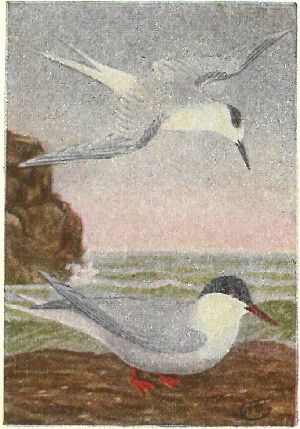
Mantle darker than that of any of the similar terns; washed with grayish below; bill and feet bright red, the former shading to black on the tip; tail less deeply forked (3.1 in.); edge of outer primaries and outer tail feathers, blackish. Changes in winter correspond to those of the last. Young birds have the feathers on the back margined with brownish.
Note.—An energetic “tee-arr, tee-arr.”
Nest.—The three eggs are laid in a slight hollow on the sandy beach.
Range.—Breeds locally from the Gulf States to Greenland and Hudson Bay; winters south of the U. S.
Similar to the Common Tern, but tail longer (forked 4.5 in.) and bill wholly red. In winter, bill and feet dark, as are those of the others.
Range.—Breeds from Mass. northwards; winters in the south.
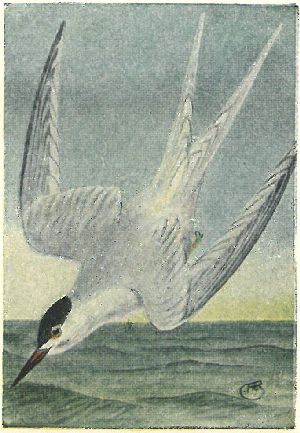
This species is the most gracefully formed of the terns. The tail is 7.5 in. long, forked to a depth of 5.25 in. In summer, the bill is blackish, changing to red only at the base. The underparts are a beautiful rosy tint in the breeding season; tail entirely white; feet red. In winter the usual changes occur, and young birds have dusky edges to the feathers of the back and wings. Terns are now becoming more abundant on our coast, their slaughter and persecution for millinery purposes fortunately having been stopped in time to prevent their extinction.
They feed chiefly upon small fish and marine insects, and often gather about fishing boats, waiting for an opportunity to dive after any bit that may be thrown overboard.
Notes.—A harsh “cack” and “tee-arr,” like that of the common Tern.
Nest.—Eggs like those of the similar terns.
Range.—Breeds on the Atlantic coast north to Mass.; winters south of the U. S.
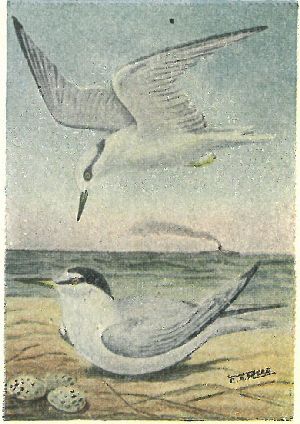
Smallest of our terns. Adult in summer.—Crown, nape, and line through the eye, black; forehead and line above the eye, white; bill and feet yellow, the former black at the tip. In winter, the crown is white, the blackish being restricted to the nape and about the eyes.
These pretty little sea swallows were abundant both on the coast and in the interior but are yearly becoming more scarce especially on the Atlantic coast. They are very aggressive when anyone approaches their nesting grounds and will continually dash down at you as they utter their sharp cries of disapproval.
Notes.—A sharp, metallic clattering “cheep, cheep.”
Nest.—Two or three eggs are laid upon the bare sand. They are buffy-gray, sharply specked with blackish (1.25 × .95).
Range.—Breeds north to Mass., the Great Lakes and Calif.; winters south of the United States.
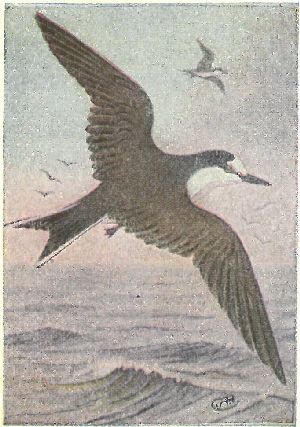
Adult in summer.—Above sooty-black, except the white outer tail feathers. Crown, line through the eye, bill and feet, black; forehead and underparts white; eye red. Young birds are smoky slate color all over, with the tail feathers, and some on the back and breast, tipped with whitish. This is the “egg bird” of tropical countries, thousands of their eggs being taken for food.
Note.—A nasal “ker-wacky-wak” (Chapman).
Nest.—A single egg deposited in a hollow in the sand; it is creamy-white, spotted with blackish-brown.
Range.—Tropical countries; breeds north to the Florida Keys and islands in the Gulf of Mexico; sometimes wanders north to New England.
Similar to the last, but the back and wings much lighter, and the white of the forehead extends over the eyes; nape whitish.
Range.—Breeds north to the Bahamas.
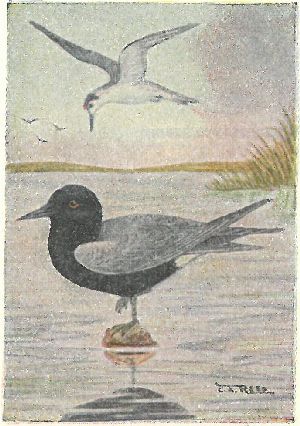
Adults in summer with the head, neck and underparts, black; back, wings and tail, dark gray; eyes brown. In winter, the forehead, neck and underparts are white; nape and patch back of eye blackish.
In summer these little terns are found only in the interior, where they nest about marshy ponds. They are very pugnacious and will sometimes touch an intruder with their wings as they dart past. As usual with the family, they nest in colonies.
Notes.—A sharp “peek.” (Chapman).
Nest.—A pile of weeds and trash in sloughs on the prairies, or about the edges of marshy lakes, the nests often being surrounded by, and partly floating in the water. The three eggs are very dark colored, having an olive-brown or greenish background, blotched with black (1.35 × .95).
Range.—Breeds in the interior from middle U. S. north to Alaska and Hudson Bay; winters south of the U. S., migrating along the Atlantic coast as well as in the interior.
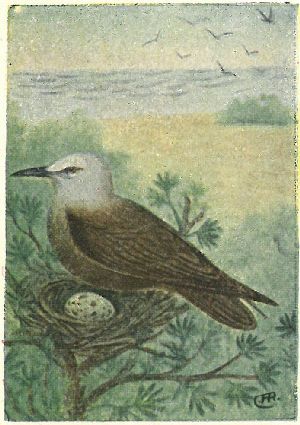
Adults with the crown silvery-white, the rest of the plumage being sooty-brown; the bill, feet and line to the eye are black. The plumage of these beautiful birds is very soft and pleasing to the eye. They look to be gentle and confiding, and a closer acquaintance shows that they are. They will frequently allow themselves to be touched with the hand before they leave their nests. They are abundant in some of the Bahaman and West Indian Islands, where they nest in company with other species.
Notes.—A hoarse reedy “cack” increasing to a guttural “k-r-r-r-r-r-r-r.” (Chapman).
Nest.—Of sticks and grasses, placed at low elevations in the tops of trees and bushes, or upon the ground. The single egg that they lay is buffy, spotted with black and brown (2.00 × 1.30).
Range.—Breeds north to the Bahamas and on Bird Key near Key West; rarely wanders on the Atlantic coast to South Carolina.
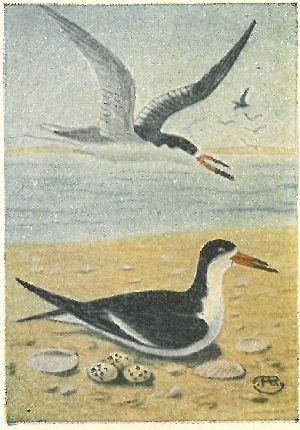
These strange birds are not apt to be mistaken for any other. They are locally abundant on the South Atlantic coast as far north as Virginia. Their flight is swift and more direct than that of terns; they fly in compact flocks, in long sweeps over the water, feeding by dropping their long, thin mandible beneath the surface and gathering in everything edible that comes in their path.
Notes.—Baying like a pack of hounds.
Nest.—Their 3 or 4 eggs are deposited in hollows in the sandy beaches. They are creamy-white, beautifully marked with blackish-brown and gray (1.75 × 1.30).
Range.—Breeds on the Gulf coast and on the Atlantic coast to New Jersey; after nesting, they occasionally wander northward as far as Nova Scotia; winters from the Gulf States southwards.
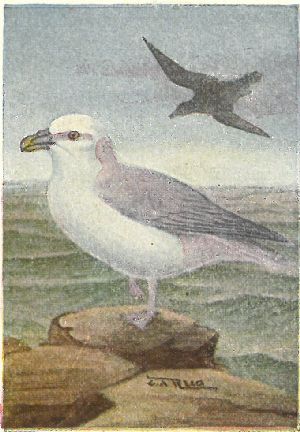
Bill short and stout, compared to that of the shearwaters, strongly hooked at the tip and with the nostrils opening out of a single tube, prominently located on the top of the bill. They have two color phases, the light one being gull-like, but the tail is gray like the mantle; eyes brown; bill and feet yellowish. In the dark phase they are uniformly gray above and below. These plumages appear to be independent of sex or age. They are extremely abundant at some of their breeding grounds in the far north. The birds are constant companions of the whalers, and feed largely upon blubber that is thrown overboard.
Nest.—Their single white eggs are laid upon bare ledges of sea cliffs (2.90 × 2.00).
Range.—Breeds in the North Atlantic and Arctic Oceans from Labrador and northern Scotland northward; winters south regularly.
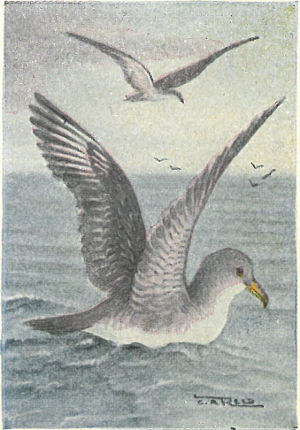
This rare bird is found off the coast of New England and in Long Island Sound from July to September. It is slightly larger than the similar Greater Shearwater, the back and head are lighter in color, the entire underparts are white, and the bill is yellowish. Its nesting habits and eggs are unknown, but they are supposed to breed in the Antarctic regions.
The majority of specimens that have been taken have been found off Chatham, Mass.
This small shearwater, except in point of size, is quite similar to the following, but the under parts are white, except the under tail coverts which are sooty; the back and head are somewhat lighter too. They nest in abundance on some of the Bahaman and West Indian Islands, and can usually be met with off the South Atlantic coast in summer.
Their eggs, which are pure white (2.00 × 1.35), are deposited at the end of burrows dug by the birds.
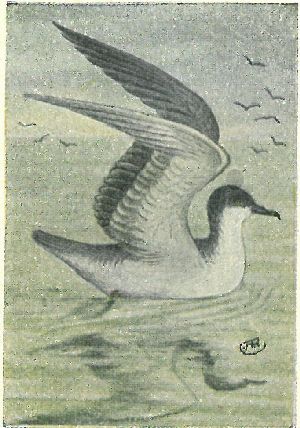
Entire upper parts, top and sides of head, bill and feet, grayish or brownish-black; middle of belly and under tail coverts dusky. This species is the most abundant of the shearwaters found off our coast. They are constant attendants of the fishermen when they are at work, and at other times are usually to be seen flying low over the water, or resting in large bodies upon its surface. Their flight is peculiar and distinctive,—three flaps of the wings then a short sail, repeated over and over. Possibly this habit is acquired by their swooping down into the troughs of waves, then flapping to clear the next crest. They are very greedy and continually quarreling among themselves in order to get the lion’s share of the food. They are called “Haglets” by the fishermen.
Notes.—Harsh, discordant squawks when feeding.
Nest.—While the habits of these birds are well known their breeding places are yet a mystery.
Range.—Whole North Atlantic coast in summer.
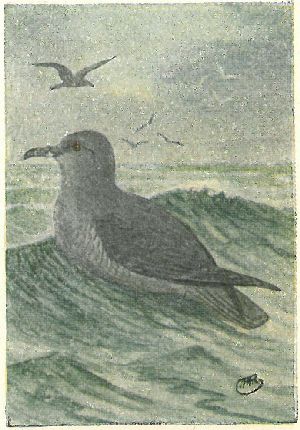
Sooty grayish-black all over except the under wing coverts, which are whitish; eye brown, bill and feet black. A few of these may usually be seen with flocks of the Greater Shearwaters, and sometimes a flock composed entirely of this variety will be encountered. They are expert swimmers on the surface of the water, but I have never seen one dive. Their food is almost if not wholly composed of oily refuse gathered from the surface of the water. In order to take flight, they paddle along the water a few steps; it is difficult for them to rise, except against the wind. If you sail upon them from the windward, they go squawking and pattering over the water in all directions, and can frequently be caught in nets. They are very tame, and will sometimes take food offered them, from the hand.
Notes.—Guttural squawks like those of the large species.
Range.—North Atlantic coast in summer.
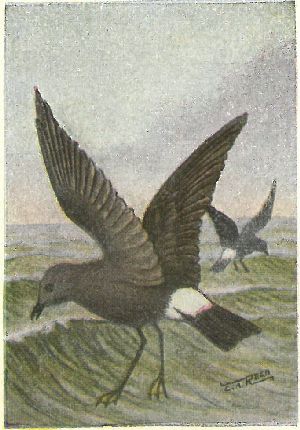
Smallest of our petrels, and darker than either the Leach or Wilson; tail square; upper tail coverts white, tipped with black.
This species is rare on the coasts of this country, but is common on the shores of the old world. It is the original “Mother Cary’s Chicken.” They nest abundantly on the shores of Europe and the British Isles.
Their single white eggs, deposited at the end of burrows, are dull white with a faint wreath of brown dots.
Tail square at end; coverts white, not tipped with black; legs long, with yellow webs. This species is very abundant on our Atlantic coast from July to Sept., spending the summer here after having nested in the Kerguelen Is. in February. Their upper parts are much more darker than those of Leach Petrel.
Their note is a weak twittering “keet-keet.”
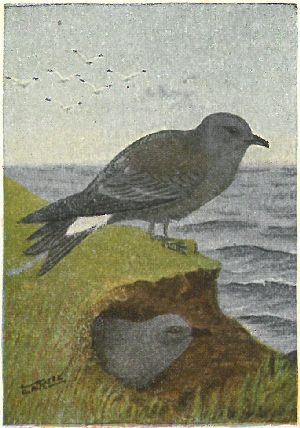
Tail forked; tail coverts white, not tipped with black; legs much shorter than those of Wilson Petrel, which is the only other common species on our eastern coasts. Leach Petrel is a very abundant breeding bird on Maine islands and northward. Some of the soft peaty banks of islands are honeycombed with entrances to their burrows, which extend back, near the surface of the ground, for two or three feet, and terminate in an enlarged chamber. Here one of the birds is always found during the period of incubation, and sometimes both birds, but one is usually at sea feeding during the daytime, returning at night to relieve its mate. All petrels and their eggs have a peculiar, characteristic and oppressive odor.
Notes.—A weak clucking.
Nest.—Single egg at end of burrow; white with a very faint ring of brown dots around the large end.
Range.—Breeds northward from Maine; winters to Virginia.
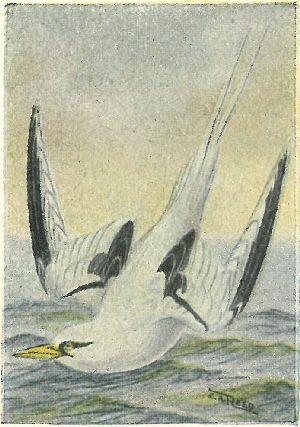
Form tern-like, but with the central tail feathers much lengthened (about 18 in.); legs short and not very strong; all four toes connected by webs.
These beautiful creatures fly with the ease and grace of a tern, but with more rapid beating of the wings. They are strong and capable of protracted flight, often being found hundreds of miles from land. They feed upon small fish which they capture by diving upon from a height above the water, and upon snails, etc., that they get from the beaches and ledges. They are very buoyant, and sit high in the water with their tails elevated to keep them from getting wet.
Nest.—A mass of weeds and seaweed placed upon rocky ledges. The single egg that they lay is creamy, so thickly sprinkled and dotted with purplish brown as to obscure the ground color (2.10 × 1.45).
Range.—Breeds north to the Bahamas and Bermudas.
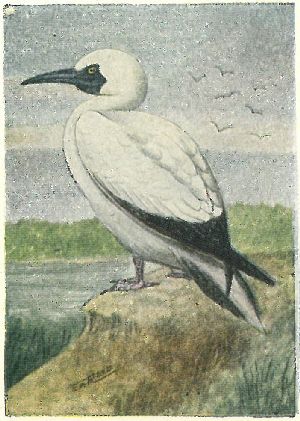
Bill, face and naked throat pouch, slaty-blue; eye yellow; feet reddish. Plumage white except the primaries, secondaries and other tail feathers, which are black. Young birds are streaked above with gray and brownish, and are dull white below. Boobies are birds of wide distribution in the Tropics, this species being rarely seen in southern Florida, but quite abundant on some of the West Indian islands. Owing to the numerous air cells beneath their skin, they are very buoyant and can ride the waves with ease during severe storms. They secure their prey, which is chiefly fish, by plunging after it.
Nest.—Their one or two eggs are laid usually upon the bare ground on low islands, or sometimes in weed-lined hollows. The eggs are pure white, covered with a thick chalky deposit (2.50 × 1.70).
Range.—Breeds north to the Bahamas and the Gulf of California; sometimes strays to Florida.
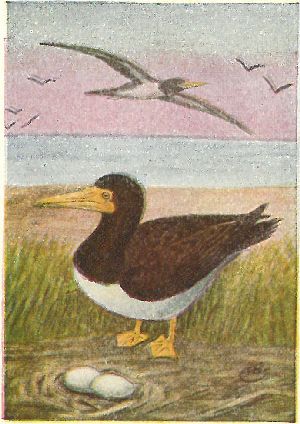
This species, commonly called the Brown Booby, is brownish black with the exception of a white breast and underparts. Young birds are entirely brownish black; bill and feet greenish yellow; eye white. They are one of the most abundant breeding birds upon many of the Bahaman and West Indian Islands. They have great powers of flight and dart about with the speed of arrows, carrying their long bill and neck at full length before them. They are awkward walkers, and, owing to their buoyancy, it is difficult for them to swim under water, but they are unerring in securing their prey by plunging upon it from a height.
Nest.—They breed in colonies of thousands, laying their two eggs upon the bare sand or rocks. The eggs are chalky white, more or less nest stained (2.40 × 1.60).
Range.—Breeds in the Bahamas and West Indies; wanders north casually to the Carolinas.

Primaries black; rest of plumage white; back of head tinged with straw color; bill and feet bluish black. Young grayish or brownish black, mottled above and streaked below. This species is the largest and most northerly distributed of the gannet family. Thousands upon thousands of them breed upon high rocky islets off the British coast. The only known nesting places used by them in this country are Bird Rock and Bonaventure Island in the Gulf of St. Lawrence; in these places they nest by thousands, their rough piles of seaweed touching each other in long rows on the narrow ledges.
Notes.—A harsh “gor-r-r-rok.” (Chapman).
Range.—North Atlantic, breeding, on the American side, only on islands in the Gulf of St. Lawrence. Winters along the whole United States coast, floating in large flocks out at sea, and rarely coming on land.
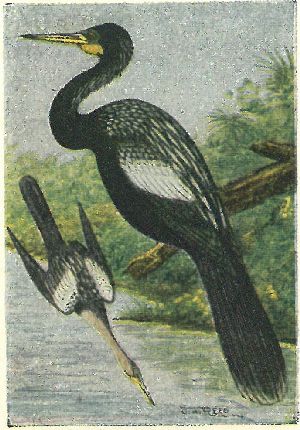
Adult male with a glossy greenish-black head, neck and underparts, the neck being covered behind, in breeding season, with numerous filamentous, whitish plumes. Female and young with neck and breast fawn color in front. Eyes red, face greenish and gular pouch orange. Middle tail feathers curiously crimped. These peculiar birds spend their lives within the recesses of swamps, the more dismal and impenetrable, the better. They perch on limbs overhanging the water and dive after fish, frogs, lizards, etc., that pass beneath, from which they get one of their names, American Darter. They swim with the body submerged, with only their serpent-like head and neck visible; hence they are called Snake-birds.
Nest.—Of sticks and leaves in bushes or trees over water, large colonies of them nesting in the same swamp. The 3 to 5 eggs are bluish, covered with a chalky deposit (2.25 × 1.35).
Range.—Breeds north to the Carolinas and Ill. Winters in Gulf States.

Largest of our cormorants; tail with 14 feathers. Adults with glossy black head, neck and underparts; in breeding season with white plumes on the neck and a white patch on the flanks. Young with throat and belly white, rest of underparts mixed brown with black. Cormorants feed chiefly upon fish which they pursue and catch under water. They were formerly extensively, and are now to a less extent, used by the Chinese to catch fish for them, a ring being placed around their neck to prevent their swallowing their prey.
Nest.—Made of seaweed and sticks on narrow ledges of rocky islets or sea cliffs, this species being entirely maritime. The four eggs are greenish-white, covered with a chalky deposit (2.50 × 1.40).
Range.—Breeds from Nova Scotia and Newfoundland north to Labrador and Greenland; winters south to the middle states.
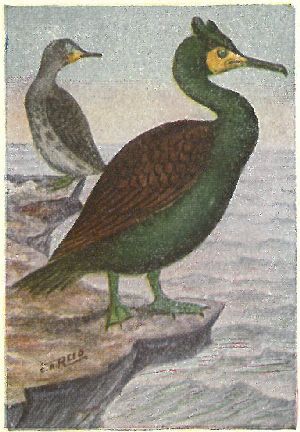
Tail with 12 feathers; distinguished from the last species in any plumage by the shape of the gular sac; on the common Cormorant the feathers on the throat extend forward to a point, making the hind end of the pouch heart-shaped, while in the present species it is convex. In breeding plumage, this species has a tuft of black feathers on either side of the head. The throat pouch is orange yellow; eyes green. These cormorants are found to some extent along the Atlantic coast, in summer, from Maine northward, but they are chiefly birds of the interior, being particularly abundant in Manitoba.
Nest.—On ledges on the coast, and on the ground in the interior, or in trees. The nests are made of sticks and weeds, shallow, shabby platforms holding 3 or 4 eggs. The eggs are bluish-green and chalky.
Range.—Breeds from Maine, on the coast, Minnesota northward; locally in North Carolina. Winters in the Gulf States. 120a., Fla. Cormorant, found in the South Atlantic and Gulf States, is smaller.
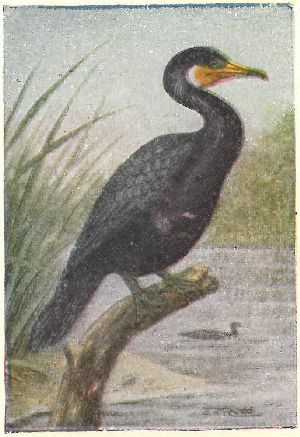
Adults with feathers bordering on the gular sac, white. In breeding plumage, the sides of head and neck have tufts of filmy white feathers, eyes green, as they are in all cormorants. All cormorants are expert swimmers and fishermen. They never plunge for their prey, but pursue and catch it under water, the same as do the grebes. When perching, they sit erect with their neck bent in the form of a letter S. They fly with their necks outstretched, and with rather slow wing beats. They are very gregarious and nest in large colonies, this species always being found in swamps or heavy shrubbery, surrounding bodies of water.
Nest.—Usually in trees overhanging the water, or upon the ground, in either case being made of sticks and weeds. The 3 to 5 eggs are bluish-green, covered with a chalky deposit (2.25 × 1.35).
Range.—Breeds north to the extreme southern boundary of the United States; wanders north casually to Ill. in summer.
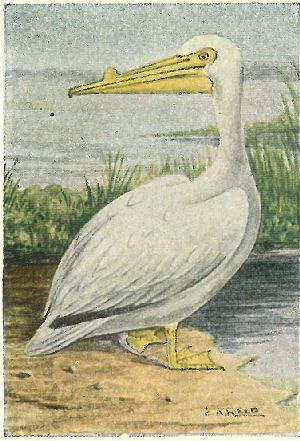
White with black primaries. Eye white; bill and feet yellow, the former in the breeding season being adorned with a thin upright knob about midway on the top of the upper mandible. The large pouch, with which pelicans are armed, is used as a dip net to secure their food, which consists of small fish. The White Pelican scoops up fish as he swims along the surface of the water; when he has his pouch partially filled, he tilts his head, contracts the pouch, thereby squeezing the water out of the sides of his mouth, and swallows his fish.
Nest.—Of sticks and weeds on the ground on islands or shores of inland lakes. They breed in colonies, and lay their eggs in June. The two or three eggs are pure white (3.45 × 2.30).
Range.—Breeds in the interior from Utah and Minn. northward. Winters on the Gulf coast and in Florida; rare on the Atlantic coast.

Pouch greenish; eye white; back of neck in breeding season, rich velvety brown; at other seasons the whole head is white. These pelicans nest abundantly on some of the islands on the Gulf coast of the U. S., on Pelican Island on the east coast of Florida, and sometimes on the coast of Georgia and South Carolina. Like the White Pelican, this species lives chiefly upon small fish, but they procure them in a different manner. They are continually circling about at a low elevation above the water and, upon sighting a school of fish, will plunge headfirst into it, securing as many as possible.
Nest.—Either on the ground or in low trees, in the latter case being more bulky than in the former; composed of sticks and weeds. The three to five eggs that they lay are pure white with the chalky covering common to eggs of birds belonging to this order.
Range.—Breeds on the Gulf coast, and on the South Atlantic, north to South Carolina; later may casually stray to New England; winters on the South Atlantic and Gulf coasts.
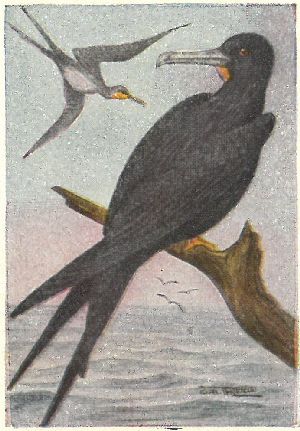
Eye brown; bill long, comparatively slender, and flesh, colored; gular sac orange; feet small and weak, with the four toes joined by webs. Frigate birds are strictly maritime; they nest in large colonies and usually travel in large companies. In expanse of wing compared to size of body they are unequalled by any other bird, and in power of flight they are only surpassed, possibly, by the albatrosses. They can walk only with difficulty and are very poor swimmers, owing to their small feet and long tail, but they are complete masters of the air and delight to soar at great heights. Their food of small fish is secured by plunging, or preying upon other sea birds.
Nest.—A low, frail platform of sticks in the tops of bushes or low trees. They lay but a single white egg in March or April; size 2.80 × 1.90.
Breeds in the Bahamas, West Indies, Lower California and possibly on some of the Florida Keys.
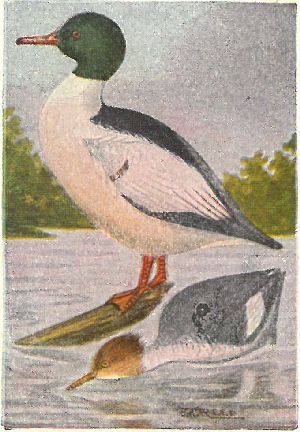
Bill, feet and eye red in male, the former with a black stripe along the top; plumage black and white, with a greenish-black head; no crest. Female gray and white, with brown head, crested; chin white; eye yellow. These birds have the bill long, not flattened, but edged with sharp teeth to grasp the fish, upon which they live to a great extent. They are exceptionally good swimmers for members of this family, and can chase and catch their fish, using their wings to aid their legs in propelling them through the water.
Nest.—In holes of trees, cavities among the rocks, or less often on the ground. The nest is made of leaves and grasses and lined with downy feathers from the breast of the female. The 6 to 9 eggs are creamy-buff (2.7 × 1.75); June.
Range.—Whole of North America. Breeds from New Brunswick, North Dakota and California, northward. Winters from the northern boundary of the U.S. south to the Gulf of Mexico.
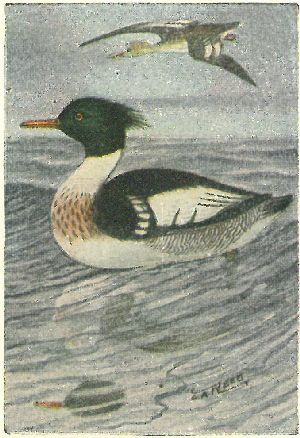
Eye, bill and feet red, like those of the last species, but the head is crested on the male, as well as the female, and a band across his breast is mixed rusty and black streaks. The female has not as brightly colored a head as the female of the American Merganser, and the throat is not pure white. They can be distinguished in any plumage, from the fact that the nostril is nearer the eye than it is the tip of the bill, while that of the last species is located midway between the eye and the tip of the bill. This is the species that is most often found in salt water. It is also found inland but not as commonly as the last.
Notes.—A low croak.
Nest.—On the ground, concealed in tufts of long grass or overhanging rocks. Their 5 to 10 eggs are olive buff in color (2.50 × 1.70); June, July.
Range.—Breeds from Maine and Ill., northward; winters throughout the United States.
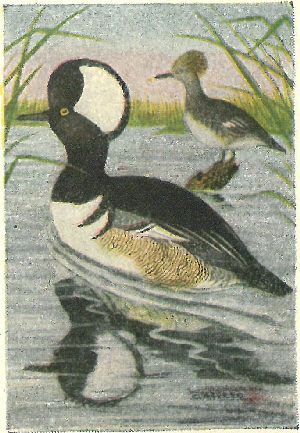
Bill short compared to those of other mergansers, and black. It is not apt to be mistaken for any other duck, because of its small size and the large crest with which both sexes are adorned, that of the male being black with a large, white patch, and that of the female plain brown.
The male has the power of raising or lowering his crest; when excited he will at times repeatedly open and shut it like a fan. When at a distance on the water, the male might possibly be mistaken for the Buffle-head, as that species also has white on the head, but its back also is largely white. Both male and female have yellow eyes.
Notes.—Low, muttered croakings.
Nest.—In holes of trees on the banks of, or near, streams or lakes. The bottom of the cavity is lined with grasses and down, and on this they lay 8 to 12 grayish white eggs (2.15 × 1.70); May, June.
Range.—Breeds locally throughout the U. S., but most abundantly north of our borders; winters in the South.

Male.—Head, green; speculum purplish-blue; bill olive-green; legs orange; eyes brown. The female most closely resembles the Black Duck but is lighter colored, more brownish, and the speculum, or wing patch, is always bordered with white. This species is one of the handsomest and most valuable of ducks. It is the cogener of the domestic ducks, and is largely used as a table bird.
Their food consists chiefly of mollusks and tender grasses. These they usually get in shallow water by “tipping up,” that is, reaching the bottom without going entirely under water. They also visit meadows and the edges of grain and rice fields for food.
Notes.—A nasal “quack,” often rapidly repeated when they are feeding.
Nest.—Of grass, lined with downy feathers, concealed in tufts of grass near the water’s edge. The 6 to 10 eggs are buffy or olive-greenish (2.25 × l.65).
Range.—Breeds from the northern tier of states northward; winters in southern half of the U.S.
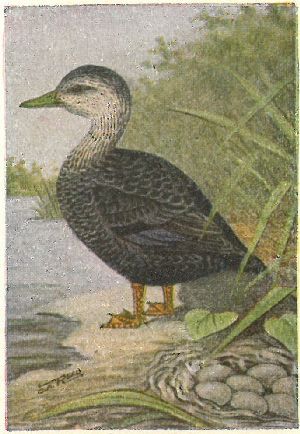
General plumage mottled blackish, the feathers having lighter edges; throat, buffy, streaked with blackish; crown and line through eye, nearly solid blackish; speculum bluish-purple, with no white; bill greenish-black; legs brownish. Black Ducks breed locally in pairs, throughout northern United States and southern Canada. This is the species most often seen in New England. When in flight, it can usually be recognized by the dark colored underparts and the white lining to the wings. Its habits are just like those of the Mallard, with which it is closely related.
Notes.—A “quack,” like that of the Mallard.
Nest.—Placed on the ground, not far distant from the water’s edge; made of grass and feathers; the 6 to 10 eggs are buff-colored (2.30 × 1.70); May, June.
Range.—Breeds locally from N. Y. and Iowa northward; winters south to the Gulf.
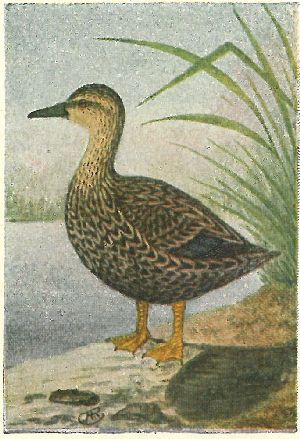
Much lighter than the Black Duck, all the feathers being broadly margined with buffy; throat nearly clear buffy without markings. The habits of this species, which is restricted to Florida and the Gulf coast to Louisiana, are the same as those of the northern Black Duck.
Notes.—Precisely like those of the Mallard.
Nest.—Of grass and down, on the ground, the eggs being like those of the Black Duck but averaging a trifle smaller (2.15 × 1.50); April.
Range.—Florida and the Gulf coast to La.; resident. 134a., Mottled Duck (A. f. maculosa), is very similar to the Florida species, but is mottled with black on the belly, instead of streaked. It is found on the coast of Texas and north to Kansas.
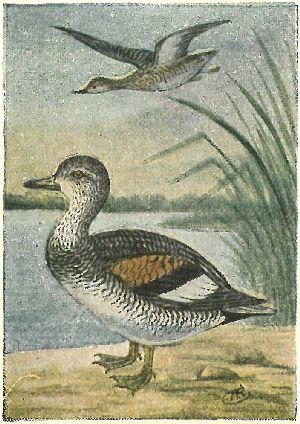
Male with chestnut wing coverts and white speculum; lining of wings white; eyes brown. The female is similar, but the back and wings are brownish-gray and the speculum gray and white. A rather rare migrant in New England, common in the Middle States and abundant west of the Mississippi. They are usually found in meadows and grain fields bordering marshes or lakes. As is usual with ducks, these do most of their feeding early in the morning or after dusk, and spend the greater part of the day in sleeping. They are of the most active and noisy of ducks, which accounts for their Latin name “streperus,” meaning noisy.
Notes.—A rapid, shrill quacking.
Nest.—Feather-lined hollows in the ground, concealed by patches of weeds or tall grass. Eggs 7 to 10, creamy buff color (2.10 × 1.60); May, June.
Range.—Northern Hemisphere; breeds in northern United States, except the eastern portion, and in Canada; winters along the South Atlantic and Gulf coasts.
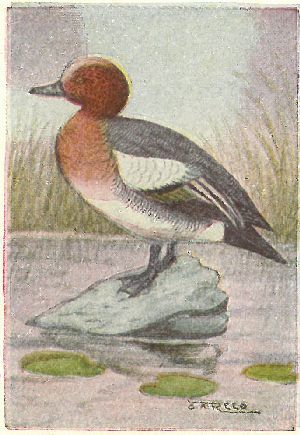
Crown buffy; head reddish brown; wing coverts white; speculum green. Female with blackish speculum, and a pale, rusty head, neck, breast and sides, streaked or barred with blackish. The Widgeon is an Old World duck that rarely, and accidentally, strays to our Atlantic or Pacific coasts. It breeds in America only in the Aleutian Islands. Its habits are the same as the next species, our American Widgeon.
In the Old World it is regarded as one of the best of table ducks. Its food consists of marine and freshwater insects, small shell-fish, seaweed and grass. Its nidification is just like that of the Baldpate.
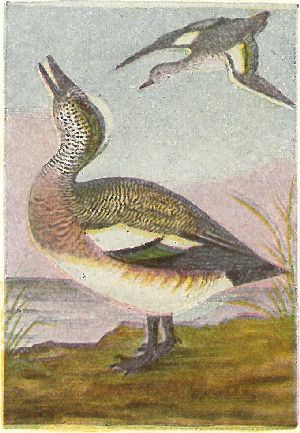
Wing coverts and top of head white; rest of head and neck finely specked with black; speculum and broad stripe back of eye, green; female, similar but with the whole head specked, and with no green on the ears. They can usually be identified at a distance by the absence of any dark areas, and when flying by the whiteness of the underparts. Baldpates are common and well known birds throughout North America, where they are called by a great variety of names, most of which refer to the bald appearance of the top of the head, owing to the white feathers. Their food consists of mollusks, insects, grain, and tender shoots of grass; their flesh is, consequently, very palatable and they are much sought as table birds.
Notes.—A shrill, clear whistle.
Nest.—Of grass, lined with feathers from the breast of the female; situated on the ground in tall grass near the water’s edge. 8 to 10 buff eggs (2.15 × 1.50); June.
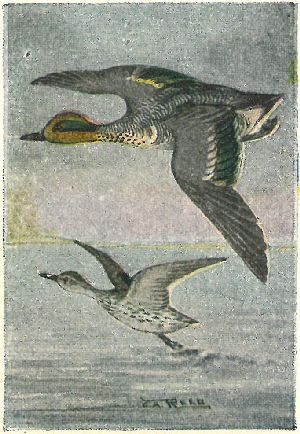
Head reddish-brown; speculum and large patch back of eye, green; a white crescent in front of wing. Female with the head and neck whitish, finely streaked with dusky; wings as in male. These ducks are abundant in most parts of the United States, but are rather uncommon in New England. They are usually seen in flocks of ten or a dozen, and often a single bird, or two or three, may be found with a flock of Mallards. They frequent ponds, marshes and rush-grown shores of creeks, rivers or lakes, feeding upon shellfish, insects, aquatic plants and seeds.
Notes.—Shrill, piping whistles, rapidly repeated.
Nest.—On the ground under the shelter of tall grass; it is made of weeds and grass, and lined with feathers. They lay from 5 to 9 eggs, buffy (1.85 × 1.25); May, June.
Range.—Breeds from the northern tier of states northward; winters from Va., Ill. and British Columbia, southward.

Male.—Head gray, with a white crescent in front of the eye; underparts buffy, heavily spotted with black; wing coverts blue; speculum green. Female similar to the female Green-winged Teal, but with blue wing coverts. Teal can easily be distinguished from other ducks by their small size; the present species can usually be separated from the last, by the darker underparts, the longer neck and smaller head. Their flight is very rapid; it probably appears to be more rapid than that of other ducks because of the much smaller size of the Teal. They usually fly in compact lines and when ready to alight, do so very precipitously.
Notes.—A weak, but rapidly uttered quacking.
Nest.—Made of weeds, placed in tall grass bordering marshes or ponds. 6 to 10 buffy eggs are laid during May or June (1.90 × 1.30).
Range.—Breeds from Maine, Ohio and Kansas northward; winters in the lower half of eastern United States.
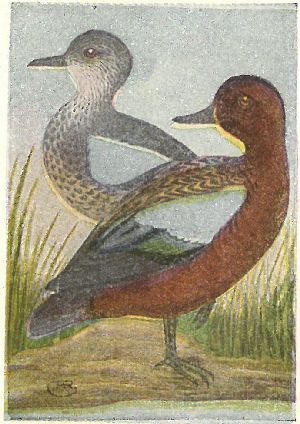
Male with the whole head, neck and underparts bright cinnamon; wings as in the Blue-winged species. Female similar to the female Blue-wing, but more rusty below, and the throat is tinted or quite dark, while that of the last species is usually light. These beautiful birds are very abundant west of the Rocky Mountains, but are of only casual or accidental occurrence east of the Mississippi Valley and sometimes Southern Florida. Their favorite nesting places are in fields of tall grass or clover, in close proximity to marshes or ponds.
Nest.—Compactly woven of grasses and lined with down; they lay from eight to as many as thirteen buffy white eggs, size 1.85 × 1.35; May, June.
Range.—Breeds in Western United States and British Columbia. Occurs rarely in the Mississippi Valley, Southern Texas and Florida.
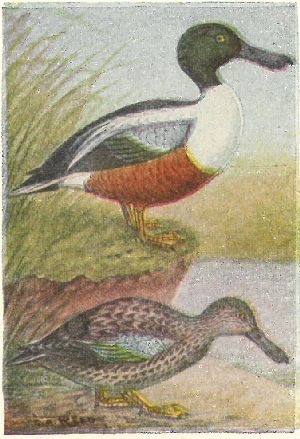
Bill long, and much broader at the tip than at the base; head and speculum green; belly reddish-brown; breast and back, white; wing coverts, pale blue; eye yellow; feet orange. Female with head, neck and underparts, brownish-yellow, specked or streaked with dusky; wings as in the male, but not as brightly colored. Easily recognized in any plumage by the large, broad bill. If it were not for this large and ungainly shaped bill, this species might be classed as one of our most beautiful ducks, when in full plumage, which is only during the breeding season; at other seasons the head of the male is largely mixed with blackish.
Nest.—Of fine grasses and weeds, lined with feathers; they lay 6 to 10 grayish eggs (2.10 × 1.50); May.
Range.—Whole of the northern hemisphere. Breeds in America, from Minnesota and Dakota northwards, and locally farther south; winters on the South Atlantic and Gulf coasts; rare during migrations on the North Atlantic coast.

Tail pointed, and, in the male, with the two central feathers considerably lengthened; neck unusually long and slender for a duck; form more slender than that of other ducks. Male with brownish head and stripe down back of neck; back and sides barred with black and white; speculum green, bordered with white or buff. Female mottled brownish, buffy and black, but to be known by the sharply pointed tail feathers and long neck; speculum brownish. These ducks are strong swimmers and good fliers, but poor divers; they get their food the same as does the Mallard by “tipping up,” their long neck enabling them to feed in comparatively deep water. They are quite timid and lurk in the tall grass of the marshes during the daytime, feeding chiefly after dark.
Notes.—Quacks like those of the Mallard.
Nest.—On the ground, and like that of other ducks, well lined with feathers; 6 to 12 eggs (2.20 × 1.50).
Range.—Breeds from Ill. and Iowa northward; winters in southern half of the U. S.
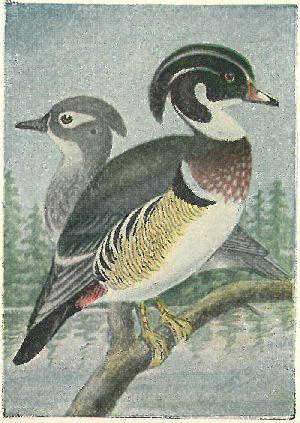
Head crested in both sexes, the feathers being especially lengthened on the nape. No other American duck that can possibly be mistaken for them. The male Wood Duck is the most beautiful of the family, in this or any other country, its only rival being the gaily colored Mandarin, of China. In summer, they may be found about the edges of clear ponds or lakes, especially those located in woods remote from human habitations. They are very local in their distribution and only one or two pairs will be found in a locality. In most parts of their range they are rapidly diminishing in numbers.
Notes.—A soft whistled “peet, peet” and a squawky danger-note like “hoo-eek, hoo-eek.”
Nest.—In the hollow of a tree usually near the water’s edge. The bottom is lined with soft downy feathers, and 8 to 15 buffy eggs are laid (2.00 × 1.50).
Range.—Whole of the United States and southern Canada, breeding locally throughout the range. Winters in southern half of the U. S.
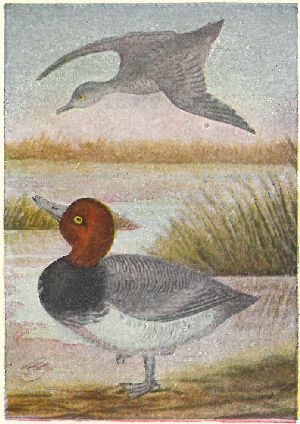
Note the shape of the bill of this species, as compared to that of the similarly colored Canvas-back. The male Redhead has a bluish bill with a black tip, and his back is much darker than that of the Canvas-back; eye yellow. The female has the throat white and the back plain grayish-brown, without bars. Redheads dive and swim with great agility; they feed largely upon water plants and mollusks which they get from the bottom of ponds, or along the seashore. They breed very abundantly in the sloughs of the prairies in the Northwest.
Notes.—A hollow, rapid croaking.
Nest.—Of grasses, lined with feathers, in marshes. Their 6 to 12 eggs are buffy white (2.40 × 1.70); May, June.
Range.—Breeds chiefly in the interior, from Minnesota and Dakota northward, and to a lesser degree north from Maine. Winters in southern part of the U. S.
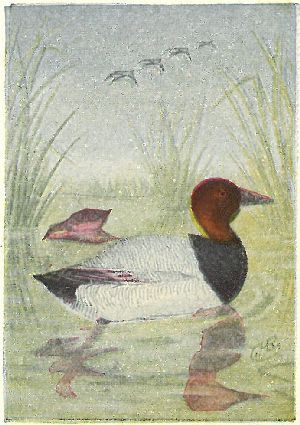
Differs from the Redhead in the shape of its black bill, its blackish forehead, very light back and red eyes. The female has the back grayish-brown, finely barred with black. Like the last species, Canvas-backs are excellent swimmers and divers, and can secure their food from a considerable depth. In winter they are found in great abundance on the Atlantic coast from Maryland southward, and are one of the most persistently hunted birds, for their flesh is much esteemed, and they have a high market value. They are seen in large flocks, and are difficult to approach, but are said to decoy as easily as any other.
Notes.—Harsh croaks, little different from those of the Redhead.
Nest.—On the ground in marshes or sloughs, the hollow being lined with grasses and feathers from the breast of the female; 6 to 10 eggs (2.40 × 1.70).
Range.—Breeds in the interior from Minnesota and Dakota northward; winters from Maryland and British Columbia southward. Rare in New England.
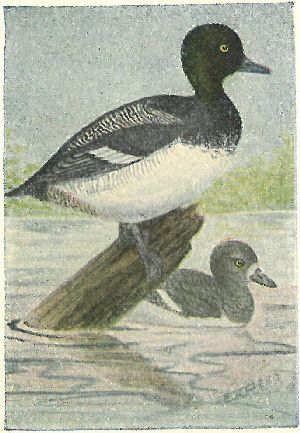
Head black, glossed with greenish; speculum white; bill dull bluish; eye yellow. Female resembles that of the Redhead, but has a white speculum. These ducks are perhaps better known as Blue-bills, than as Scaup Ducks. They are one of the most abundant migrants on the Atlantic coast, and are one of the most active of the family, diving at the flash of a gun.
Notes.—A peculiar grunting quack.
Nest.—Of grass and feathers on the ground in marshes.
Range.—Breeds from Minnesota and Dakota northward. Winters south of New England.
Slightly smaller than the last, and with the head of the male glossed purple instead of green.
Range.—Breeding range same as that of the last; winters in the southern half of the U. S.
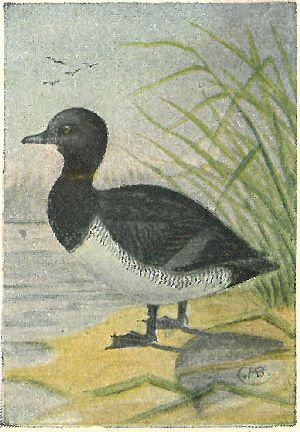
Male with a narrow chestnut neck ring; head glossed with purple; back black; chin white; bill blackish, with a bluish band near the end; eye yellow. Female with white cheeks, eye ring and region about the base of the bill; otherwise similar to the female of the Redhead, but smaller.
These ducks are usually met in flocks of from one to three dozen, the same as the preceding two black-headed ducks. Their flight is very rapid, and they are equally agile when in the water. They are seen on the Atlantic coast only in winter, and remain just as far north as the water remains open.
Notes.—A low grunting “quanck.”
Nest.—Of grasses and feathers in marshes and on bogs. The 6 to 10 eggs are grayish-white (2.25 × 1.60); June.
Range.—Breeds in the interior of Minnesota northwards; winters throughout the United States.
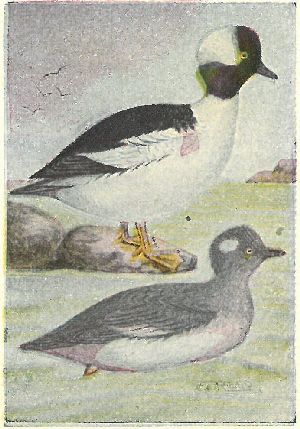
Head iridescent with green, purple and blue, and with a large white patch extending from eye to eye, across the back of the puffy crest. Female with a white patch on either side of her brownish head; speculum white. They are known by a great variety of names such as “Butter Ball,” “Spirit Duck,” “Dipper,” etc., the majority of which refer to the celerity with which they can disappear under the water. They are always on the alert and will dive at the flash of a gun. They are able to continue incessant diving for a long period and can remain under water for a long time. Their flight is very rapid, and when alighting in the water they make considerable splash, but can take wing from it easier than the majority of ducks.
Notes.—A single guttural croak.
Nest.—In hollow trees; eggs greenish gray (2.00 × 1.40); June.
Range.—Breeds from the northern boundary of the U. S. northward; winters throughout the U. S.
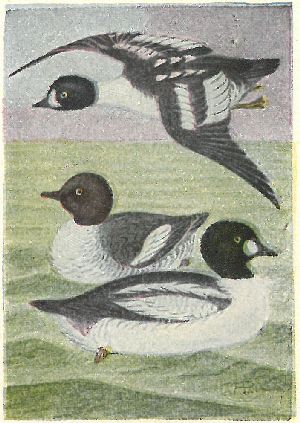
Head puffy, or slightly crested. Male with greenish head and a round white spot between bill and eye. Female with a brownish head and white speculum.
Notes.—A hoarse croak, rarely uttered.
Nest.—In cavities of hollow trees near ponds or on the banks of streams. 6 to 10 grayish green eggs (2.30 × 1.70); June.
Range.—Breeds from the northern parts of the northern tier of states, northward; winters throughout the U. S.
Head bluish with a white crescent at base of bill; eye bright yellow in both this and the last species; female practically indistinguishable from the preceding, although the bill of the present species is shorter and comparatively higher at the base.
Range.—Breeds from Northern U. S. north to Labrador and Alaska, and in the Rockies, south to Colorado; winters in the northern half of the U. S.
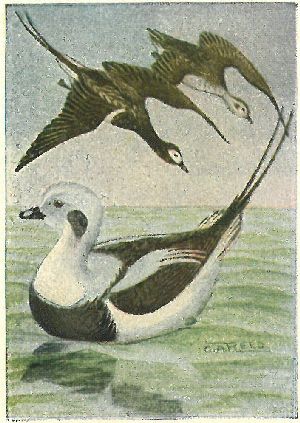
This species is one of the very few ducks that change their plumages in summer and winter. The female is marked similarly to the male but is very much duller colored, and lacks the long tail feathers with which the male is adorned. They are sea ducks and, while they are usually found to some extent on some of the larger lakes or ponds, during migrations, they are very abundant on the Atlantic coast. They are excellent swimmers and dive to great depths in search of food. It is said (Nelson) that in their summer home, during the mating season, they frequently dive under the water from the air, a habit that none of the other ducks, except rarely the Pintail, indulge in.
Notes.—A confused, but rather musical gabbling.
Nest.—On the ground near water; thickly lined with downy feathers; eggs laid in June.
Range.—Breeds from Labrador and Alaska northward; winters south to Long Island Sound and the upper Mississippi Valley.
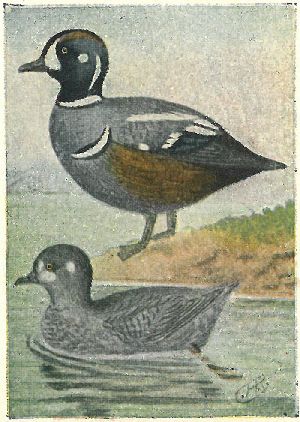
Male very oddly and handsomely marked, as shown; female blackish-brown, lighter below and with a whitish spot before and one behind each eye. During the winter, they are seen in flocks off the coast, from Maine and sometimes from Long Island Sound northward. In summer, they are usually found only in pairs along rivers or creeks, and in the Rocky Mountains they frequent the turbulent streams that are the homes of the Water Ouzel. When swimming, Harlequins sit high in the water, but they are able to get under the surface with the greatest of speed.
Notes.—A rapidly uttered, clattering whistle.
Nest.—On the ground, in crevices under rocks, the hollow being well lined with down; also said to nest in hollow trees; their 5 to 8 eggs are greenish-buff and measure 2.30 × 1.60; June.
Range.—Breeds from New Brunswick north and northwest to Alaska and the Arctic Ocean, and south in the Rockies to Colorado; winters south to the Middle States and Calif.
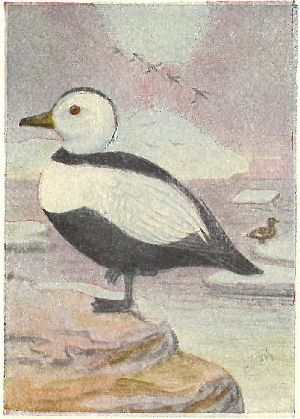
Male with the head, breast and wings, white; narrow stripe over the top of the head and down the back of the neck, ring around the neck, back, primaries and entire underparts, black. Female mottled brownish-gray and blackish, with white speculum.
Labrador Ducks were never very abundant within the memory of any living person, but they were occasionally shot and were found sometimes in the New York markets. At that time little heed was paid to them and they became extinct before anyone realized the fact. Their record has been traced down to 1875, since which time none have been taken. As far as known there are but 38 or 40 of them preserved. They were formerly found from Long Island Sound north to Labrador.
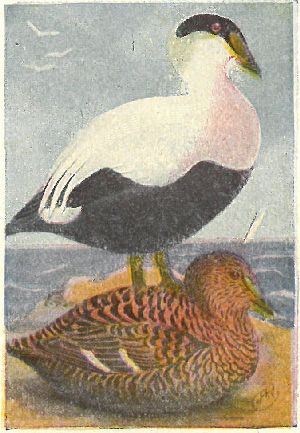
Base of bill extends on either side of forehead in a point, a mark that will distinguish it from the next and very similar species, in any plumage. The female Eider presents a most remarkable difference in plumage from that of the male, and, unlike the females of most species, is a very handsome bird.
Nest.—Of grasses lined with down; concealed in tall grass or under bushes; the 6 to 10 eggs are greenish-drab (3.00 × 2.00); May, June.
Range.—Breeds on Labrador and Greenland coasts.
This is the Eider that is usually seen on the Atlantic coast and is the only one that breeds south of Labrador. The base of the bill, that encroaches on either side of the forehead is rounded, and broader than that of the last. They nest from Maine (rarely) northward, and winter south to Long Island.

The feathers of the sides of the bill of this species do not reach to the nostril, while in the two preceding ones, they do. This is the chief point of difference in distinguishing the females, which very closely resemble each other. Adult males, as can be seen, are very different from the other Eiders. As is usual with the Eiders, the male of this species moults to a plumage resembling that of the female, during the late summer, when he has shed his wing feathers and is, for a period flightless. This is a part of Nature’s plan to give her feathered children protection when they most need it. While the females are sitting upon the eggs, they are deserted by the males, which congregate in large flocks, and drift aimlessly about until joined by the females in Fall.
Nest.—A depression in the ground, lined with feathers. Eggs like those of the last species.
Range.—Breeds from northern Labrador and the Aleutian Islands, Alaska, northward; winters south to Maine and casually to Long Island Sound.
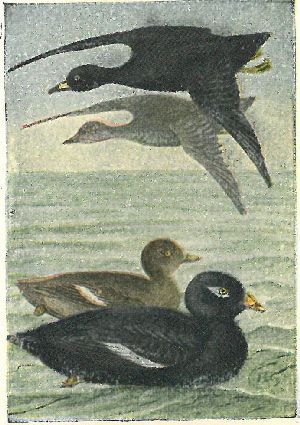
Adult male, entirely black; bill black with enlarged base yellow; eye brown. Female plain brownish-black, lighter below. All the Scoters are better known to sportsmen as “coots,” this species being the Butter-billed Coot, while the female is the Gray Coot.
Notes.—A long musical whistle. (Elliott).
Nest.—On the ground usually well concealed. Their 6 to 10 eggs are a creamy buff color (2.50 × 1.70).
Range.—Breeds from Labrador northward. Winters south to the Middle States and Lake States.
This species is the most abundant of the Scoters wintering off the New England coast, where they congregate in immense “rafts,” floating off shore.
Nest.—Concealed in long grass, lined with feathers; 5 to 8 buffy eggs (2.75 × 1.85); June.
Range.—Breeds from North Dakota and Newfoundland northward; winters in the northern half of U. S.
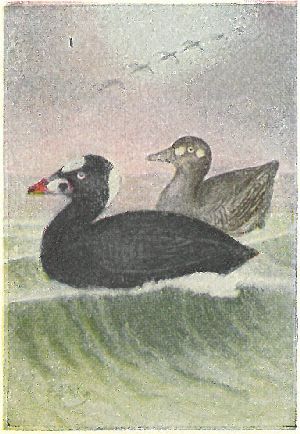
Male black with a white patch on top of the head and another on the nape; eye white; bill red, white and yellow, with a large black spot near the base. Female a uniform grayish brown, lighter below, with a whitish patch in front of each eye; young birds are like the female but also have a white patch back of the eye. That they are very abundant is apparent from the size of a single flock seen by Nelson about 10 miles out to sea from St. Michaels, Alaska; it formed a continuous band for about 10 miles in length and from a half to three-quarters of a mile in width. All the “Coots” have heavy bodies, making it rather difficult for them to rise from the water, along which they run for a few yards before springing into the air.
Nest.—A feather lined hollow on the ground, like that of other ducks; eggs creamy buff (2.40 × 1.70).
Range.—Breeds from Newfoundland, Manitoba, and British Columbia northward; winters south to Virginia, Ohio and California.
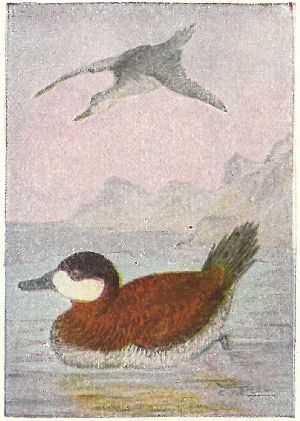
Bill short, broad, with an upturned appearance; tail feathers very narrow, stiff and pointed. Male in summer, with black crown, whitish cheeks, throat and belly, and reddish-brown back, breast and sides. In winter, the cheeks are duller colored and the back mixed with grayish. Female with crown, back and sides grayish; cheeks showing traces of white as on the male. These ducks are very sprightly, either in the water, on land, or a-wing. Their flight is very rapid, their stiff, short wings producing a buzzing sound that gives them the local name of Bumble Bee Coot. They have a great variety of names referring to some character of their form, such as Broad-bill Dipper, Bull-neck, Bristle-tail, etc.
Nest.—Of grasses or rushes, lined with down, placed in tall grass near the water or in clumps of rushes growing out of the water; 6 to 12 grayish eggs (2.40 × 1.75), very large for the size of the bird; June.
Range.—Breeds in the interior of northern U. S. and in Canada; winters in southern United States.
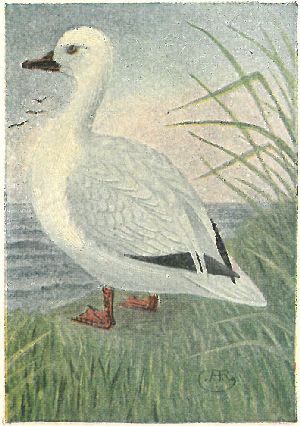
Plumage entirely white; ends of primaries black; top and back of head sometimes tinged with rusty; bill and feet red; eye brown. This variety is like the next, which is the bird commonly seen in the East, although the Lesser Goose is found east to the Mississippi Valley.
Snow Geese travel in large flocks, the same as do the Canada Geese, led by an old male that has traveled the airy road many times before. At times, flocks are seen on the prairies, so large that they give the ground the appearance of being covered with snow. They are very wary and will all take flight at the first alarm.
Notes.—Usually silent, but they sometimes “honk.”
Nest.—Of grasses, sometimes, but not always, lined with down; 5 to 8 buffy white eggs (3.40 × 2.40); June.
Range.—Breeds in the Arctic regions; winters on the South Atlantic coast.
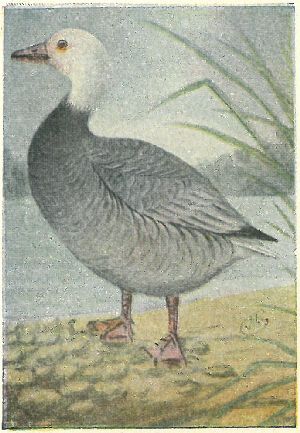
Head and neck white, often tinged with rusty on the face; underparts brownish-gray. Young birds are similar but the head is brownish; bill and feet reddish; eye brown. This handsome goose is found only in the interior, but a few accidental birds have been taken on the Atlantic and two on the Pacific coasts. While it is not an abundant species, flocks of twenty or thirty are often seen in the Mississippi Valley. They are sometimes seen with Snow Geese, but for the most part keep by themselves. On their march to their breeding grounds they branch off from the routes chosen by the Snow Geese, and turn to the eastward, breeding east of Hudson Bay, while the white geese are found chiefly to the westward.
Nest.—A grass-lined depression on the ground; eggs deep buff color (2.50 × 1.75); June.
Range.—Breeds in the Hudson Bay region and in Labrador; winters on the west coast of the Gulf of Mexico, migrating through the Mississippi Valley.

Forehead, white; head and neck gray; underparts mixed black and white; feet yellow; bill pinkish; eye brown. These geese reach the U. S. on their return from the Arctic regions about the first of October; they are very abundant on the Pacific coast and fairly common in the Mississippi Valley, but are rare on the Atlantic coast. They are very noisy birds and in some sections of the country are known as Laughing Geese. From being shot at so frequently, they are very wild and difficult to approach, sentinels being stationed to give alarm if danger approaches, when they are feeding.
Notes.—A confused honking, likened to laughter.
Nest.—Of grasses on the ground, usually in marshes; nearly always lined with down from the breast of the female. The four to nine eggs are buffy (3.00 × 2.05); May, June.
Range.—Breeds in the Arctic regions, chiefly west of Hudson Bay; winters south to the Gulf coast and Calif.; rare on the Atlantic coast.
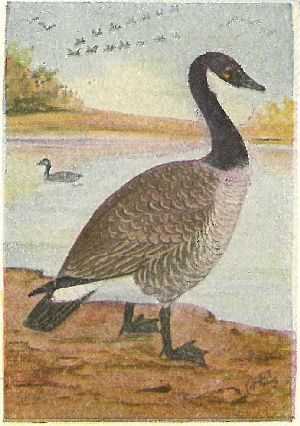
The best known and most widely distributed of our geese. In the northern states they are always eagerly looked for in the Spring, for their arrival is a sure indication that the backbone of Winter has broken. Their familiar honking is heard long before the thin, wavering, black, V-shaped line appears on the horizon; as it draws nearer, the volume of sound increases, resembling the baying of a pack of hounds, and at last, the flock sweeps overhead with deafening cries; large birds, with long necks fully outstretched, wings beating the air in unison, and all following the leadership of one bird in their journey over their invisible path.
Nest.—Of grasses and feathers, on marshes or near ponds; 4 to 9 buffy drab eggs (3.50 × 2.50); May, June.
Range.—Breeds from Labrador, Dakota, and British Columbia northward; winters in Southern U. S. 172a. Hutchins Goose (B. c. hutchinsii) is smaller (31 in.) and found in Western N. A., casually east of the Miss. 172c. Cackling Goose (B. c. minima) is still smaller (24 in.); is found in the same range.
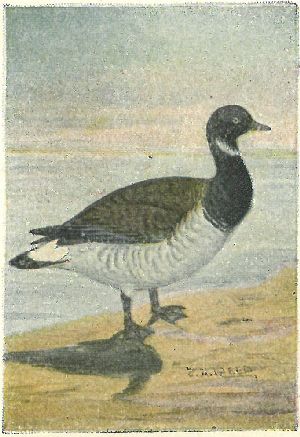
Head, back and breast black, sharply defined against the grayish-white of the underparts; a whitish patch on either side of the neck. They are very abundant on the Atlantic coast in winter, and when not too persistently hunted are unsuspicious; they do not fly in regular formation like the Canada geese, nor do they appear to have any special leader. They are inquisitive and easily decoyed, and consequently large numbers of them are shot annually. They are noisy, their notes being a peculiar, guttural “car-r-r-rup” or “r-r-rup,” and when in the presence of a large flock, the sound is deafening. (Elliott).
They feed upon tender water plants and roots, which they get from the bottom by tipping up, and not by diving.
Nest.—A depression in the ground, lined with grass and feathers; eggs grayish-buff (2.80 × 1.75); June.
Range.—Breeds in the Arctic regions; winters on the Atlantic coast and less often in the Mississippi Valley, from Mass. and Ill. southward.
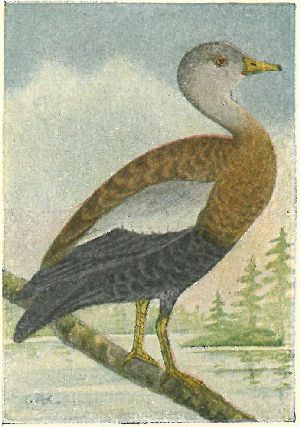
Legs and neck long; bill and feet pinkish; eye brown; head and neck chiefly gray; breast and back brownish; belly and under tail coverts, black; wing-coverts white and gray. These peculiar shaped ducks are not rare in certain localities along the Rio Grande in Southern Texas, and are abundant in Mexico and Central America. They are not timid and are frequently caught and domesticated. They can walk and run gracefully, and often feed in grain fields at considerable distance from water; they also eat shoots and seeds of aquatic plants. Like the Wood Duck, they nest in hollow trees, often at some distance from water, and, as soon as the young appear, help them to the ground and lead them to the water.
Notes.—A loud, shrill whistle.
Nest.—Usually lined with down, in cavities of hollow trees; the 6 to 15 eggs are pure white (2.05 × 1.50); May.
Range.—Found in the United States only in the Southern part of Texas.
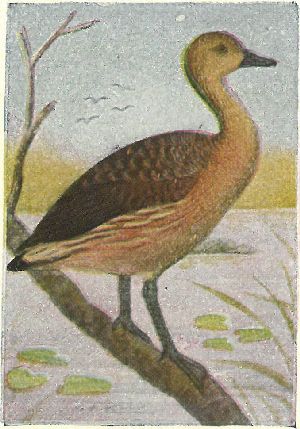
Form like that of the last, but with the head, neck, rump and underparts rusty, and with no white in the wings. The Fulvous Duck is much more abundant in the United States than the Black-bellied, and is casually found as far north as Kansas and Nevada, while it is regularly found in Texas and Louisiana, where it is known as the Long-legged Duck. Owing to the nature of its diet, which consists chiefly of grain, roots and water plants, the flesh of this bird is esteemed as an article of food, and many are killed for such. When wounded, they are said to be difficult to capture, owing to the speed at which they can run; they also swim and dive well.
Nest.—Located in the hollow of a tree, the bottom of the cavity usually being lined with feathers. They lay from ten to fifteen pure white eggs, and as many as thirty-two have been found in one nest, but these were probably laid by two or more females; May.
Range.—Texas and Louisiana, and north casually to Kansas and Nevada. Winters in Mexico.
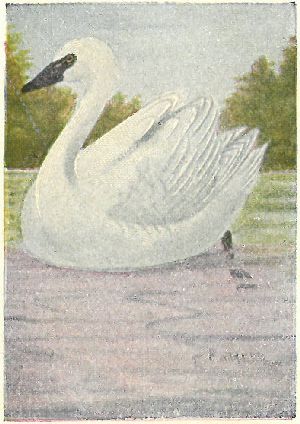
Nostril situated at a greater distance from the eye than it is from the end of the bill; a small yellow spot on the bare space in front of the eye; plumage entirely white; bill and legs black. This is the swan that is found on the Atlantic coast, and is most abundant in the Miss. Valley. It is rare north of Chesapeake Bay, but it is abundant from there southward, in winter. They make a beautiful sight against the blue sky, their immense white wings slowly fanning the air and their long necks extended.
Notes.—A peculiar, flageolet-like “Who, who, who.” (Elliott).
Nest.—A mass of weeds, grass and feathers on the ground; 3 to 6 greenish buff eggs (4.00 × 2.75).
Range.—Breeds within the Arctic Circle; winters south to the Gulf of Mexico; rare north of Va. on the Atlantic. 181. TRUMPETER SWAN (Olor bucinator) is larger (65 in.) and is found west of the Miss. It breeds from Ia., northwards. Nostril midway between eye and tip of bill.
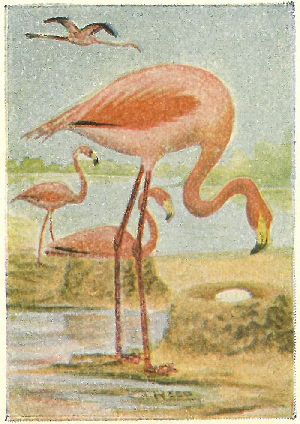
These large, beautiful birds are found in Southern Florida, and casually north to South Carolina, but it is doubtful if they breed within our limits. They fly with their long neck fully extended and legs trailing behind, a remarkable sight when a flock of several thousand is seen in flight. In 1904, Mr. F. M. Chapman visited a large breeding colony in the Bahamas, photographing the birds in every conceivable position. Their nests are mud-built structures, about a foot high, placed close together in the marshy interior of low lying islands, or on sandbars. The top is slightly hollowed out to receive the single egg (3.40 × 2.15), which is covered with a chalky deposit. They sit astride the nest with their legs doubled under them.
Notes.—A honking like that of Canada Geese.
Range.—Resident in the Bahamas and West Indies; north to Florida.
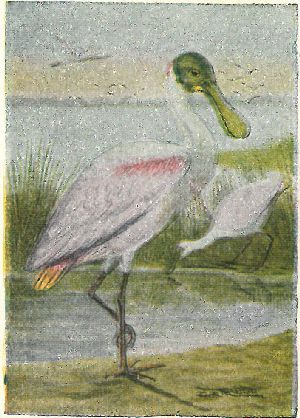
Head entirely bald in adults, and only feathered to the eyes in young birds; bill long, thin, flat and very much broadened at the end, variously colored with green, blue and orange; eyes and legs red. Young birds, without the bright carmine shoulders or saffron tail of the adults. These peculiar but handsomely tinted birds were formerly abundant in Florida and in the adjoining states, but so many have been killed for their feathers, that they are now rare and confined to the most inaccessible swamps of Southern Florida. Spoonbills travel and nest in communities; their flight is strong and Heron-like, but they carry their neck fully extended, their ample wings slowly beating the air.
Nest.—A frail structure of sticks, in mangroves or low trees; 3 or 4 pale, greenish blue eggs splashed with brown (2.50 × 1.70); May, June.
Range.—Florida and the Gulf States, and Southern Texas.

Tips of primaries black; plumage, otherwise, entirely white; bill, face and legs, orange red or carmine. Young with head and neck, and more or less of the body, brownish or streaked with brown. White Ibises are very abundant in the South Atlantic and Gulf States, breeding in immense rookeries in remote swamps, placing their frail platforms in bushes over the water or sometimes weaving nests out of rushes, attached to upright canes and brake. These rookeries are very untidy and offensive to human beings, and millions and millions of black flies and mosquitoes will be encountered by any who wish to investigate the breeding places of these birds.
Notes.—A loud, harsh croak.
Nest.—Of twigs in bushes, or of rushes in the tangle and brake of marshes; 3 or 4 whitish eggs, handsomely spotted and splashed with brownish.
Range.—Breeds north to South Carolina and Southern Ill. Winters from the Gulf States southward.

This beautiful species is wholly bright scarlet, except for the black primaries; young birds are found in all stages of plumage from the brownish-gray and white of the first year birds, to the full plumage of the adults.
This is a tropical ibis that abounds in northern South America, but is yearly decreasing in numbers, owing to the persistency with which they are hunted, their feathers being much in demand for tying trout flies, as well as for decorating hats, a barbarous practice that is being stopped in this country, by legislation and public sentiment.
Nest.—In rushes or mangroves like that of the last species; the eggs are the same size but average brighter in color (2.25 × 1.60).
Range.—Northern South America, casually north to the Gulf States, but has not been reported for years in our country.

Like the next, which is our common species, but with the feathers about the face not white, as in that species.
Range.—Tropical America, casually north to southeastern United States.
Bill, face and legs, carmine red; feathers bordering the face, white; wings and tail glossy greenish-black; rest of plumage rich chestnut-brown, glossed with purple on the head. They nest by thousands in extensive swamps, in company with herons.
Nest.—Strongly and compactly woven of dead rushes attached to living stalks, well cupped, thus differing from that of any of the herons; eggs plain greenish blue (1.95 × 1.35); deeper and brighter than those of any of the herons.
Range.—Texas, New Mexico, Ariz., Calif., and southward.
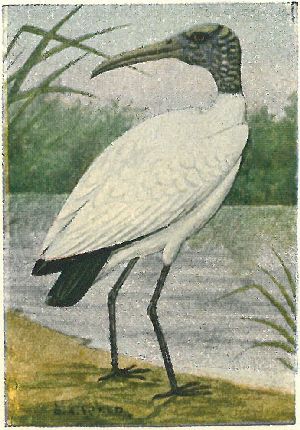
Entire head unfeathered and covered with scales; both head and legs are pale bluish in color; eye brown; plumage entirely white except for the glossy purplish-black primaries and tail. This large bird is a true stork and is very similar to the common European Stork. The name ibis was incorrectly and unfortunately applied to this species, and tends to confusion. Its flight is very easy and graceful, accomplished with a slow flapping of the wings, alternated at short intervals with long sails. At times they mount high in the air and circle about like hawks or vultures.
Notes.—Loud, hoarse croaks.
Nest.—A shallow platform of sticks in bushes or at low elevations in trees, usually over the water, the birds swarming in the most inaccessible swamps. Their 3 or 4 eggs are white and granular.
Range.—Breeds in the Gulf States and north to South Carolina; later may stray north to New York.

Much variegated with brown and yellowish-brown; adults with a long, broad, black stripe on either side of the white throat; eye yellow; legs and base of bill greenish-yellow. Bitterns have a great many local names, most of which refer to the peculiar pumping noise that the male makes during the mating season. Perhaps the most common of these is “Stake-driver.” Bitterns are found in bogs or marshes; they remain concealed by the tall grass until any intruder is very near, before they take flight.
Notes.—A squawk of alarm; song a hollow “punker-lunk.”
Nest.—A grass-lined hollow in tufts of grass or turf, in the middle of bogs or marshes. 3 or 4 plain brownish eggs, measuring 1.95 × 1.50. But one or two pairs nest in a locality; May, June.
Range.—Breeds in the northern half of the United States and Southern Canada; winters in southern half of the United States.

Male with the crown and back glossy black; female with these areas hair-brown, and streaked with brown below. These diminutive little bitterns are very shy and retiring, and seldom seen away from the reed grown marshes or ponds that they frequent.
Notes.—A hoarse croak, and a softly repeated “coo.”
Nest.—A platform of dead rushes twisted about the living stalks. The 3 or 4 eggs are pale bluish white. (1.2 × .9); May, June.
Range.—Breeds from the Gulf States, locally to Southern Canada; winters from the Gulf States southward.
This extremely rare little bittern is of the same size and form as the common species. The crown, back, wing-feathers and tail are black, and the rest of the plumage is more or less intense chestnut brown. The majority of specimens have been taken in Florida and Ontario, with one each from Michigan and Massachusetts. There are about twenty of them known to be preserved.
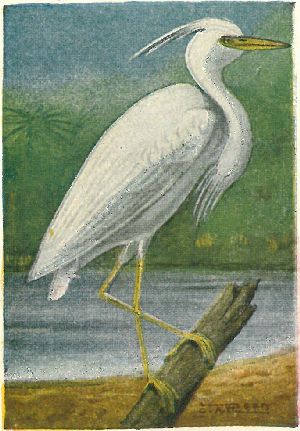
This is the largest heron that we get in North America, surpassing even the Great Blue. Its plumage is entirely white; no “aigrettes” on the back, but two white plumes on the back of the head and the feathers of the breast much lengthened, the same as in adult Blue Herons; bill, eyes and legs yellow. A gray phase of this heron, or a hybrid between it and the Great Blue Heron, is occasionally found in Southern Florida; it is similar to the Blue Heron, but paler and with the head and neck white.
Nest.—A large platform of sticks placed in the tops of mangroves. Their three or four eggs are not distinguishable from those of the next species; June.
Range.—Said to be not uncommon on some of the Florida Keys.
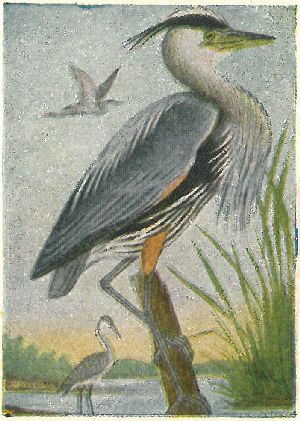
Adult Blue Herons are very handsome birds, as may be seen in the illustration. Young birds, and nine out of ten that we see will be young birds, are much duller colored and have no plumes. It takes several years for them to attain their perfect plumage. Their nests are placed in the tops of the tallest trees and are, consequently, difficult to get at. In some heronries, trees have been found containing as many as 40 nests. In flight, herons always carry their head drawn in against the shoulders, the neck being curved below.
Nest.—A platform of sticks in tall trees in wet woods. 3 or 4 pale greenish-blue eggs (2.50 × 1.50); May, June.
Range.—Breeds locally throughout the United States and Canada, either in colonies, or single pairs where they are persecuted as in New England; winters in Southern U.S. 149b. Ward Heron (A. h. wardi) is similar but lighter below and the neck is darker and browner; it abounds in Florida.
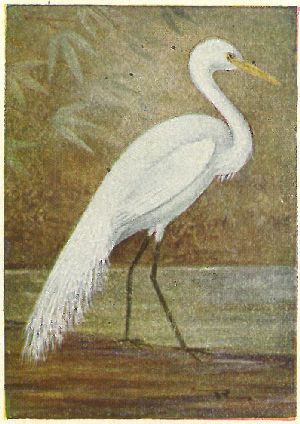
Entirely white, with no plumes on the head but with a long train of straight “aigrette” plumes growing from the middle of the back; bill and eye, yellow; legs and feet, black. Young and adults in winter, without plumes. The hand of man, to gratify the desire of woman, has ruthlessly slaughtered thousands upon thousands of these exquisitely beautiful birds; in Florida where they were abundant a few years ago, only stragglers are seen. A few of these heronries are yet left, either because they are in wildernesses where man has not yet penetrated, or are strongly protected by the humane owners of the land. It is only at the breeding places that they can be killed in numbers, as at other times they are shy; and it is only during nesting season that they wear their beautiful plumes.
Nest.—A frail platform of sticks, at low elevations, in bushes usually over water in swamps. Eggs, 3 or 4 in number, plain bluish green (2.25 × 1.45); April to June.
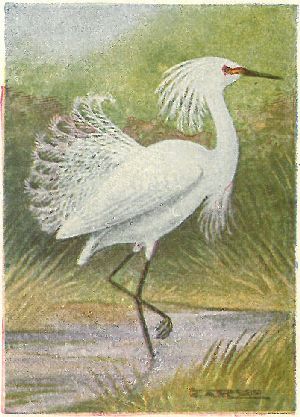
Plumage white; in breeding season with numerous recurved plumes growing from the middle of the back; long crest of plumes on the back of the head, and on the breast. Bill black, greenish at the base and about the eyes; legs black; feet yellow. This species is the most beautiful of the Egrets and consequently is the one that has suffered most from “plume hunters.” Although they are now protected wherever they can be, their ranks have been so decimated that extermination is threatened within a few years; the demand for their plumes is still so great that lawless men will commit murder to obtain them (Warden Bradley having been shot in 1905, while preventing the destruction of herons in Southern Florida).
Nest.—In swamps, in company with other small herons, the nests being frail platforms of twigs on branches of trees. Eggs pale greenish-blue.
Range.—Breeding range formerly coincident with that of the last, but now very rare.
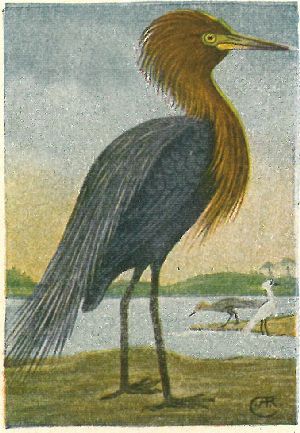
Two color phases, the gray being the most common:—Head and neck, including plumes on neck and breast, reddish-brown; rest of plumage gray, the plumes on the back being lightest; feet blue-black; bill yellowish at the base and black at the tip. In the white phase, the plumage is entirely, or nearly, white, including the plumes. As usual, these egrets associate in large flocks, of their own kind or other small herons. Their food consists of small fish, frogs, lizards, insects and mice. They will stand motionless in shallow water, for a long time waiting for their prey, and woe to the creature that comes within striking distance of their spear-like bill. Their flight is strong and graceful as they make their way from their breeding places to their feeding grounds on the mud flats, left bare by the receding tide.
Nest.—Like that of other herons; eggs slightly more greenish blue than those of the other egrets (1.9 × 1.45); May, June.
Range.—Breeds in the Gulf coast states, and north to South Carolina.
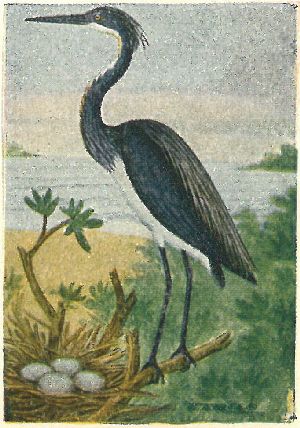
In breeding plumage, with short plumes on the back, extending three or four inches beyond the tips of the wings. Throat, front line of neck, and underparts white; head and neck reddish-purple; back and wings slaty; crest whitish; bill and legs dark; eyes red. A very abundant species throughout the year, on the Gulf coast of the United States. Their bearing is one of self-esteem and their walk slow and stately; they are often called “Lady of the Waters,” because of the imposing picture that they make. They are very sociable, rarely quarrel among themselves, and are usually found in company with Little Blue Herons and Egrets.
Nest.—They nest in communities in mangroves in southern Florida and in swamps, in company with many other species, in the northern portions of their range. Their nesting habits and eggs are the same as those of the Snowy Heron.
Range.—Breeds and is resident in the South Atlantic and Gulf States.
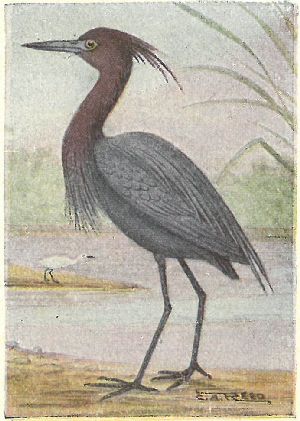
Head and neck, maroon; rest of plumage slaty-blue; plumes on back of head, breast and on the back; eyes yellow; bill and feet greenish. Young birds are white, usually with a tinge of bluish on the forehead and ends of the wings. They can be distinguished from the similar Snowy Herons by the greenish-black legs, while the legs of the latter are black with yellow feet. These little herons are resident and most abundant in the South Atlantic and Gulf States. They are at home in and enjoy the rankest and most impenetrable swamps, where only birds or reptiles can tread with safety. Yet herons are an interesting group and, in their own way, perform useful service to mankind by destroying quantities of reptiles, insects and mice.
Nest.—The nesting habits and eggs of this species are the same as those of the little Snowy Heron and the eggs cannot be distinguished with certainty.
Range.—Breeds north to Virginia and Illinois; later may stray north to New England.
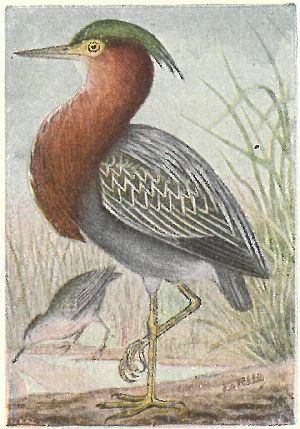
Smallest of the family, except the Least Bittern. In breeding plumage, they are one of the most beautiful of herons. They may be found in marshes, along creeks or about the edges of shallow ponds or lakes. They are often seen sitting upon a partly submerged log sunning themselves, or waiting for a tempting frog or fish to pass within reach. When they are among rushes, they will usually attempt to escape observation by mimicking their surroundings, and they do so very successfully. When they are alarmed and take flight they utter a single sharp shriek. At other times they utter a series of hollow screams, “qu-ick, qu-ick,” and also a hollow croak.
Nest.—In bushes, in communities or in company with other species in the south, but usually a few pairs nest in a locality in the northern states and Canada. Eggs pale bluish-green (1.45 × 1.10).
Range.—Breeds from the Gulf to Manitoba and Nova Scotia; winters in the Gulf States.
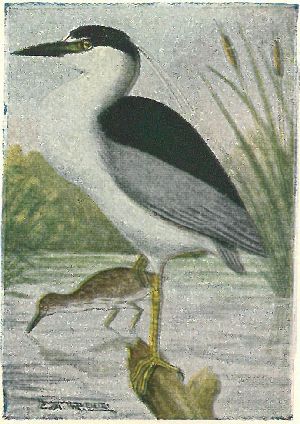
Bill much heavier than that of the herons; neck and legs shorter and stouter; eye red; bill black; legs and bare space in front of eye, pale yellowish-green. Young birds are mottled with brownish-gray and white; eyes yellow. As their name implies, these herons do most of their feeding after dusk, sleeping during the greater part of the day. Their heronries are usually located in swamps, and preferably in coniferous trees. A visit to one of these is very interesting, but old clothes must be worn, for their homes are filthy. On your approach, the old birds flap away, and circle about with squawks of disapproval, and all the young birds commence a loud ticking noise, like what would be produced by hundreds of huge “grandfather’s clocks.”
Notes.—A harsh “quark.”
Nest.—A platform of sticks; eggs pale bluish-green. (2.00 × 1.40).
Range.—Breeds north to New Brunswick and Manitoba; winters in the Gulf States and southward.
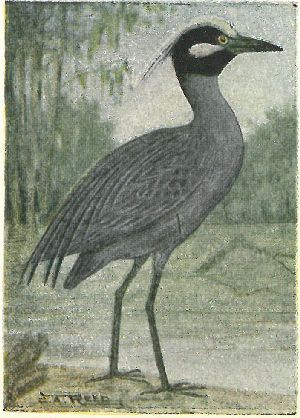
Like the last species, the head of this one is adorned with three long, rounded, white plumes; in life these plumes are rarely separated, but are nested together so that there appears to be but one. As dusk approaches, these birds sally out from their roosting or nesting places, and with slow, measured flaps, wing their way to their feeding grounds, which are usually fresh water bogs, teeming with animal and insect life. After dark the “quark” of Night Herons is frequently heard as the birds pass overhead, and they can very easily be decoyed by a crude imitation of their call. This species is principally confined to the South where it is found in heronries of its own kind, or in company with others.
Notes.—Like those of the Black-crowned Night Heron.
Nest.—A platform of sticks in trees, in swamps. 3 or 4 pale bluish-green eggs (2.00 × 1.40); May.
Range.—Breeds north to South Carolina and Southern Illinois; later may stray farther north.
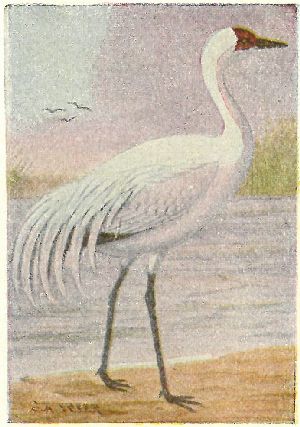
Plumage white, with black primaries; the inner wing feathers greatly lengthened, making a flowing train. Head of adult, largely bare, carmine colored, and with a few black hair-like feathers; eye yellow; bill and legs black. Young birds are whitish, mixed with gray. These great birds are not uncommon on the prairies of interior America, where they frequent the edges of marshes and sloughs. They are very wary and their great height enables them to see anyone a long way off, above the marsh grass. They were formerly found on the South Atlantic coast, but are now extremely rare there.
Notes.—A loud whooping scream.
Nest.—On the ground, usually in marshes; it is a bulky mass of grass and weeds, with the hollowed top a foot or more above ground. The two eggs that they lay are brownish-buff, spotted with brown (3.75 × 2.50); May, June.
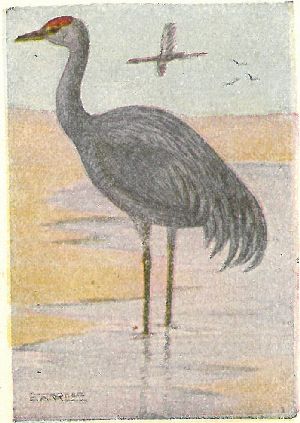
Like the next and better known species, but smaller and browner, especially on the wings.
Range.—Breeds in the interior of Northern Canada; migrates, west of the Mississippi and east of the Rockies, to Mexico.
Plumage entirely grayish with a few brownish feathers; bare skin on top of head, red. These cranes are locally distributed in the Gulf States, and in the interior north to Manitoba. Their food consists largely of grasshoppers, worms and lizards. Unlike herons, their young are born covered with down and can run about as soon as they appear. When flying, cranes carry their neck full outstretched.
Nest.—On the ground like that of the Whooping Crane.
Range.—Winters on the Gulf coast and in Florida; breeds north to Manitoba.
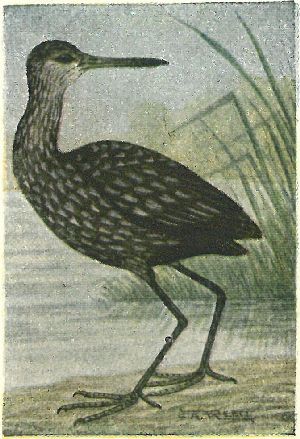
These singular birds are the connecting link between the cranes and the rails. They are rarely seen in flocks, usually living a secluded life in pairs. They are often known as the “crying bird,” because of the peculiar wailing cries that they utter, both in daytime and after nightfall. They are great skulkers, and it is difficult to make them fly; when they do take wing, it is only to go a few rods before dropping into the shelter of the reeds again. They can run rapidly, having a peculiar mincing gait, that is said to have given them the name of Limpkin.
Notes.—A peculiar wailing “whee-ee-eu.”
Nest.—A loosely constructed platform of sticks, leaves, grass and moss, located a few feet from the ground in tangled underbrush or vines. The 4 to 7 eggs are buffy white, blotched with brown (2.30 × 1.70); April, May.
Range.—Breeds and is resident in Southern Florida, and casually Texas.
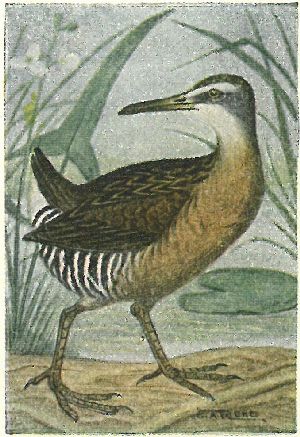
Back handsomely patterned with black, olive-brown and gray; wing coverts reddish-brown; neck and breast, rich cinnamon-brown, brightest on the breast. Sides sharply barred with black and white. This species is the handsomest of the rails, and is the most distinctly and brightly marked. They are excellent runners and are very difficult to start from the marsh grass within which they are concealed. They are usually found in fresh water marshes, while the next species is most abundant in salt marshes; they are both often found in the same place and must be seen at close range to distinguish them.
Notes.—A loud “bup, bup, bup” repeated and ending in a roll. (Chapman).
Nest.—Of grass and weeds on the ground in marshes. The eggs are pale buff, spotted with reddish-brown (1.6 × 1.2); June.
Range.—Breeds from the Gulf coast north to Conn., Ont., and Minn. Winters in southern U. S.
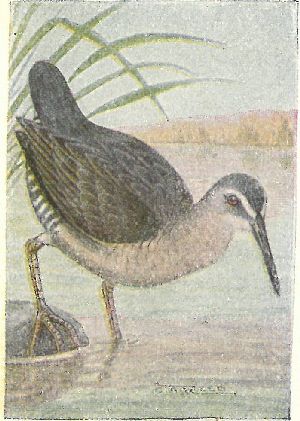
General color above olive-grayish, with no strong black markings; breast pale brown; flanks barred with gray and white. This species is found almost exclusively in salt marshes, where they skulk about like rats. During exceptionally high tides, when their hiding places are covered, many of them are killed by negroes and white men for food; they can swim, but usually run across the marsh, making use of blades of grass, sticks or whatever trash may be in their course, as stepping stones.
Notes.—Loud and clacking like those of the King Rail.
Nest.—Of grasses on the ground in salt marshes; 6 to 14 buffy eggs, spotted with brown (1.70 × 1.20).
Range.—Salt marshes of the Atlantic coast, north to Mass. The following subspecies are darker and very locally distributed. 211a, Louisiana Clapper (R. c. saturatus), coast of La. 211b, Scott Clapper (R. c. scotti), Gulf coast of Fla. 211c, Wayne Clapper (R. e. waynei), east coast of Fla. to S. C.

Coloration almost exactly like that of the King Rail, but the bird is much smaller. Like that species, this one prefers fresh water marshes. They have a great aversion to flying, and, like other rails, will trust to their legs for safety, should danger threaten; probably no other birds are as dexterous as the rails in threading their way through the close standing rushes. Although they do not have webbed feet, they can swim fairly well, and also dive, but they do so only when they are forced to. They look extremely awkward as they run over the trash on the marsh, their head and neck erect and extended, with their head rapidly turning from side to side as though looking for a place of safety.
Notes.—A guttural, rattling “cut-cut-cut-ee.”
Nest.—Of grasses, on the ground or in tufts of rushes; eggs creamy-white, specked with brown (1.25 × .90); May, June.
Range.—Breeds in the northern half of the United States and southern Canada; winters in southern U. S.
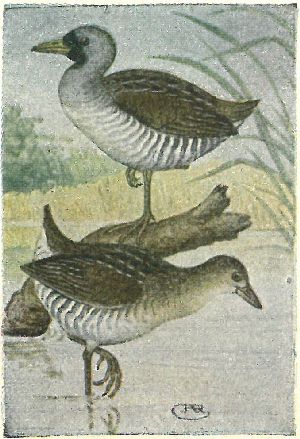
Adults with the face and throat black. Young with no black on the head. This species is not apt to be confused with any, except, possibly, the Virginia Rail, which is somewhat larger, and always has the breast conspicuously cinnamon color. These birds are very abundant in nearly their whole range, but they are so secretive in their habits that their presence is often not noticed. Unless disturbed, they pass the greater portion of the day in slumber, and do most of their feeding after dusk, when their confused, clucking notes are heard all over the marshes. All of the rails have this habit of feeding chiefly at night, perhaps through fear of enemies during the daytime, for they seem to be very timid birds.
Notes.—A rapid clucking, “kuk, kuk, kuk,” etc.
Nest.—A rude structure of grass and rushes on the ground in either salt or fresh marshes; 6 to 16 buff colored eggs with reddish brown specks.
Range.—Breeds in the northern half of the U. S. and northwards; winters in the southern half.
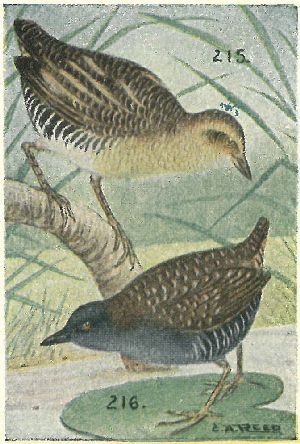
This is a handsome bird, the entire plumage having a glossy lustre. The back is blackish, with all the feathers edged with white, while the head, neck and breast have a peculiar yellowish-brown shade.
Nest.—On the ground; made of rushes and grass woven and twisted together; the 6 to 12 eggs are rich buff color, specked in a wreath about the large end, with reddish-brown; size 1.10 × .80; June.
Range.—Breeds in northern U.S. and southern Canada; winters in the southern states.
Much smaller than any of our other rails; very dark.
Notes.—A peculiar, loud clicking sound.
Nest.—Of grass and rushes, well cupped to receive the 6 to 12 eggs; these are creamy white, speckled with reddish brown (1.03 × .75); June.
Range.—Breeds in the United States north to Mass., southern Minn, and Oregon. Winters in the West Indies and Central America.

Bill shorter and stouter than that of the rails, and with a hard shield at the base, that extends on the forehead to the top of the head. This species is beautifully colored with purplish-red and blue on the underparts, and greenish on the back and wings; legs yellow; bill carmine, tipped with yellow. The habits of the gallinules are practically the same as those of the rails. They inhabit marshes, where they creep cautiously but rapidly through the upright stalks, or run over the slimy surface, where none but birds with extremely long toes could get a foothold. Their powers of flight are weak, and they do not take wing unless they are cornered or wish to cross some stream.
Nest.—Woven of grasses and rushes, and placed either on the ground or attached to living rushes, usually over the water; their 5 to 10 eggs are rich cream color, spotted with reddish brown (1.60 × 1.15).
Range.—Breeds in eastern United States, north to North Carolina and southern Illinois; winters south of the U. S.
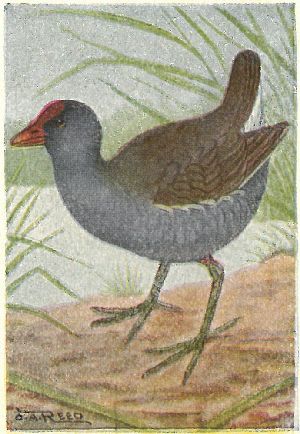
Bill and crown plate, red, tipped with yellow; legs greenish with a red ring around the top; plumage gray changing to blackish on the head and neck. Florida Gallinules are very noisy, especially during the mating and breeding season, and marshes in the south, where they breed by hundreds, fairly ring with their cries chuckles and squawks. They have an almost endless variety of notes but all of them are harsh and explosive. At times they appear to be stupid, and allow anyone to approach in a boat, near enough to touch them with an oar. When frightened, and with no protecting rushes to conceal them, they will rush off over the grass and water, with much spattering and squawking.
Nest.—Usually fastened in the marsh grass or flags above water; made of rushes and grass; the eggs are similar to those of the Purple Gallinule but are duller.
Range.—Breeds north to southern New England, Ontario, Minnesota and Oregon; winters in southern U. S.
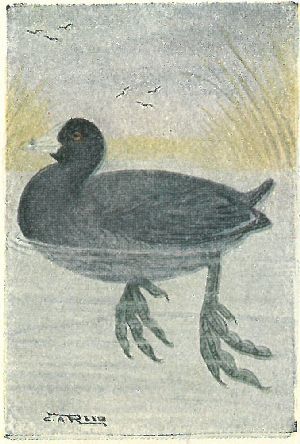
Bill and frontal shield as in the gallinules, but the bill is whitish with a blackish ring near the tip; each individual toe is furnished with a large scalloped web; otherwise their plumage is grayish like that of the Florida Gallinule. Coots are, locally, very abundant throughout temperate North America in summer. Like gallinules, they inhabit reedy pools, sluggish streams and boggy marshes, where they are at least safe from human pursuit. They conceal themselves among the reeds, so as to escape observation, taking wing only when they are obliged to. They are expert swimmers, and can dive and swim for long distances under water; in this respect they have a decided advantage over the rails and gallinules.
Nest.—Like that of the gallinules; 6 to 15 grayish eggs, finely speckled with black (1.80 × 1.30). May, June.
Range.—Breeds throughout temperate America, rare on the North Atlantic coast; winters in southern U. S.
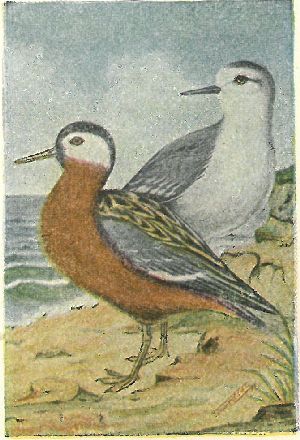
Bill heavier than any of the other phalaropes; feet lobate-webbed. Adults in summer have the entire underparts reddish brown; side of head white; upper parts gray, white and black. In winter, head and underparts are white; back gray. Phalaropes differ from any other of our birds, in that the female is the larger and brighter plumaged bird, and the duties of incubation are largely or chiefly performed by the male bird. These phalaropes are very rarely seen in the United States in their breeding plumage; when they come in the Fall, nearly all have changed to their dull winter dress, and they keep this until after they leave us in the Spring.
Nest.—A hollow in the ground, lined with a few grasses; eggs greenish buff, spotted with blackish.
Range.—Breeds in the Arctic regions; winters south to New York, Calif., and Ohio, chiefly on the sea coasts.
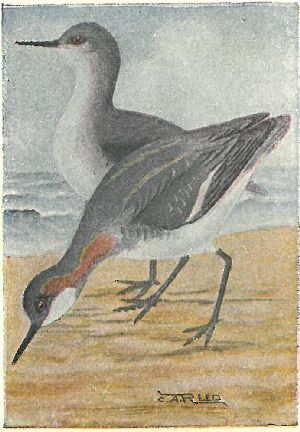
Bill short and slender. Female in summer with reddish-brown breast; gray upper parts mixed with white and buff; throat and belly, white. Male, similar but duller colored. In winter, the upper parts are gray mixed with white, and the underparts are pure white. This is a maritime species that nests in the far north, and appears on our coast only for a short time during migrations. Like the last, they are expert swimmers and pass most of their time, when not breeding, upon the surface of the water, where they can outride the most severe storms in safety. They feed upon minute insects that they secure from beds of floating kelp.
Notes.—A sharp, rapidly repeated, metallic “tweet.”
Nest.—A grass-lined hollow in the ground; eggs greenish-buff, spotted with black (1.30 × .90).
Range.—Breeds from Labrador, Hudson Bay and Alaska northward. Winters south of the United States, migrating along both coasts, and to some extent in the interior.
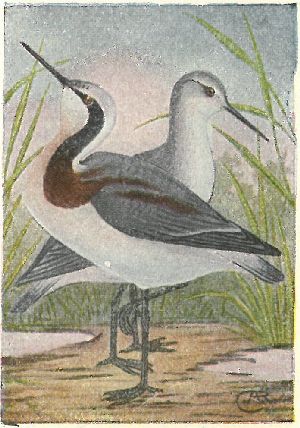
Bill long and slender. Female in summer with a black line through eye, shading into a broad stripe of rich chestnut on the sides of the neck. Male much duller colored and slightly smaller. This phalarope is one of the most beautiful of all our shore birds, and is the most southerly distributed of the phalaropes. It is a bird of the interior, and is only rarely or casually met with on the sea coasts. It commonly travels about in small companies instead of large flocks as the other two species do, and is not as often seen on the water, although it can swim well.
Notes.—Usually silent, but has a low quack.
Nest.—Of grasses, on the ground, usually concealed in a tuft of grass, and near the border of a marsh or pond; the 3 or 4 eggs are brownish or greenish-buff with black markings (1.30 × .90); June.
Range.—Breeds chiefly in the interior, from Iowa and California, north to Hudson Bay; winters south of the U. S.
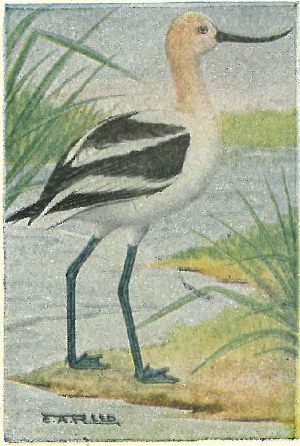
Bill slender and recurved; feet webbed; feathers on the underparts very thick and duck-like, being impervious to water. In summer, the head and neck are pale cinnamon color; young birds and winter adults have the head and neck white, but the rest of the plumage is the same as in summer. These interesting waders are very abundant in some localities on the western plains. During the breeding season, if not molested, they become very tame; at other times they are quite wary. Their food consists of water insects and small Crustacea, which they secure in a novel manner. Wading along in shallow water, with their head immersed, they keep their bill moving from side to side through the soft mud.
Nest.—Of grass, on the ground; the eggs are brownish-buff spotted with black (1.90 × 1.30); May, June.
Range.—Breeds locally from Texas and southern California northward to Saskatchewan; rare or casual east of the Miss, and on the Atlantic coast.
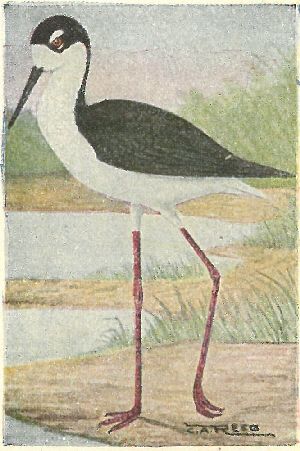
Legs extremely long, and bright red; neck and bill moderately long and slender. Male black and white as shown; female and young with the back brownish. These very long-legged creatures are found in suitable places west of the Mississippi River, and are especially abundant in southern California. Stilts are poor swimmers, but habitually feed in comparatively deep water, that is up to their bodies, their whole head, neck and upper parts of the body often being submerged while thus engaged. They are strong and swift on the wing, twisting as they fly, so as to alternately show their black upper parts, then the white surfaces beneath; this is a habit that is common to several varieties of shore birds.
Nest.—On the ground as usual; eggs greenish-buff, spotted with black (1.80 × 1.25); May, June.
Range.—Breeds in the Gulf states and southern California, north to Dakota; winters south of U. S., except in southern California. Rare on the Atlantic coast.
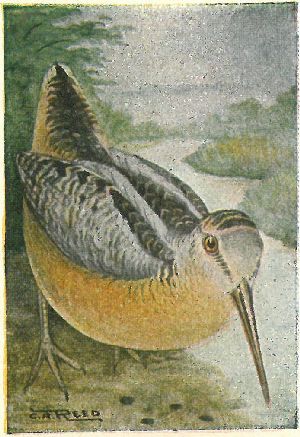
Bill very long; eyes very large and located near the top of the head; form heavy; legs short; plumage much mottled with black, brown and gray. These peculiar birds are very well known throughout their range, to gunners and sportsmen, who have been the means of almost completely exterminating them in some localities. They are found in runs along the edges of brooks, where the mud is soft. Their food is of worms, insects and their larvæ, which they get from the ground by boring with their long bills. Their flight is very rapid, and when startled they double and twist in their haste to get away, their three narrow outer wing feathers producing a peculiar whistling sound.
Notes.—A low peep, and a twittering.
Nest.—Simply a hollow amid the surrounding leaves; the 4 eggs are buff, with yellowish-brown spots (1.50 × 1.15); April, May.
Range.—Eastern N. A., breeding chiefly from Ohio and New Jersey, northward; winters in southern U. S.
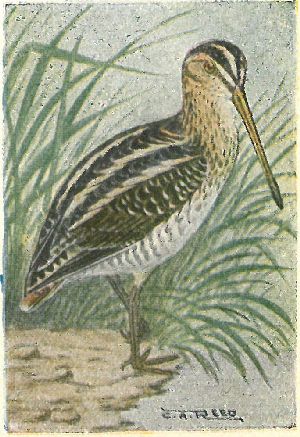
Bill very long, but not as heavy as that of the Woodcock; eyes not abnormally large; head striped with black and whitish; back handsomely variegated with black, brown and white; sides barred with black and white. The Snipe frequents more open country than the Woodcock, being found in marshes or along open brooks. Like the Woodcock, they often lie still and trust to their colors to prevent their being seen, but if they are observed, and they are always on the alert, they instantly take wing and pursue a zigzag course out of sight. Like the last species they procure their food by boring, the tip of the bill being flexible, so they can grasp their food when they feel it.
Notes.—A sharp, harsh whistle as they take wing.
Nest.—Depressions in the grassy edges of ponds or marshes; eggs olive gray, marked with blackish (1.50 × 1.10); May, June.
Range.—Breeds from the northern tier of states northward. Winters in southern U. S.
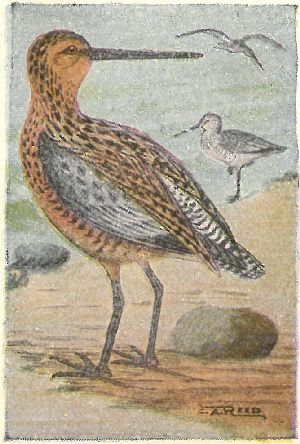
Bill very long like that of the Snipe. Adults in summer are reddish-brown below, more or less specked with black on the breast and barred with black on the sides; above mottled with brown and black, lighter, or even white, on the rump. In winter, they are gray above and white below, the breast being tinged with gray and streaked with dusty. Dowitchers are known as Red-breasted Snipe and as Robin Snipe by gunners, with whom they are great favorites. They usually travel in flocks, and often with flocks of other species. Their notes are a series of musical whistles, easily imitated, and the birds are easily attracted thereby.
Nest.—As usual on the ground; eggs greenish-buff, spotted.
Range.—Eastern N. A., breeding in the Arctic regions; winters south of the U. S.
232. LONG-BILLED DOWITCHER (M. scolopaceus), is found in western N. A. The bill is supposed to be longer, but the plumage is identical and the birds probably are.
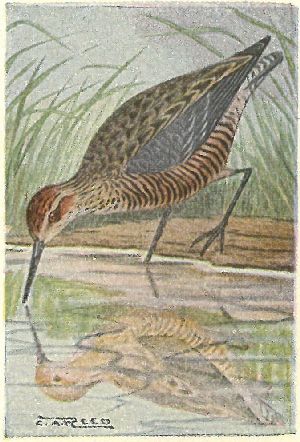
Bill slender and only moderately long. In summer, the entire underparts are rusty-white, barred with blackish; ear-coverts and top of head browner; back mixed brown and black. In winter, they are gray above and whitish below, with the breast streaked with dusty. They seem to be one of the least abundant of our shore birds, single individuals being found in flocks of other species, rather than in flocks of themselves. They are usually more shy than the birds with which they are associated, perhaps because they lack companionship of their own kind. They have a musical whistle, not distinctive from that of many others of our small shore birds.
Nest.—The three or four eggs are laid in a hollow in the ground, usually in the grass back from the beach; eggs grayish, blotched with various, shades of brown.
Range.—Eastern North America, breeding in the Arctic regions and migrating through the United States to South America, chiefly on the Atlantic coast.
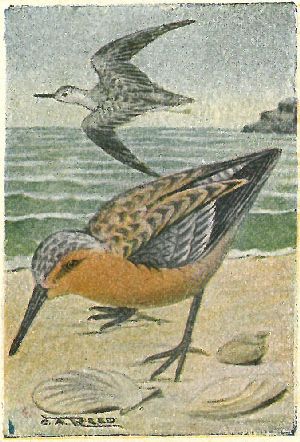
Bill moderately long and quite stout; form more robust than most of our shore birds. Adults in summer, mixed brownish and gray, above, and uniform reddish-brown below. In winter, plain gray above and white below; young similar but with feathers on the back edged with white. It is an abundant species on the Atlantic coast during migrations, and is known by various names such as Red-breasted Sandpiper and Robin Snipe, when in summer dress, and as Gray-back when in winter plumage. It is usually found on the ocean beach, where it follows the waves as they recede, picking up numerous insects left there, and retreating before the next wave.
Notes.—An ordinary Sandpiper whistle.
Nest.—Not positively known, but a supposed egg obtained by Lieutenant Greely in the vicinity of Fort Conger was pea-green in color, with small brown spots. (1.10 × 1.00).
Range.—Breeds in the Arctic regions; migrates chiefly on the Atlantic coast, to South America.
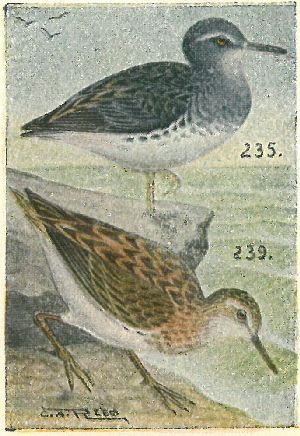
Upper parts blackish, margined with buffy; breast and sides slaty purple. In winter, blackish, without the rusty edging to the feathers. These dark colored little sandpipers prefer bold rocky coasts.
Notes.—A loud, shrill whistle.
Nest.—A hollow in the ground, among grass and weeds, lined with a few grasses; eggs grayish buff, handsomely splashed with various shades of brown.
Range.—Breeds from northern Labrador and the mouth of Hudson Bay northward; winters south to Long Island Sound and the Great Lakes.
Crown and back blackish, strongly edged with reddish-brown; an ashy-gray wash on the breast, with numerous streaks of blackish. Well known and called by a great variety of names, of which Jack Snipe and Grass Snipe are probably the most common.
Range.—Breeds in the Arctic regions; migrates through the U. S. to South America.
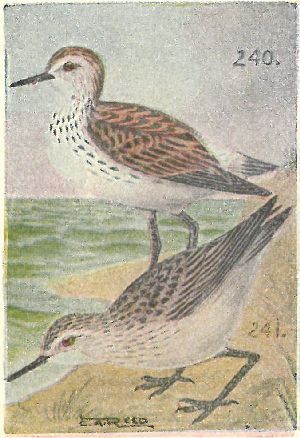
Upper tail coverts white; below white, but with the throat and breast streaked with dusky, these markings extending on the sides to the tail.
Notes.—Musical whistles in no way different from those of the Least Sandpiper.
Nest.—On the ground, in grass back of beaches; eggs gray, profusely blotched with blackish brown.
Range.—Eastern N. A., breeding from Labrador and Hudson Bay northward; migrates through the U. S. east of the Rockies, to southern South America.
Of the same, size, form and general coloration as the White-rumped Sandpiper, but the upper tail-coverts are blackish, and the breast is only very faintly streaked.
Range.—Breeds in the Arctic regions, and migrates chiefly through the interior, but to some extent on the coast, south to southern South America.

Smallest of our sandpipers. Upperparts blackish, edged with bright chestnut; breast and sides ashy-gray, conspicuously streaked with dusky.
Notes.—A musical whistle, “peet-weet.”
Nest.—A grass lined hollow; eggs grayish, heavily blotched with blackish brown (1.15 × .80).
Range.—Breeds from Nova Scotia and northern British Columbia northward; winters from the Gulf States and California southward.
Feet with small webs between the toes at their base. Similar in size and form to the Least Sandpiper, but the upper parts are not as bright rusty, and the breast is only faintly streaked with dusky.
Range.—Breeds from Labrador northward.
247. WESTERN SANDPIPER (E. mauri) is very similar; more rusty above, with stronger markings.
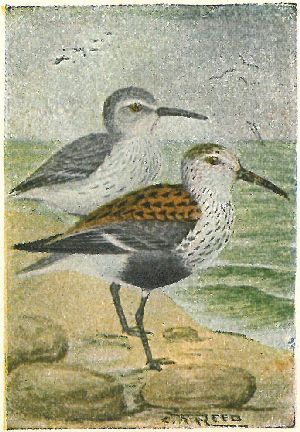
Bill slightly decurved and rather stout. Adults in summer, with the upper parts largely bright rusty; belly black; head, throat, breast and sides strongly streaked with black. In winter, dull brownish-gray above and white below, with the breast washed with grayish and slightly streaked with dusky. Found in large flocks on both the Atlantic and Pacific coasts, during migrations, but rarely in the interior. Their flight is very rapid and performed in very compact flocks that act as if governed by one impulse. They are very active, feeding for a short time in one place, then flying to another. They are found most abundantly on sand bars and mud flats, rather than on the open beach.
Nest.—Usually on dry, grassy knolls, a hollow in the earth being lined with a few dried grasses. Eggs pale greenish or brownish gray, spotted with blackish (1.40 × 1.00); June.
Range.—Breeds in the Arctic regions, and winters from the Gulf coast and southern California, southward.
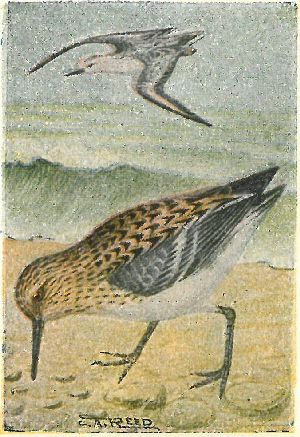
Toes short and stout; no hind toe. Adults in summer, variegated above with bright reddish-brown and black; below white, the breast being strongly washed with rusty and spotted with black. In winter, plain grayish above and white below; head white, except the crown; young birds are like winter adults but have the back with some blackish. In the interior this species is found on the edges of lakes and rivers. On the coast, it is one of the boldest of the shore birds, feeding on the edge of the outer beach, often under the combing crest of the incoming waves, retreating just as the wave breaks and is dashed to foam on the beach. They are usually wary and will not allow a close approach.
Nest.—On the ground; eggs greenish-buff, spotted with black.
Range.—Breeds in the Arctic regions; winters south to Patagonia, migrating on both coasts and to a less extent in the interior.
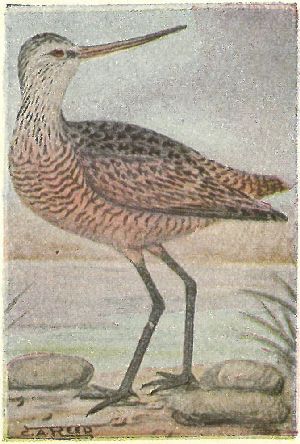
Bill long and slightly recurved. Back, wings and tail, rufous, barred with black; rump usually white, with black bars; underparts pale rufous with narrow bars; head grayish, with black streaks on the crown and sides. Young similar, but whiter below and with few or no bars. These large waders are found in moderately large flocks both in the interior and on the coast in the fall. They frequent salt marshes on the coast, and the borders of ponds and lakes in the interior. They are much hunted and are consequently very wary, usually taking wing as soon as anyone appears in sight. They are readily decoyed, and thousands perish annually at the hands of sportsmen. They are known by many names, Marlin and Straight-bill Curlew probably being the most commonly used.
Range.—Breeds in the interior from Iowa north to Saskatchewan. Winters south of the U. S., migrating along both coasts as well as in the interior.

Bill slightly recurved; tail black at the end, and white at the base, not barred as that of the last species always is. Above blackish, with rusty margins; below deep reddish-chestnut, barred, chiefly on the sides, with black. In winter, similar but duller both above and below, with only traces of bars on the flanks, and with the breast more or less streaked. This species is more abundant on the Atlantic coast during migrations than the last. It is most often known as the Ring-tailed Marlin, owing to a very strong contrast between the black tail, white rump and dark upper parts as the bird flies. They are usually found in the marshes back of the ocean beach, and, owing to their large size, can be seen for a long distance.
Notes.—A loud, shrill Whistle.
Nest.—A grass lined hollow in marshes; eggs brownish buff, blotched with blackish (2.20 × 1.40).
Range.—Breeds in the Arctic regions; winters south of the United States, migrating chiefly on the Atlantic coast, but to some extent down the Miss. Valley.

Bill long and rather slender; legs long and yellow or greenish yellow. Head and neck streaked with gray and white; back black margined with white; rump white; tail barred black and white; underparts white, washed with gray on the breast; and with numerous black arrow-head markings. In winter, similar, but with no black markings below.
Notes.—A loud three-syllabled whistle.
Range.—Breeds from northern portion of Miss. Valley in the U. S. northward; winters from the Gulf States and southern California southward.
Very similar in form, color and markings to the large Yellow-legs, but smaller in every way.
Range.—Breeds in the interior of Canada, north to the Arctic Ocean, and possibly in northern Miss. Valley. Winters from the Gulf States southward, migrating in the interior and along the Atlantic coast.
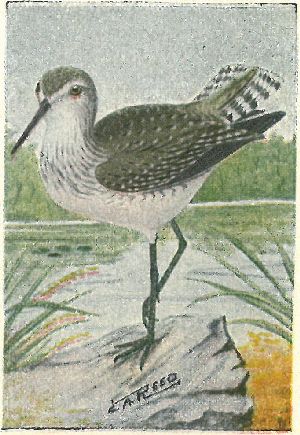
Above olive-grayish, streaked on the head and neck, and sharply speckled on the back and wings, with white; tail sharply barred with black and white; below white, streaked on the breast and barred on the sides with gray and white. In winter, with fewer white markings on the back. It is often confused with the Spotted Sandpiper that frequents the same places, but should be easily identified when it flies by its barred tail and linings of the wings. They have the habit, common to nearly all the shore birds, of elevating their wings after alighting, and then carefully folding them on the back.
Nest.—For a long time their eggs were unknown, but are now known to be laid in the nests of other land birds, at low elevations in trees or bushes near water. They have been found in Manitoba in a Waxwing’s nest. Eggs bluish-green with blackish-brown blotches.
Range.—Breeds from Northern U. S. northward; winters south of the U. S.

Bill long and quite stout; feet with small webs between the bases of the toes. Upper parts brownish-gray, more or less speckled with black; most of secondaries and bases of primaries white, very conspicuous in flight, and easily distinguishing it from any other wader of its size. Usually found in small flocks along the edges of marshes; they are said to be quite shy except during nesting season, and to be difficult to decoy. After breeding they wander northward and are often seen in flocks of other migrating species. When standing on the beach they often indulge in curious antics, bowing and flirting their tails.
Notes.—A loud, shrill whistle, “pill-will-willet.”
Nest.—On the ground; eggs buffy, blotched with brown.
Range.—Breeds from the Gulf to New Jersey; later strays to Maine. 258a, Western Willet (S. s. inornata) is supposed to be slightly larger and paler. Breeds from Texas to Manitoba; winters along the Gulf coast.
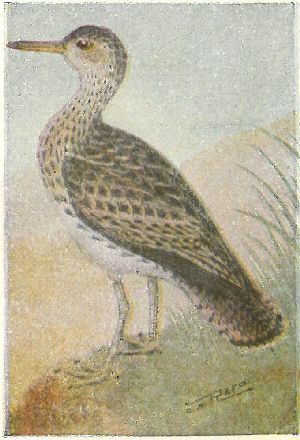
Upper parts blackish with greenish-brown edgings; tail brownish with black bars, and white tips to the outer feathers. Underparts white, with prominent inverted, black arrow head markings on the breast and along the sides. These birds are more often known as Upland Plovers, because they are found on dry hillsides, rarely near water. West of the Miss. they are said to occur in large flocks in the Fall, but in the East, half a dozen or so would be considered a fair sized flock. They feed upon small grasshoppers and other small insects, sometimes chasing them for a considerable distance before securing them. They are shy and usually take wing as soon as they see you.
Nest.—Of grasses, usually concealed in clumps of grass or weeds in the middle of fields; eggs buffy, blotched with yellowish-brown (1.75 × 1.25); May, June.
Range.—Breeds locally in the northern half of the United States and Southern Canada; winters south of the U. S.
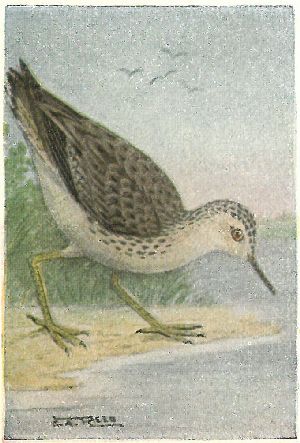
Bill short and slender. General color above, blackish-brown margined with tawny; underparts buffy, with a few black specks on the sides of the breast. Primaries blackish-brown on the outer webs, the inner webs, as well as those of the secondaries, being whitish, peculiarly speckled with black; these markings are characteristic and are found on no other of our shore birds. It seems to be most nearly related to the last species, and like that, is often found on hillsides at a distance from water.
Notes.—A low, weak “tweet.”
Nest.—A scantily lined depression on the ground; the four eggs are grayish-buff, boldly blotched with rich chestnut-brown and black (1.45 × 1.05); June.
Range.—Breeds in Arctic America; winters in South America, migrating chiefly through the interior of the United States, but to a less degree on the coast.
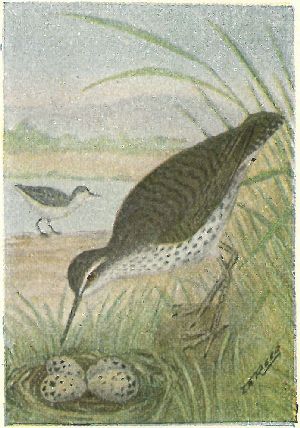
Below white, with round blackish spots, heaviest on the breast and sides; above olive-brown or gray, with faint black bars; a narrow black line from the bill through the eye to the ears. Young entirely white below, with the breast faintly tinged with gray. These birds are abundant and breed locally throughout the United States and the greater part of Canada. One or more pairs will usually be found nesting in the fields about all small ponds, or among the weeds that grow about edges of pools and lakes. They have a peculiar habit of “teetering,” whether standing still or while feeding on the banks of streams or ponds; other birds do this but not nearly as persistently as Spotted Sandpipers.
Notes.—A clear “peet-weet;” also a single melodious whistle.
Nest.—On the ground in fields or near the edges of pools or streams; eggs buffy, boldly spotted.
Range.—Breeds from the Gulf to Hudson Bay; winters south of the U. S.
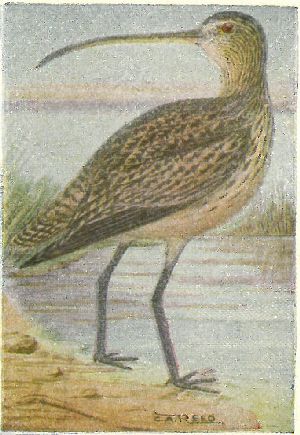
Bill much decurved and very long (4 to 8 in.), the longest of any of our shore birds. Plumage variegated with rufous and blackish above; bright buffy or rufous below, streaked on neck and breast, and barred on the sides with blackish. “Sickle-bills,” as these birds are often called, are the largest of our shore birds. They are very conspicuous either when flying or walking on the marshes or sandbars, their size appearing gigantic when they are in a flock of smaller plover, as sometimes happens. They fly in compact flocks, evidently led by one individual, for they wheel and circle in perfect unison, sailing up in the wind on outspread wings, when about to alight.
Notes.—A flute-like whistle, “ker-loo.”
Nest.—On the ground; eggs greenish-buff, with small black spots over the whole surface (2.50 × 1.80).
Range.—Breeds in the Upper Miss. Valley, north to Manitoba; winters in the Gulf States, and southward; formerly bred on the South Atlantic coast; strays to New England and New Brunswick in the fall.
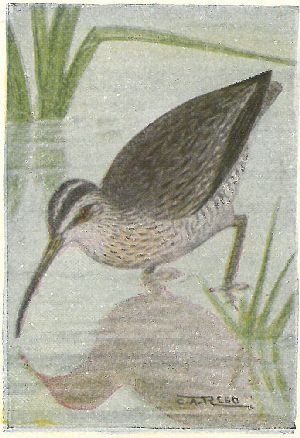
Darker brown above, than the Sickle-bill; crown broadly striped with blackish and buff; underparts grayish, streaked on the breast and barred on the sides with blackish. This and the succeeding species are summer inhabitants of the Arctic regions, being found within our borders only for a short time in the Fall and Spring. It is found in fresh and salt water marshes, as well as on mud-flats and on sandy beaches of the seashore. They are very unsuspicious and are easily stalked, or decoy very easily, coming to wooden caricatures of themselves stuck up in the mud, or to crude imitations of their whistles; consequently large numbers of them are shot and they are becoming scarce.
Notes.—Similar to that of the last.
Nest.—Hollows in the ground, lined with grasses and weeds; eggs buffy, blotched with brownish-black (2.25 × 1.60).
Range.—Breeds in the Arctic regions. Winters south of the United States, migrating both on the coast and in the interior.
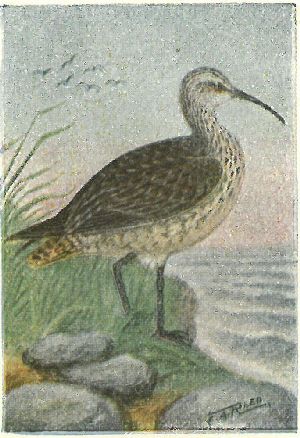
Bill comparatively short (about 2 in.) and little curved. Above, marked similarly to the last; below white or pale buff, often thickly covered on the breast and sides with streaks and arrow head markings of blackish. Primaries and most of the secondaries plain brownish-black, without the variegation of the last species. A few years ago this was considered the most abundant of the curlews, but so persistently have they been hunted that they are now practically exterminated. When it comes to looking after their safety, curlews are, perhaps, the most stupid of the shore birds for they do not seem to realize the dangerous character of mankind in general, and they have paid the penalty. I trust that all sportsmen will refrain from shooting these birds.
Nest.—Like that of the Hudsonian; eggs similar but smaller.
Range.—Eastern N. A., breeding in the Arctic regions and migrating through the Plains, Mississippi Valley, and to a less extent on the Atlantic coast, to South America. Very rare now anywhere.
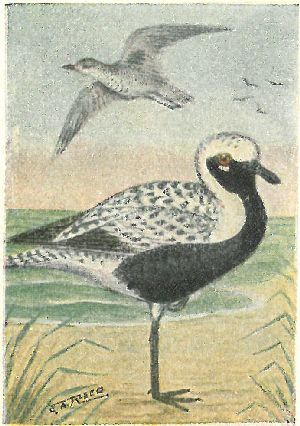
Hind toe very small. Bill short and stout. Adults in summer with the back, wings and tail barred or marked with black and white; top of head and nape white, except for a few black markings on the crown; face, throat, breast and fore part of belly, black. In winter, brownish-black, somewhat mottled, above; below dull white. Young similar to winter adults, but the back is spotted with yellowish-white. While these handsome plover migrate to some extent, and sometimes in large flocks, through the interior of the United States, they are chiefly and most abundantly found on the coast. They are the plover most eagerly sought by gunners.
Call.—A plaintive whistle, “ter-lee.”
Nest.—Grass-lined hollows in marshes or dry land, back from the beach; eggs greenish-buff, spotted with black.
Range.—Breeds in the Arctic regions; winters in South America, migrating through the U. S. in Sept. and May.
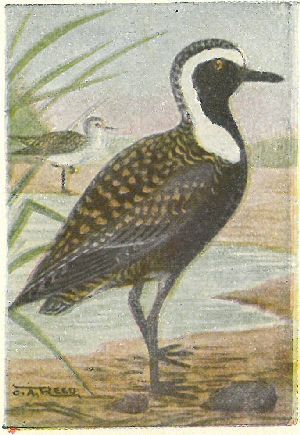
No hind toe. Back and tail mottled with black and yellow; below, more or less entirely black to the tail. Young and winter adults, more or less spotted with yellow and blackish-brown above, and grayish-white below, with indistinct streaks on the breast. Often confused with the last species in this plumage, but is smaller, bill smaller and more slender, and the axillars, or feathers nearest the body, under the wings, are gray while those of the Black-bellied Plover are black. This species is now regarded as rare on the North Atlantic coast during migrations, while in the interior it is more abundant than the last species. They do not seem to be as suspicious as the Black-bellies, and a flock will often allow a close approach, even when they see you.
Nest.—Nesting habits like those of the last, and other shore birds; eggs slightly smaller (1.90 × 1.30).
Range.—Breeds in the Arctic regions; winters south to South America.
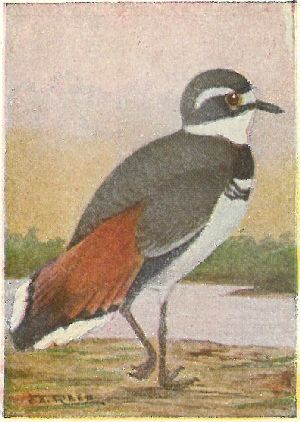
No hind toe. Rump and base of tail reddish-brown; breast crossed by two black bands. Like the Spotted Sandpiper, this bird is locally and abundantly distributed throughout the United States and Southern Canada; it is, however, rare in New England, where it is sometimes found in the Fall. It frequents meadows, fields and ploughed ground, where it feeds upon insects, and around the edges of pools and streams where it gets small shellfish and larvæ. As usual, they will attempt to lead an intruder away from their nest by feigning lameness.
Notes.—A loud, noisy and incessant “killdee.”
Nest.—A slight hollow in the ground, usually in a clump of weeds; sometimes lined and sometimes not; the four eggs are greenish-buff, heavily blotched with black.
Range.—Breeds locally throughout United States, except New England, and southern Canada; winters in southern U. S.
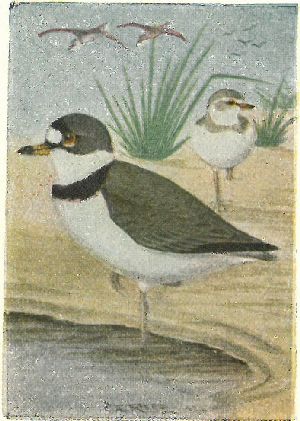
Small web between the bases of the two outer toes. Single broad, black band across the breast; black line from base of bill to eye. They are very abundant on our seacoast in Fall, both in flocks composed entirely of their own kind, and also with Least and Semipalmated Sandpipers. They usually keep on the inner side of sandbars or muddy flats bordering marshes, rather than on the open ocean beach. It is also found in smaller flocks, about ponds and marshes in the interior of the country. They are usually unsuspicious and will allow a close approach, or if you are still, will run by within a very few feet.
Notes.—A clear double whistle, usually uttered when on the wing or when alarmed. They decoy to an imitation of it.
Nest.—On the ground; eggs buffy, sparsely specked with black (1.30 × .90); June.
Range.—Breeds from the Gulf of St. Lawrence northward; winters from the Gulf States southward.
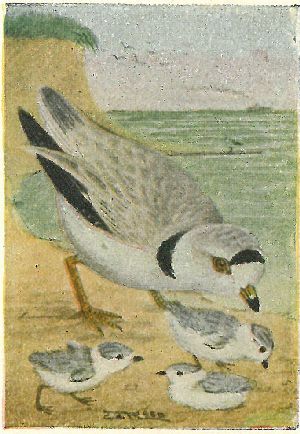
Very pale above; no black in front of eye; black patch on each side of breast. Young similar, but the black replaced by grayish, as is the case with the last species. This species, apparently, never could be classed as abundant and of late years, it is becoming rather rare along our Atlantic coast; this is probably more due to the building of summer resorts and homes along their former breeding grounds than to hunters. They are rather more shy than the last species, but will usually attempt to escape by running along the beach or by hiding, rather than by flight. Owing to their light colors it is very difficult to see them at any distance.
Notes.—A two-syllabled piping whistle.
Nest.—On the ground; eggs buff with fine black specks.
Range.—Breeds on the coast from Va. to Newfoundland and in the Mississippi Valley.
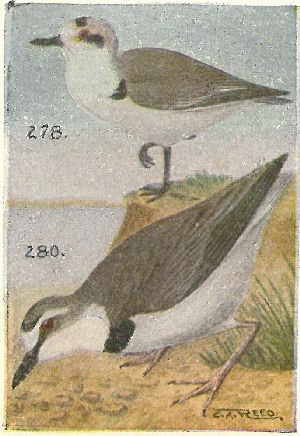
Very small and very pale colored. Small black patch on either side of the breast, on ear coverts, and on crown. Bill more slender but longer than that of the Piping Plover.
Notes.—Low, mournful, piping whistles.
Range.—United States chiefly west of the Rockies, east to Kansas and north to Dakota.
Bill large and heavy for birds of this genus. A black band across the neck, not extending to the back of the neck; dark line between eye and bill.
Notes.—A “mixture of whistle and chirp,” very different from that of allied plovers. (Elliott).
Nest.—A shallow hollow in the sand, sometimes concealed by short beach grass; eggs grayish, spotted and scratched with blackish brown (1.25 × .95).
Range.—Breeds on the Gulf and South Atlantic coasts north to Virginia; later may stray to Maine.
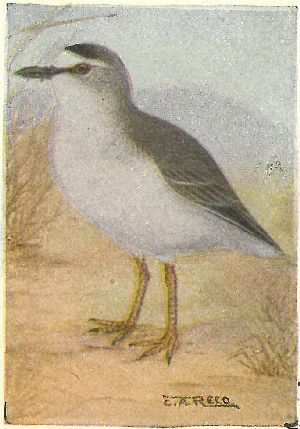
No black on breast or sides, but with black hand on fop of head and a black line from bill to eye. Above grayish-brown; below buffy across the breast, white elsewhere. Mountain or Prairie Plover, as they are often and better called, are abundant on the western prairies. Like the Bartramian Sandpiper, they do not frequent the vicinity of water, but live and get their food in the dry grass-covered districts. They are not at all shy where they are not hunted. Like all the family, they are very fleet on foot, and may often be seen chasing grasshoppers or other active insects. Their flight is very rapid, often devious and usually at a low elevation.
Notes.—A single, low, musical whistle.
Nest.—A depression in the ground, anywhere on the prairie. Eggs brownish-gray, blotched with blackish.
Range.—West of the Mississippi River, breeding north to Dakota. Winters from Southwestern United States southward.
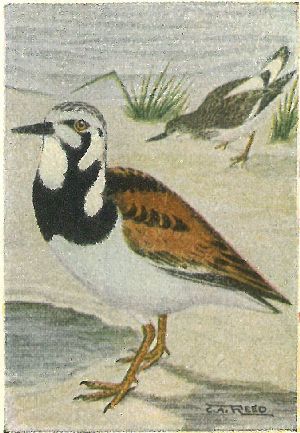
Very similar to the next, which is the one figured, but slightly larger, and with black prevailing in the upperparts. This is the Old World species, found in America only in Labrador and Alaska.
Bill short and stout, the upper mandible being straight, so that the bill has an upturned appearance. Legs reddish on adult birds and orange on young.
Known by a great many names, referring to its peculiarly pied appearance:—Calico-bird, Checkered-snipe, etc. An abundant species usually found on pebbled beaches.
Notes.—One or two clear whistles.
Nest.—A scantily lined hollow; eggs grayish, beautifully marbled with brown, lilac and blackish.
Range.—Breeds in the Arctic regions; winters in Southern South America, migrating on both coasts.
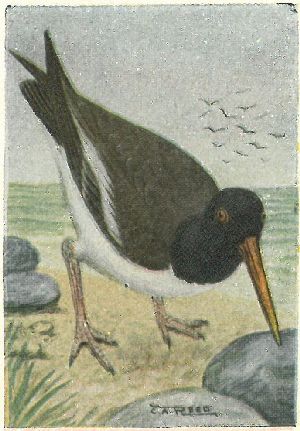
Bill very long, heavy, compressed, and thin and chisel-like at the tip. Bill and eye, red; legs flesh color. These large, awkward looking birds are not scarce on the South Atlantic coast, where they are met with in pairs or small companies. They run with great swiftness, or walk sedately along the beaches and marshes gathering insects and fiddler crabs, of which they are very fond. They are said to have got their name from the habit of eating oysters when they found them with the shell open, a practice that would be extremely hazardous for them to undertake, as these shellfish close their two valves very quickly and would be apt to catch the bird. Owing to their large size they are frequently shot at and, consequently, are usually shy.
Nest.—A depression in the sand; the two or three eggs are buffy, spotted with blackish-brown (2.20 × 1.50); May.
Range.—Breeds on the coast north to Virginia; later may stray to Nova Scotia. Winters south of the U. S.
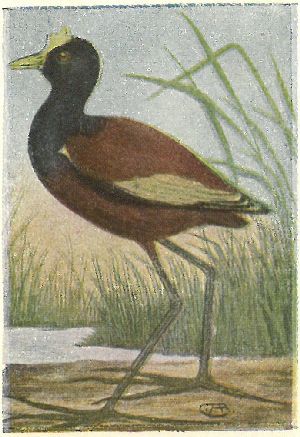
A very peculiar species. Bill plover-like; at the base, terminating in a leaf-like sheaf that covers the forehead; a hard spur on the shoulder of each wing; legs and toes extremely long, the toenails being abnormally so, the hind nail often being an inch and a half long. Young very different from the adult.—Grayish-brown above, with wings greenish-yellow as in adult; below whitish, darker across the breast and on the sides; a light line above the eye. Jacanas are inhabitants of marshy, muddy pools and ponds, where they can easily run over the surface, their long toes getting a good foothold on the floating aquatic plants. They are said to be very pugnacious in defence of their young, and also to fight among themselves during the mating season.
Nest.—Nests made of weeds and trash, on little floating islands or lily pads. 3 to 5 olive colored eggs, curiously scrawled with black (1.20 × .95); May.
Range.—Is found and breeds within our borders only in Southern Texas.
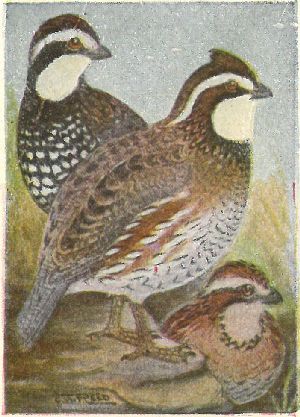
Male with white throat, bordered with black; female with a yellowish-brown throat, and line above eye. One of the most popular “game birds,” so popular that it is exterminated in New England, and birds imported from the west are unable to regain the lost foothold. Found in stubble and low brush, where they hide until almost stepped upon. They feed upon insects and grain.
Notes.—A clear whistled “bob-white” and a series of low, clear whistles when in flocks.
Nest.—Of grass at the end of tunnel in tall grass bordering fields; 8 to 16 white eggs (1.20 × .95); May.
Range.—Resident east of the Rockies, north to Minn. and Ontario. 289a, Fla. Bob-white (C. v. floridanus), found in southern Florida, is extremely dark (shown on plate). 289b, Texan Bob-white (C. v. texanus) is paler with black areas wider.
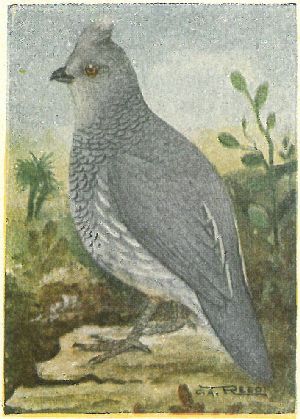
With a whitish or buffy-white crest; plumage bluish-gray, with darker edges giving the bird the appearance of being covered with scales. The female is more brownish, but is marked the same as the male. These birds are locally abundant in arid, cactus-covered deserts, often at a distance from water, and frequently in company with Gambel Partridge.
Nest.—8 to 15 eggs are laid in some hollow under a low bush or cactus; they are creamy-white, dotted with minute specks of pale brown (1.25 × .95); April, May.
Range.—Mexico north to Central and Western Texas, New Mexico and Arizona.
293a. Chestnut-bellied Scaled Partridge (C. s. castanogastris), is more richly colored and has a chestnut patch on the middle of the belly. It is found in southern Texas and northeastern Mexico.
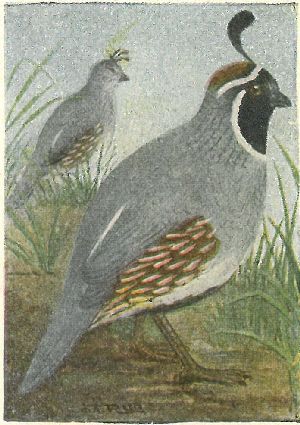
Head with an elegant recurved crest of six or seven feathers; normally these are carried in one packet so that there appears to be but one feather, but when excited, or during the mating season, they may separate the feathers, or sometimes curve them forward so as to touch the bill. Hindhead and sides chestnut, throat and middle of belly black. Female with the throat light and hindhead gray; crest small; no black on belly. An abundant species both in mountains, valleys or deserts, near or remote from water. Habits like those of the eastern Bob-white, but instead of taking wing, they will generally run.
Nest.—Eggs laid on the ground under any suitable cover; creamy-white, handsomely blotched with brown.
Range.—Resident in western Texas, New Mexico and Arizona, north to southern Utah and Nevada.
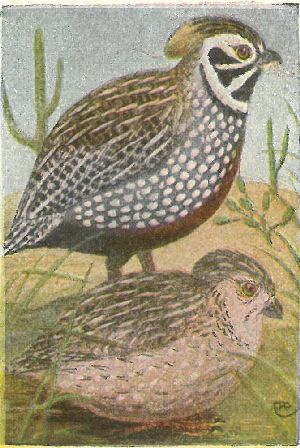
Bill very stout and compressed. Crest large, puffy and flat. Markings on the male very grotesque and clownish; general color of the female, pinkish brown with streaks of black, and white specks, below, and barred and streaked above. These strange birds are very local in their distribution in the southwest, rare in some localities and occurring in quite large flocks in others. They are so confiding in their disposition, that this, in connection with their clownish plumage, has given them the name of “Fool” Quail. They frequent dry deserts, valleys, or mountains up to an elevation of at least 8,000 feet. When startled, they often squat down, and can almost be caught in the hand, but when they do fly, their flight is very rapid, and accompanied with a peculiar clucking noise.
Nest.—A depression in the ground, lined with grasses, and concealed in clumps of weeds or grass. Their eggs, like those of other partridges, are numerous, pure white, and not as sharply pointed as those of the Bob-white.
Range.—Western Texas, New Mexico and Arizona.
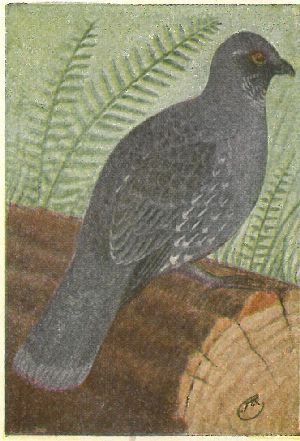
Plumage gray, white and black, with a few rusty markings on the back; wide gray band on tip of tail. Female smaller, browner and more barred above. These large grouse are found on side hills or in gulches, usually not far from water. Like our common Ruffed Grouse, during mating season, the males of this species strut about with tail fully spread over the back, and head thrown back until it nearly touches the tail. At this season they are very pugnacious and the woods will resound with their challenging “toots,”—loud and hollow sounds with a ventriloquial effect.
Nest.—Eggs laid on ground in woods, usually under fallen logs or at the bases of trees; buffy, sparsely spotted with brown (2.00 × 1.40); May, June.
Range.—Rocky Mts., from Mexico to Montana and east to South Dakota. 297b., Richardson Grouse (D. o. richardsonii), is found on the eastern slopes of the Rockies, north to British America. Little or no band on the tail.

Very similar to the next, which is our common species, but the female is not quite as rusty. Found in Labrador and about Hudson Bay.
Male black and grayish; female chiefly rusty, barred with black. The Spruce Grouse is usually found in dense thickets and groves or swamps of evergreen woods. It is one of the least suspicious of birds, and in winter, is sometimes knocked down by sticks in the hands of deer hunters. Their flesh is unfit to eat and consequently they are not hunted.
Notes.—A drumming, said to be produced by the wings, when in the air; a clucking by the female.
Nest.—Eggs laid on the ground, usually under low, spreading branches of spruces; bright buff with bold black blotches (1.70 × 1.25).
Range.—Northern New England, New York and Minnesota, northward.
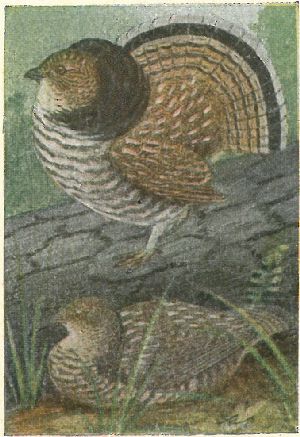
Crested and with two large, black, neck-ruffs; plumage brown, black and white. Female with the ruffs smaller and usually brownish. These grouse have two color phases, the general tone of plumage being either reddish brown or gray, independent of age or sex of bird. These naturally wild, shy grouse are the kings of the eastern game birds, their wariness and speed with which they will dodge through the trees being the only reasons they have so long withstood the hunting to which they are subjected. During spring, the male struts often, tail expanded into a half circle, head thrown back to meet the upturned tail, and ruff spread so as to form a complete collar. They make a loud drumming by beating the air with their wings.
Nest.—Eggs on leaves in the woods; plain brownish-buff (1.55 × 1.15).
Range.—Resident from Va. and Ark. north to southern Canada. 300a., Canadian Ruffed Grouse (B. u. togata), is found in the southern British provinces and northern New England.
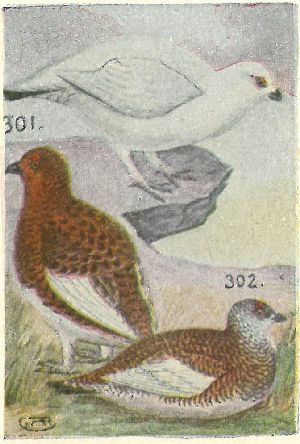
In winter, white with black tail feathers. In summer, usually reddish-brown with black bars. This species has a much stouter bill than the next.
Nest.—Eggs laid on the ground. Rich buffy, so heavily blotched and streaked with black as to nearly conceal it (1.75 × 1.25).
Range.—Breeds in the northern half of Canada, migrating southward to southern Canada.
301a., Allen Ptarmigan (L. l. alleni), found in Newfoundland, is similar, but in winter the shafts of the primaries are always black.
In winter, like the last species, except that the bill is smaller, and the lores are black.
Range.—From the Gulf of St. Lawrence and northern British Columbia northward. 302a. Reinhardt Ptarmigan, replaces the last variety in northern Labrador. 303. Welch Ptarmigan (L. welchi), found in Newfoundland, is said to be grayer in summer.
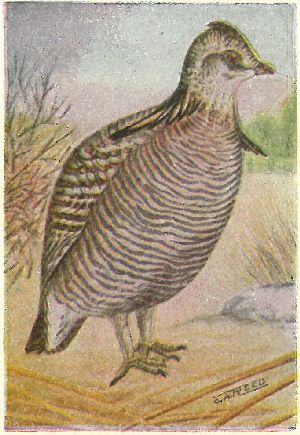
Tufts of neck feathers rounded or square at the ends, long on the males, and short on the females. Above, barred with brownish-black and white or buffy white, the bars being of about equal width; top of head barred black and grayish. Female differs from the male in having the tail feathers barred, whereas they are black in the male. Found locally throughout the prairie regions of the Mississippi Valley north to Manitoba. Owing to the immense numbers shot for sale in eastern markets, they have become exterminated in many places where they were formerly abundant. Male birds have a loose sac or naked skin beneath the tufts of feathers on the neck; they inflate these to the size of small oranges, and then produce a loud, hollow, resonant booming sound.
Nest.—Anywhere on the ground on the prairie; eggs olive-buff, finely specked with brown.
Range.—From La. and Tex. north to Manitoba and Dakota. 305. Attwater Prairie Hen, smaller and darker, is found in Louisiana and Eastern Texas.
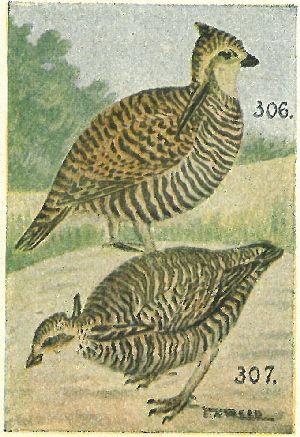
Neck feathers pointed; scapulars more broadly tipped with white; axillars always barred; top of head paler and always brownish. These differences will always separate this species from the very similar western bird. They were formerly found throughout Southern New England and the Middle States, their range meeting that of the Prairie Hen, but now they are restricted to the island of Martha’s Vineyard, south of Mass., and probably the true form is extinct there for western birds have been liberated on the island and interbred with the natives.
Nearest like the prairie hen but paler above, the brown bars being narrower and lighter colored, but with the edges blackish, giving the back of the bird a very different appearance from that of the Prairie Hen. It is found in western Kansas, Indian Territory and Texas.
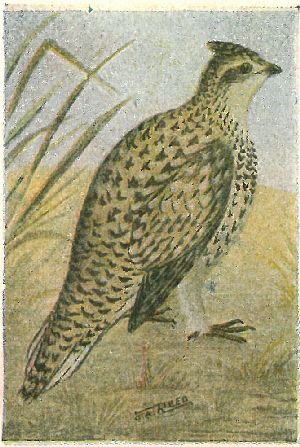
No pinnates or ruffs on the neck, but the head is crested a little more than that of the Prairie Hen; tail with the central feathers nearly two inches longer than the rest, which are also graduated so the outside ones are much the shortest. Plumage much paler than that of the Prairie Hen, and feathers on the breast and sides being marked with blackish loops. Found in more or less abundance on the plains and prairies west of the Mississippi River. In mating season flocks of them indulge in curious antics, dancing, ruffling their feathers, and cooing and crowing.
Nest.—Eggs laid in a hollow in the ground, usually sheltered by a tuft of grass or bunch of weeds. The eggs are brownish-drab, finely specked, over the whole surface, with blackish-brown (1.70 × 1.25).
Range.—West of the Miss. River, from New Mexico and Indian Territory north to Manitoba. 308. Sharp-tailed Grouse, is found in the interior of British America from Hudson Bay to Alaska. Darker and less rusty than the preceding.
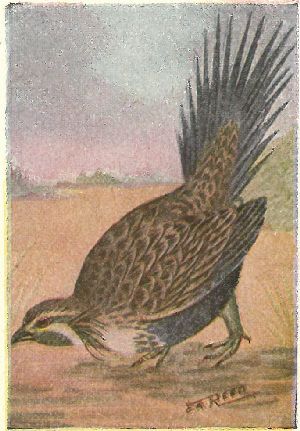
The female of this large and very interesting grouse differs from the male only in its smaller size and paler, duller plumage. They are found in abundance on the dry sagebrush-covered plains about the Rocky Mts. and to the westward. In summer they feed largely upon insects and buds of various plants, but in fall and winter, their food is almost entirely the leaves of the sagebrush; at this season, in consequence, their flesh is unfit to eat, so they are not hunted for market, and are able to pursue a life of quiet as far as man is concerned. In spring, they indulge in amusing play, as do all the grouse; they have a few wiry hairs on either side of the neck, covering the naked sacs that correspond to those of the Prairie Hen; they strut about with these sacs inflated, and their spread tail, erect, making peculiar buzzing sounds.
Nest.—Eggs laid on the ground under sagebrush; greenish-buff, spotted rather sparingly with brown.
Range.—Sagebrush covered plains from New Mexico to Southern British Columbia and Assiniboia.
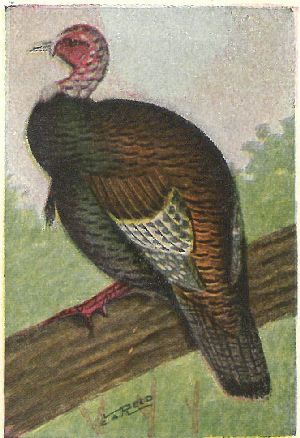
Female much smaller and duller colored than the male. These fine, large birds frequent woodlands and borders of streams, where they search through the underbrush for food in the daytime and sleep in the tallest trees at night. They are one of the shyest birds, and they have reasons for being, for they have been hunted until there are none left in New England and northern Middle States. Wild Turkeys strut and gobble precisely like domestic ones. Their plumage is more of a coppery bronze color and their upper tail coverts are rusty, without white edges.
Nest.—Eggs laid on the ground among leaves, usually in dense thickets; buff, spotted with brown (2.55 × 1.90).
Range.—From Penn. and Ohio south to the Gulf States west to Arkansas. 310b., Florida Wild Turkey, found in Florida, is smaller. 310c., Rio Grande Turkey, is found in southern Texas; it has upper tail-coverts edged with buff.

The male of this beautiful pheasant varies greatly in length according to the development of the tail, sometimes being 36 in. in length; the female averages about 22 in. and is plain colored, but still a very handsome bird. Males vary greatly in the richness of their colors, and in the width of the white collar on the neck, the latter depending upon the extent to which they have been interbred with the English Pheasant, the latter bird having no white on the neck. These pheasants have been introduced in Oregon and Washington and are very abundant there now. Attempts at introducing them in the East have not been as successful, but in some private preserves they are doing well. They are rather sluggish in their habits, compared to our Ruffed Grouse, and usually try to escape by running or hiding rather than by taking wing; when they do fly, they go in a straight line and rather slowly.

Plumage olive-brown above, and gray below; head crested; sides of head and chin, naked, orange-red. These birds are found in southern Texas, in dense woods, thickets and chaparral. They are very noisy, their calls being loud, harsh, clackings, “cha-cha-lac,” repeated rapidly and taken up by all the birds in the neighborhood. They are not usually shy and are often domesticated. They are also hunted to some extent, but their flesh is said not to be very good eating, and their body is quite small compared to the length of the bird.
Nest.—A frail platform of sticks, placed in scrubby brush or bushes, a few feet above the ground. They lay four white or buffy-white eggs, the shell of which is very rough and hard (2.25 × 1.55); April.
Range.—Eastern Mexico north to southern Texas.
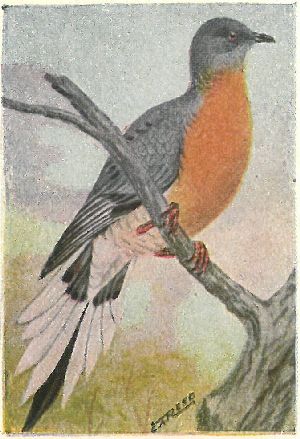
Head and back bluish-slate; below, rich rusty brown. Only a few years ago, up to 1880, they were extremely abundant in eastern North America. Seemingly incredible stories are told of the immense flocks and roosting places of these birds, and most of them are authentic. It is unfortunate that the camera was not extensively used then, so we have no visual records of them. A nesting place in Michigan is described as 28 miles in length by about four in width, and every tree in the woods, throughout this whole tract, had several nests, and some were filled with them. Flocks darkening the sky and covering several square miles are recorded. And, today, but one or two stragglers are reported in a year, and these are usually doubtful. They were shot and netted at their roosting and nesting places, barreled up and sent to market for sale, this continuing so long as there were birds enough to make it profitable, and we reap the result—no birds.
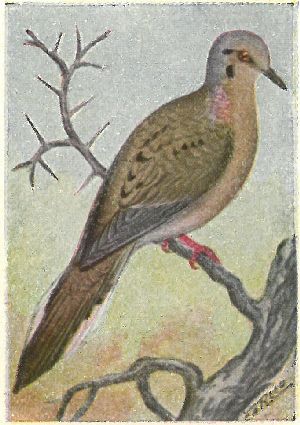
Upperparts olive-brown; below, buffy-gray; a small black mark on the ears above the iridescent neck patch.
These birds never flock as Passenger Pigeons did, traveling in companies of six to a dozen, and they have no common nesting or roosting places, but nest anywhere in the woods, orchards or vines. As they are not often hunted, they are not shy, and in some localities are very tame, especially when they are breeding. Their food consists of seeds, grain, berries and insects, most of which they get from the ground. They nest either in trees, bushes or on the ground, most often the former. Their nests are very frail platforms, composed of only a few twigs and rootlets; when on the ground, usually no nest is made. Their two eggs are pure white, as are those of all doves. They are loving birds, always cooing to each other, and are very attentive to their young until they are full grown.
Range.—Breeds throughout the United States and southern Canada, except northern New England and the Provinces.
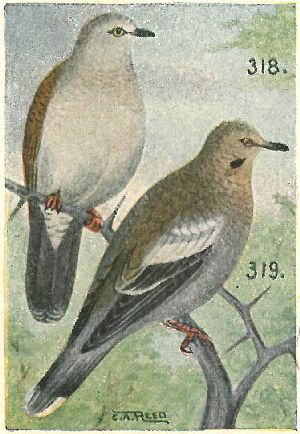
No black ear-mark; under wing coverts rusty chestnut. Forehead whitish; all but central pair of tail feathers tipped with white.
Nest.—Indistinguishable from that of the next species.
Range.—Central America and Mexico, north in February to valley of Lower Rio Grande.
Large black patch on the ears; tail only moderately long, and broadly rounded, with large white ends to the outer feathers. Besides the regular cooing notes, common to doves, this species has a peculiar song likened by some, to the first attempts at crowing, of a young rooster.
Nest.—A shabby platform of twigs, lined with bits of weeds, moss and leaves; placed at any height from the ground in bushes, trees or cacti. Eggs white.
Range.—Texas, New Mexico, Arizona and casually southern Florida, southward.
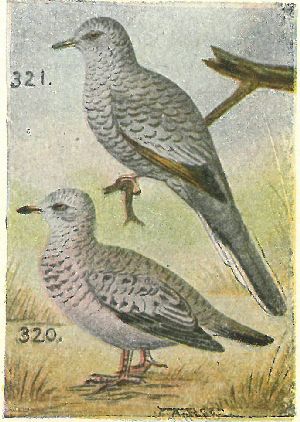
Size very small; tail short and nearly square. Back of head blue-gray; forehead and most of underparts pinkish. Bill, feet and eye, more or less red.
Nest.—A frail structure of twigs, lined with pine needles; placed usually at low elevations in bushes. The two eggs are pure white.
Range.—South Atlantic and Gulf States; abundant near the coasts; winters throughout its range.
320a., Mexican Ground Dove, found from Texas to California, is slightly paler than the eastern species.
Tail long, with the outer feathers tipped with white, and shorter than the middle ones. Feathers mostly margined with brownish-black. The bases of the primaries are bright chestnut, and the whole underwing is of that color; bill black; eye and feet reddish.
Range.—Southern Texas, southern Arizona and southern New Mexico.
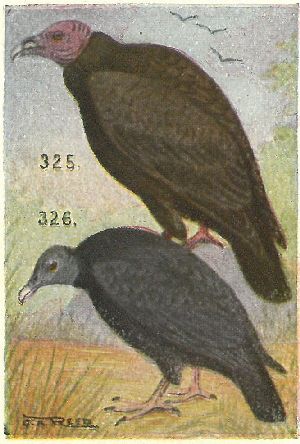
Head naked; red or carmine; bill dull whitish; eyes brown; feet pinkish. Plumage blackish-brown.
Nest.—Their two eggs are laid upon the ground, between rocks, under logs, or in hollow trees; they are whitish, handsomely blotched with brown.
Range.—Breeds from the Gulf north to New Jersey, Illinois, Minnesota and British Columbia.
Entire plumage, including the naked head, black; feet and tip of bill yellowish. Under surface of the wings white, making it very easy to identify.
Nest.—Two eggs, greenish-white, blotched with brownish. (3.00 × 2.00).
Range.—Resident north to North Carolina, southern Illinois and Kansas.
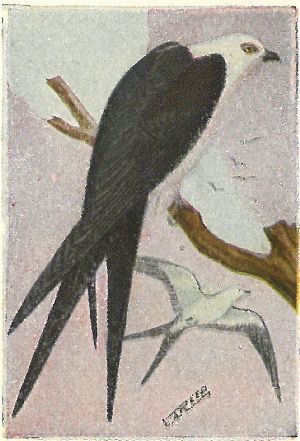
Tail long and deeply forked; plumage white, and glossy black; feet short but stout; bill black, with cere and feet bluish-gray. The flight of these birds is very swift and swallow-like; at times they circle about for long periods, on motionless wings; at others, they will be seen swooping over marshes and low ground; the evolutions they perform during the mating season are wonderful to behold, floating, sailing, doubling and turning, in all imaginable positions, as though they were a part of the air itself.
Notes.—A shrill whistled “peet-peet.”
Nest.—Composed of twigs, lined with moss and rootlets; usually located in the tops of trees at great heights; 90 to 125 feet from the ground not being uncommon; eggs pale bluish-white, very handsomely marked with brown (1.85 × 1.5).
Range.—Breeds north to Virginia, Manitoba and Minnesota; winters south of the United States.
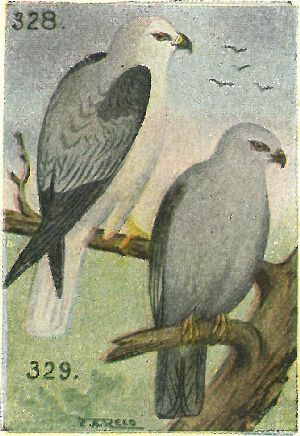
Head, underparts and tail, white; shoulders black; upperparts gray. Young, with the back tinged with rusty. Their food consists largely of snakes, but they also eat a great many small rodents and insects.
Nest.—Made of sticks, weeds and leaves, and placed in trees at quite an elevation from the ground; eggs creamy white, profusely blotched with brown.
Range.—Texas to central California, and less often east of the Miss. River, north to South Carolina.
Head, underparts and ends of secondaries, bluish-gray. Lores and tail black; back dark; eyes red.
Nest.—Of sticks and weeds in the tops of tall trees; eggs bluish white, usually unmarked, but occasionally with a few brownish specks (1.65 × 1.25).
Range.—Breeds north to South Carolina, southern Illinois and Kansas; winters south of the United States.

Bill very slender and much hooked, the lower mandible being decurved somewhat, to match the upper; the cutting edge of the bill without a tooth or notch, as most hawks and kites have. Lores naked and yellowish, like the cere; eyes red. Plumage blackish; rump and bases of outer tail feathers, as well as tip white. This tropical species is found in the United States, only in the southern half of Florida, in the densest swamps, being fairly abundant in the Everglades. They are said to feed exclusively upon a certain species of water snail, and each bird has a particular perch to which he takes every snail he captures, and after skillfully extracting the animal with its curiously modified beak, it drops the shell on the mound beneath. (Bendire).
Nest.—Of twigs, lined with leaves and weeds, placed at low elevations in bushes or underbrush, often over water; eggs pale greenish-white, spotted with brown.
Range.—Southern Florida.
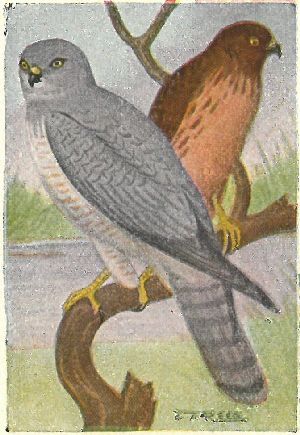
Upper tail coverts and base of tail white. Male, blue-gray above; below, whitish, streaked and barred with rusty. Female and young.—Above rusty brownish-black; below rusty with dusky streaks on the breast and sides. As shown by its name, this hawk is found most abundantly in or around marshes or wet meadows. I have found them especially abundant in boggy marshes such as frequented by bitterns. Their flight is quiet and owl-like, and as they do most of their feeding toward dusk, they often seem like owls as they flit by without a sound. Their food is composed chiefly of meadow mice and moles, which they spy and dash down upon as they fly at low elevations.
Notes.—A shrill whistle when their nest is approached.
Nest.—Of grasses, on the ground in marshes; four plain bluish-white eggs (1.80 × 1.40); May, June.
Range.—Breeds locally in the whole of the United States and Canada, north to Hudson Bay; winters in the southern half of the United States.
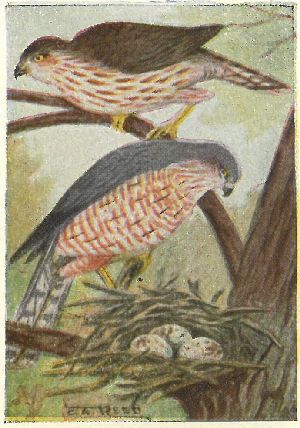
This little hawk, so near like the Cooper, is one of the most active of the family, and from this fact it gets its name velox, meaning swift. It is often seen in woods, orchard, or even about buildings in large cities, in which latter places, it does good service in catching English Sparrows. If they would confine their food to these birds, no one would object, but unfortunately they will take any little bird that comes within their reach, or that they are able to catch. They are one of the very few hawks that do live largely upon birds, and even they destroy a great many mice.
Notes.—A shrill, three-syllabled whistle.
Nest.—A rude and usually frail structure of twigs, placed in branches of trees, usually at quite low elevations (15 ft.). Eggs white, beautifully blotched with brown (1.45 × 1.15).
Range.—Breeds chiefly in northern U. S. and Canada; winters throughout the United States.
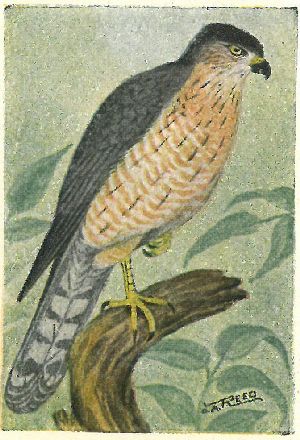
This hawk is a large edition of the last species. All hawks vary in size, this one and the last, perhaps, more than any others. Female hawks are always the largest. A large female of the Sharp-shinned variety, is often as large as a small male Cooper, but the crown of the Cooper is darker than that of the Sharp-shinned, and his tail is always rounded, while that of the last species is nearly square at the end. This is also a destructive species; it is usually one of these two hawks, or the Goshawk, that is responsible for the ill-feeling with which farmers regard all of the family. All small hawks are known to farmers as “Chicken Hawks,” and large ones as “Hen Hawks,” but the majority of our hawks rarely disturb fowls.
Nest.—Of sticks in crotches of trees, usually quite high up; often old crows’ nests are used; eggs bluish-white, unmarked or very faintly specked with brown. (1.90 × 1.45); April.
Range.—Breeds from the Gulf north to southern Canada; winters from Mass. and Oregon southward.
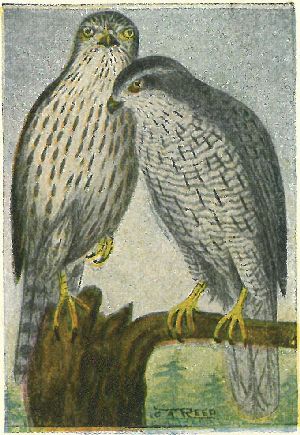
Adults, above bluish-slate, darkest on the crown; a whitish line over the eye; below white, finely waved with gray. Young, brownish-black, with lighter edgings to the feathers; below whitish, streaked with blackish-brown. Young birds can easily be distinguished from those of any other species by their large size and the long tail. This handsome species is one of the most rapacious and destructive of our birds of prey. Their short wings and long tail enable them to glide among the thickest foliage with great speed, and even the Ruffled Grouse cannot escape them. In the north where they live in summer, they destroy great numbers of Ptarmigan and Spruce Grouse, and come to us in the winter with their appetite whetted for a diet of poultry and our game birds, being exceedingly bold in their capture.
Nest.—Of sticks lined with weeds and bark, in tall trees; eggs white, unmarked.
Range.—Breeds throughout Canada; winters in the northern half of the United States.
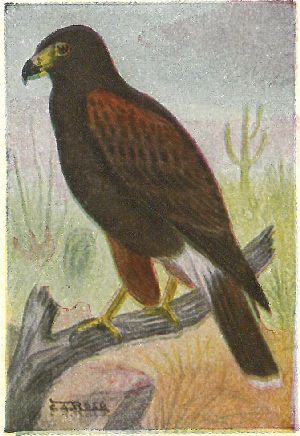
Tail coverts, base and tip of tail, white. Adults with the shoulders, thighs and under wing-coverts, reddish-brown. Young with rusty edgings to feathers on the back; below, rusty buff with blackish spots or streaks; thighs barred with blackish. Space in front of eye, bare except for stiff hair-like bristles, yellowish like the cere. This species is the connecting link between the vultures and hawks of the genus buteo. Its feedings habits are similar to those of the vultures, with which it often associates when feeding upon carrion. They are very sluggish birds and their flight is slow and heavy; when not feeding they are usually perched on one foot on some dead limb, dozing.
Nest.—Made of sticks, twigs and weeds, placed in bushes or low trees. Their three or four eggs are dull white, unmarked (2.10 × 1.65).
Range.—Mexico, north to southern United States chiefly in Texas, but also found in New Mexico and casually east to Louisiana.
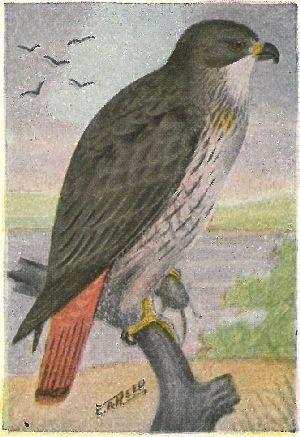
One of the handsomest and most powerfully built of our hawks. Adults with the tail rusty-red, with or without a narrow blackish band near the tip; below white, with a band of blackish streaks across the breast, and dusky markings on the sides. Young birds are similar, but have the tail grayish-brown with black bands. An examination of the food of this bird of prey, made by the Department of Agriculture, shows that, instead of living upon poultry as most farmers think, their food consists chiefly of frogs, snakes, lizards, mice and insects, less than one in ten of the stomachs examined containing any remains of poultry.
Notes.—A shrill whistle or scream.
Nest.—Of sticks, weeds, leaves and trash high up in tall trees; eggs white, spotted with blackish-brown.
Range.—Breeds in United States and Southern Canada; winters in the United States. 337a., Krider Hawk is a paler race found on the plains from Minn. to Texas. 337d., Harlan Hawk, is darker and has the tail mottled with blackish; found in the Gulf States.
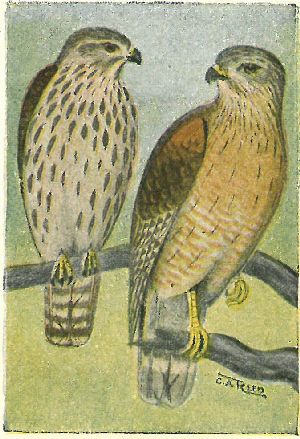
Adults with the shoulders bright reddish-brown; primaries and secondaries barred with black and white; below buffy thickly barred with rusty-brown. Young with the shoulders duller; underparts white, streaked all over with blackish-brown. This is one of the most abundant of the birds of prey in Eastern United States, and it is also one of the most useful, destroying quantities of moles and field mice, as well as grasshoppers. Usually one or more pairs will be found in a piece of woods. One pair that I know, and I presume it is the same pair, each year has its nest on the edge of a colony of Black-crowned Night Herons and, during the season, they live and feed their young largely upon the young of these birds.
Nest.—Of sticks, lined with weeds and strips of bark; eggs white, blotched with brown (2.15 × 1.75). April, May.
Range.—Breeds from the Gulf to Maine and Minnesota. 339a. Fla. Red-Shouldered Hawk, found in Florida and north to So. Car., is paler colored.
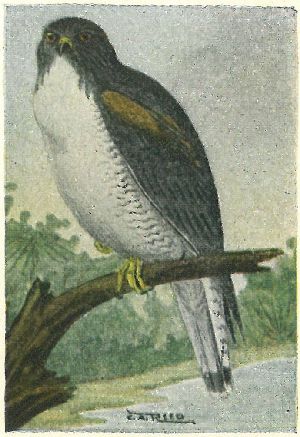
Adults grayish-slate above and to the sides of the throat; tail and underparts white, the former with a subterminal band of black and indistinct wavy lines and the latter with fine barring on the sides. The shoulders are largely chestnut. Young birds are brownish-black above and usually white below, but the underparts are variable—often streaked with rusty and blackish, or even wholly black.
They are useful hawks, their food consisting chiefly of insects and moles or mice.
Nest.—Built in bushes in open land, rarely more than six feet above ground. Composed of sticks, dry weeds and grasses making a bulky structure visible for a long distance. Three eggs are not uncommon but two is the usual number; they are dirty white with very few marks of brown (2.35 × 1.85). Their nesting season ranges from as early as February to July.
Range.—Not uncommon on the Gulf coast of Texas and in the lower Rio Grande Valley, southwards into South America.
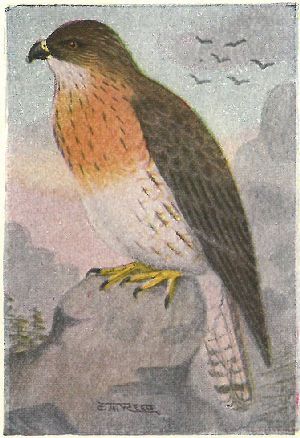
This species has the greatest variety of plumages of any of our hawks. It has only three outer primaries notched near the tips, while the two last species, which are the only ones that can be confused with it, have four. Adults in the light phase have a band of rich chestnut across the breast. Adults in the dark phase are uniform blackish-brown, with some rusty edgings and with thighs more or less rusty. Young birds are buffy below, with elongated blackish spots. Its harmless character can be understood from the fact that it is no unusual sight to find other birds, such as Arkansas Kingbird and Bullock Oriole, nesting in the same tree; and the first mentioned species goes even further than this, sometimes constructing its home in the sides of the nests of the hawks.
Nest.—Of sticks and twigs, either in trees or on the ground on rocky ledges; eggs white, spotted with brown (2.20 × 1.70).
Range.—Western N. A., breeding from Texas to the Arctic regions; east to Illinois and west to the Pacific.
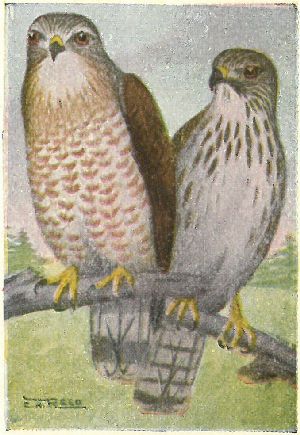
Adults grayish-brown above; below, streaked on the throat and breast, and barred below, with rusty-brown; tail with three blackish bars. Young similar above; below white, streaked with blackish-brown. They are most apt to be confused with the Cooper and Red-Shouldered Hawk, but when in flight, it can usually be distinguished at a distance, from the former by its shorter tail, and from the latter by its smaller size and rounded wings. They may be classed as abundant east of the Great Plains. They are rather solitary in their habits, especially during the breeding season, when but one pair is usually found in a piece of woods.
Notes.—A long, squeaking wail, sounding much like two branches rubbing together and creaking.
Nest.—Of sticks, invariably lined with pieces of bark; usually placed in crotches next to the trunks of large trees, but not usually at a great height; eggs whitish, more or less blotched with brown and gray.
Range.—Breeds north to New Brunswick and Manitoba; winters in southern half of the United States.
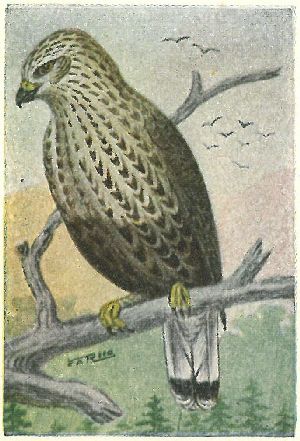
Legs feathered to the toes. Adults blackish on the back and belly; head and breast, more or less grayish-white, streaked with dusky; tail white, barred on the end with black; eyes brown. In the dark phase they are blackish-brown, more or less mixed with rusty. This large, heavily-built species is found in the United States, only in winter; it frequents thinly wooded districts or meadows, where it catches its prey, which consists of small rodents, insects and reptiles. It is very irregular in its appearance, especially in the east, but it is most often found near the coast. It is a sluggish species and I doubt if it does any harm to wild birds or to poultry; it certainly does a great deal of good.
Nest.—Of sticks, on rocky ledges; eggs bluish-white, boldly splashed with brown (1.90 × 1.55).
Range.—Breeds north of the United States border; winters in northern United States.
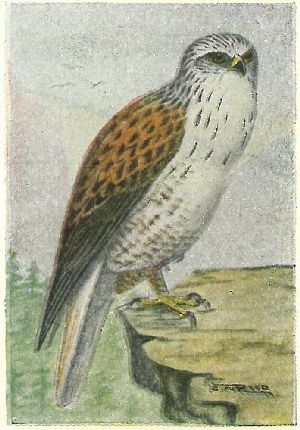
Legs feathered to the toes. Adults with back, shoulders, thighs and legs, rusty, barred or streaked with black; tail grayish-white, tinged with rusty. Young birds are brownish-black, above and without any rusty below. In the dark phase they are sooty-brown, more or less varied with rusty, and the tail is the same as in the light plumage. Their bill is larger and tail longer than that of the last species. A fairly abundant hawk on the plains and prairies west of the Miss., usually not at a great distance from water.
Nest.—Usually on the ground on bluffs or rocky ledges, but sometimes in trees; made of sticks and weeds; sometimes used year after year, and then becoming bulky, as it is added to each year; eggs white, handsomely spotted and blotched with blackish-brown, very variable.
Range.—Breeds west of the Miss., from Kansas, locally, and the Dakotas, abundantly, north to Saskatchewan. Winters south to Mexico.
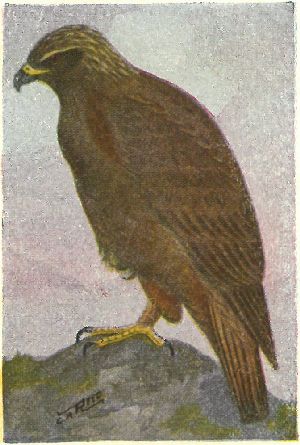
Legs feathered to the toes. Plumage blackish-brown, adults having the lengthened feathers on the nape, golden-brown, and the tail more or less mixed with white; leg feathers rusty. These large, handsome, well-built birds of prey are fairly abundant in thinly settled country west of the Miss., especially in mountains and foot-hills. They are very powerful birds and a single pair of them will rule the whole country in which they reside. They are very shy in the presence of man and will never attack a person or show fight unless wounded or surprised at their meals. Their food consist of prairie dogs, rodents, ducks and even fawns.
Notes.—A shrill a “kee-kee-kee.”
Nest.—A very bulky structure of large sticks, lined with twigs, needles and in some cases evergreen; eggs creamy-white, spotted, splashed and clouded with various shades of brown and gray (2.90 × 2.50).
Range.—West of the Miss., from Mexico northward; rarely eastward to the Atlantic coast.
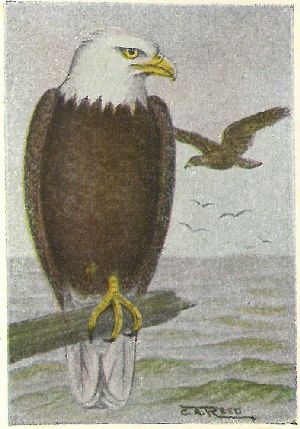
Legs not feathered to the toes. Adults with white head and tail. Young birds similar in color to those of the Golden Eagle, but blacker and with the legs always bare on the lower half. Young, with brown eyes, like those of the last; adults with yellow eyes and feet. This handsome bird of prey, our national emblem, is resident and locally distributed throughout the United States and Canada, always near streams or lakes, and most abundant on the seacoasts. Their food, like that of the Golden Eagle, is chiefly caught by themselves, and consists of any small mammals, geese, ducks, etc., and during the summer, or when their usual food is scarce, they feed upon fish, which they either catch for themselves or taken by force from Ospreys.
Nest.—Of sticks large and bulky, and usually in tops of very tall trees; two eggs, pure white (2.75 × 2.10).
Range.—Resident locally in whole of North America.
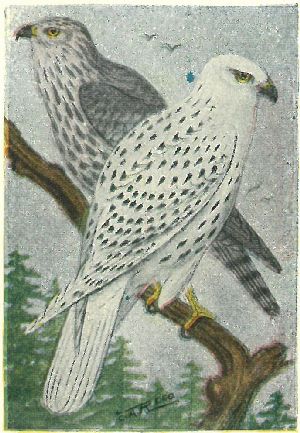
Adults in perfect plumage, pure white, slightly barred on the back and spotted below with black.
Nest.—Of sticks, lined with grasses and feathers; placed on ledges of cliffs; eggs bulky white, specked with reddish brown, often so thickly that the ground color is obscured (2.30 × 1.80).
Range.—Arctic region, breeding in Northern Greenland, and wintering to the Gulf of St. Lawrence, and casually to northern Maine.
Adults white, heavily barred above, and streaked below with gray and black.
Range.—Arctic regions, south in winter, rarely to northern United States.
354a. GYRFALCON (F. r. gyrfalco). Similar to the last but darker, the latter being usually more white than dusky, while this is the reverse.
354b. BLACK GYRFALCON (F. r. obsoletus). Much darker than the last, the markings tending to be buffy white spots on a grayish black ground.
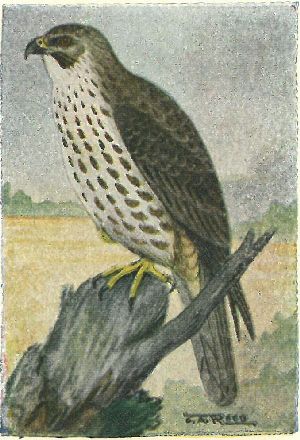
A blackish patch on the sides of the throat, similar to that of the Duck Hawk. Above brownish black, much paler and never with the slaty color of the Duck Hawk; below streaked or spotted with blackish brown. These falcons are fairly abundant on the western plains and prairies, and are also found in wooded mountain regions. They are strong and active and will fight fiercely if captured. They live upon small mammals, birds and occasionally, grouse. Their flight is very swift and accomplished by rapid wing beats, with occasional sailings.
Notes.—A cackle, and rapidly repeated “kee-kee-kee.” (Bendire).
Nest.—A mass of sticks and trash, on bluffs or rocky ledges, and sometimes in trees; eggs reddish buff, thickly sprinkled and blotched with brown (2.50 × 1.60).
Range.—Eastern border of the Great Plains to the Pacific; and from Saskatchewan to southern Mexico.
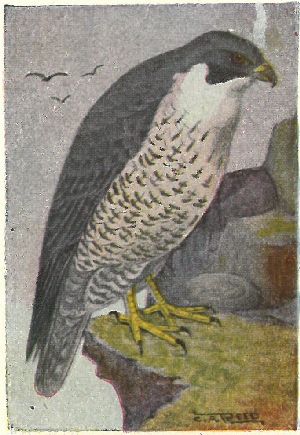
Black moustache mark, or patch on each side of the throat. Adults white below, tinged with buffy on the breast and sides, and lightly barred with black; above bluish slate, darkest on the crown. Some adults are darker, and much more heavily barred than others. Young, brownish black with rusty edges to the feathers; below, buffy, heavily streaked with blackish. This is one of the handsomest and most dashing of the raptores, and is very similar to the one formerly most used for the chase in England. They are swift and fearless in pursuit of their prey, and the fastest flying ducks as well as the slower herons fall easy victims to their valor. Their feet are exceptionally large, and they are often, on this account, known as Great-footed Hawks.
Nest.—Eggs laid upon bare ledges or soil, with very little, if any, nest. Bright buff, marked with rich rusty brown (2.05 × 1.55).
Range.—Breeds in Northern United States and Canada, most abundant west of the Miss.
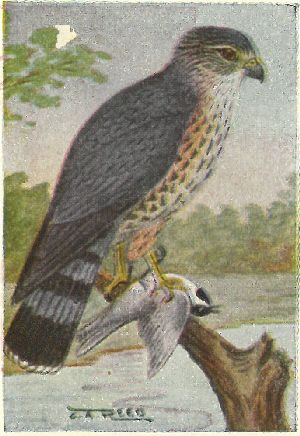
Adult male, bluish slate above, with black shaft lines to the feathers; below buffy on the breast, sides and thighs; streaked on the breast and barred on the flanks with black; tail with four black bands. Female and young, blackish brown above; below streaked with dusky. These little falcons are very bold and courageous when led by the pangs of hunger, chasing their prey close to human beings, and they have been known to follow birds, which, in their fright, have dashed through windows in houses. They live upon any of the smaller birds, as well as rodents, grasshoppers and other insects.
Nest.—Usually a slight platform of twigs in trees, deep in the woods, less often in cavities in trees, and sometimes on ledges; eggs buffy, heavily blotched with chestnut (1.50 × 1.20).
Range.—Breeds chiefly north of the United States, but occasionally on the northern border; winters in northern United States.
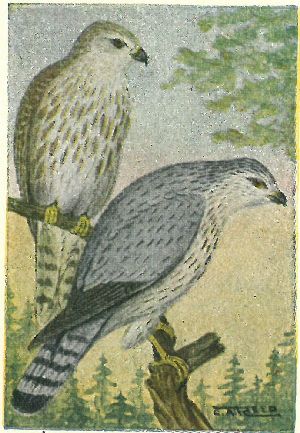
Both adults and young are similar to the same of the last species, but they are much paler colored, and the tail is crossed by six light bars. The habits of this species, which seems to have quite a limited range, are precisely like those of the Pigeon Hawk. Like that species, it flies swiftly, with rapidly beating wings, and occasionally sails and soars. The under surface of the wings is prominently barred, but not as much so as that of the Pigeon Hawk; it is very conspicuous when in flight.
Nest.—Either in hollow trees, or a rude platform of sticks, usually not very high from the ground; eggs buffy white, handsomely blotched with brown (1.60 × 1.25).
Range.—From the Miss. to the Rockies, and from Mexico north to Saskatchewan, locally distributed.
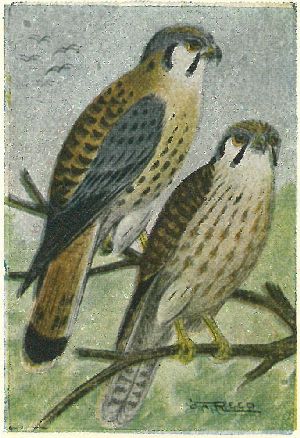
This is the smallest and one of the handsomest of our hawks. Cannot be mistaken for any other species, because of its bright colors and odd marking. The female is barred on the back, wings and tail, while the male has but a few short bars on the back. The general tone of both, above, is a bright rusty-brown. This is the most abundant hawk that we have, and it is also best known, chiefly because it is found commonly in the vicinity of farmhouses and commonly on the outskirts of cities. Their flight is peculiar, a few rapid wing beats, then a short sail, alternately. They are very noisy in mating season and when the young birds first fly, their notes being a rapidly repeated, “killy-killy-killy.” Their food is of grasshoppers, mice and rarely small birds.
Nest.—Usually in cavities in trees, often in deserted Flicker holes, the eggs being laid upon the bare wood. They are cream colored, finely sprinkled and spotted with brown (1.35 × 1.10).
Range.—Breeds from the Gulf States to Labrador and Hudson Bay. Winters in southern United States.
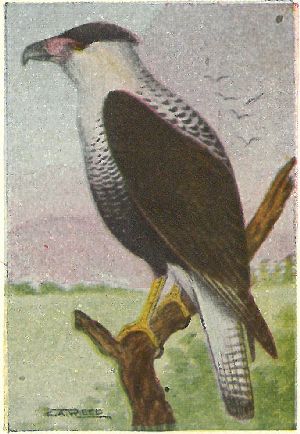
These peculiar birds cannot be mistaken for any of our hawks or falcons. They are very sluggish birds, with habits resembling both those of buzzards and some of the hawks. They are usually known in localities where they are found, as Caracara Eagles. As we might suspect from the shape of their bill, the naked and bristle-covered lores, and the feet, which have not the strongly hooked talons of hawks, the food of these birds is largely carrion. It is terrestrial in its habits and is most often seen, when not in flight, either upon the ground, or standing erect on branches at low elevations. They are more quarrelsome in their disposition than are vultures, and frequently fight over their prey.
Nest.—A bulky, but shabby pile of sticks and weeds, in bushes or low trees; eggs buff, sprinkled, spotted or blotched with yellowish brown or chestnut (2.50 × 1.80).
Range.—Resident of the Mexican border of the U. S. and in southern Florida.
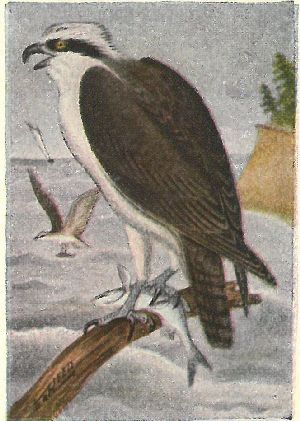
Real old birds have the head whiter, and less white edging to the back feathers, than do the young. Feet very strong, and very hard and rough, perfectly adapted to grasping slippery fish; outer toe can be used equally as well, either in front or behind, when perching or grasping their prey. Their food is entirely of fish, which they catch themselves, by plunging after it, hovering in the air a few seconds while watching the fish, preparatory to diving upon it. They are always found about water and are very numerous on the seacoasts, where twenty or more may frequently be seen at a time. They are protected by law in some states, and by public sentiment in most others.
Notes.—A loud, tremulous, piercing whistle.
Nest.—Usually in trees; large and bulky, of sticks; sometimes on the ground, telegraph poles, chimneys, etc. Eggs creamy buff, blotched with rich brown (2.40 × 1.80).
Range.—Breeds from the Gulf to Labrador and Alaska; winters in the southern half of the U. S.
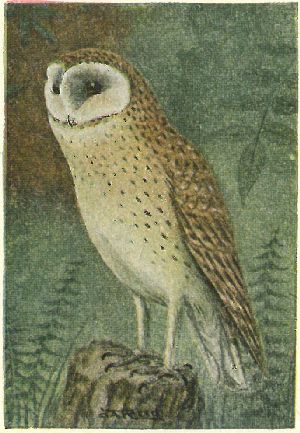
Plumage very soft, finely barred and specked; general coloration gray, yellowish-brown and white. No ear tufts; eyes small and brown; face very long; legs very long. These peculiar owls are abundant in the south, where they are commonly known as “Monkey-faced Owls,” because of their odd visage. They are very useful birds, and are usually recognized as such. Their food consists almost wholly of small squirrels, rodents, reptiles and insects. It does most of its hunting just after dusk and early in the morning. Its flight is rather slow and entirely noiseless, as is that of all the members of the family.
Nest.—In hollow trees, under the roofs of barns or in caves; the four to six eggs are pure white (l.70 × 1.30).
Range.—United States, breeding north to New York, Ontario, and Washington. Winters in the southern half of the United States.

This species can readily be distinguished from the next, which is the only one of the same size, by its long ear tufts; it is also darker, and the markings on the breast are largely in the form of bars. In the northern portions of the United States, this species is probably the most abundant of owls, excepting the little Screech Owl. It is often quite common, where its presence is little suspected, because, unless disturbed, it flies only at night and is a rather silent species. During the daytime it is usually sitting upright in the dense tops of evergreen trees. Crows often discover them, and proclaim their hiding place to the whole neighborhood by their incessant cawing. Owls of all kinds are in disfavor with crows.
Notes.—A soft-toned “wo-hunk, wo-hunk.” (Bendire.)
Nest.—They lay from four to seven pure white eggs, usually in old crow nests.
Range.—Resident from the Gulf to Nova Scotia and Manitoba.
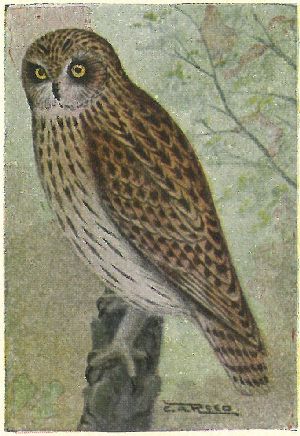
Ear tufts very short; general color buffy, not nearly as brown nor as dark as the last species usually is. They are not nearly as nocturnal as most of the owls, and most of their hunting is done about dusk, when they may be seen flying close to the ground over marshes or low land. Their flight is perfectly silent, which aids them in securing their prey of field mice, which they usually get without stopping in their flight, just swooping down, extending their long legs, armed with wicked little claws, and it is all over with the little rodent, he being carried to a nearby stump, and devoured, fur, bones and all.
Notes.—A very short, shrill cry, evidently their call note, and a low clucking uttered as they swoop over your head; besides the usual snapping of the bill.
Nest.—On the ground, usually in marshes; the four to seven eggs are pure white, (1.55 × 1.25).
Range.—Breeds locally from the Gulf to the Arctic regions; winters throughout the United States.
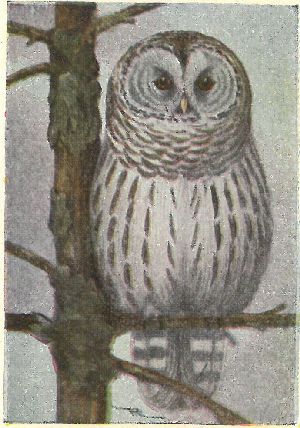
Eyes dark brown. This is the most abundant of the large owls throughout its range. It has no ears. This species is the common “hoot owl,” that is the terror of small children and many older ones. They are noisy birds, and two of them like to get at opposite sides of a piece of woods and talk to each other. Their notes are very variable but are oftenest combinations of “who-whos” and “too-toos,” often ending in a mournful wail. They spend the day in slumber, unless routed out of the dense trees where they rest, by crows or human beings. They are one of the least harmful of the family and should be protected.
Nest.—Usually in hollow trees, but sometimes in old crow nests. Eggs pure white (1.95 × 1.65).
Range.—Resident in eastern North America. 368a. Florida Barred Owl (alleni), is smaller, darker and the toes are unfeathered, as are those of 368b, Texas Barred Owl, found in southern Texas.
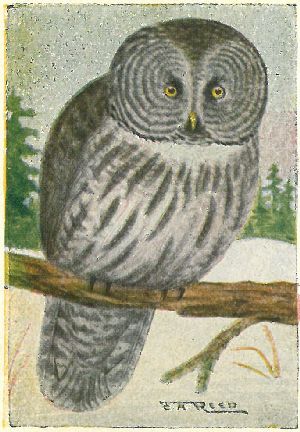
Tail long; eyes small and yellow. This large owl is only found in Northern United States during the winter. Its tail is unusually long, as are all its feathers, thereby making it appear a very much larger bird than it really is; it weighs but little more than the Barred Owl. They do not appear to be in especial abundance anywhere, but occasionally large flights of them will occur in some parts of the country; they seem to occur most freely in Minnesota and North Dakota. They are nocturnal like the majority of the family, and subsist largely upon mice and hares.
Nest.—Of sticks, in trees, usually pines, in heavily wooded districts; eggs white (2.15 × 1.70).
Range.—Breeds from southern Labrador, Hudson Bay and Alaska northward; winters south to the northern border of the United States and casually to Long Island and Illinois.
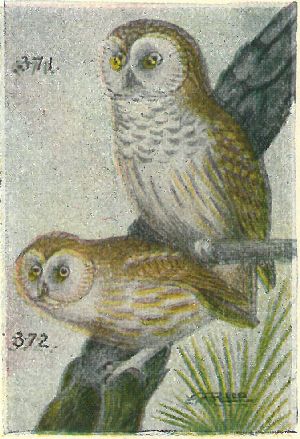
This species bears considerable resemblance to the little Acadian Owls, but is grayer; the top of the head has numerous round white spots and the wing coverts are spotted with white.
Nest.—Usually in holes of trees; eggs white.
Range.—Breeds throughout Canada, and possibly in the northern parts of the northern states; winters south to northern United States.
Smallest of our eastern Owls; no ear tufts. General color brownish above and white below with the sides streaked with brown. No markings on wing coverts, but scapulars spotted with white. It is chiefly nocturnal in its habits and, consequently, is not often seen even if they are abundant.
Range.—Breeds from northern U. S. northward; winters in northern United States.

Two color phases independent of age, sex or season; eyes yellow; has ear tufts. The Screech Owl, or its sub-species, is found throughout the United States, and is one of the most abundant and best known of the family. They are not at all timid, in winter frequently being found in church towers, while on the outskirts of cities and in the country, they reside, at all seasons of the year, in orchards. They remain mated for life, and live in the same tree for years, if not too much disturbed by curious boys. Both adults and the four young are often found in the nest together, and they offer no resistance when they are removed by hand. Their food is almost wholly of insects and rodents.
Notes.—A wavering trill.
Nest.—In holes of trees; eggs white (1.35 × 1.20).
Range.—Resident in U. S. and southern Canada. 373a. Florida Screech Owl (floridanus), is smaller and slightly darker, 373b. Texas Screech Owl (mccalli), is smaller and more heavily barred on the sides.

Has ear tufts, thus distinguishing it from any other of our large, powerfully built owls. These large birds are the fiercest, most active and most destructive of the family. Their size and strength allows them to kill skunks and woodchucks, as well as poultry, grouse and small mammals and birds. They seem to be especially fond of skunks, and nearly all of them that I have seen or handled, have given unmistakable evidence of their recent and close association with these animals.
Notes.—A deep, dismal “who-who,” and a loud unearthly shriek.
Nest.—Usually in deserted hawk or crow nests, and also in hollow trees; eggs white (2.25 × 1.85). Feb., March.
Range.—Breeds and resident from the Gulf to Labrador. 375a. Western Horned Owl (pallescens) is paler colored; found in the plains and Rockies north to Manitoba. 375b. Arctic Horned Owl (subarcticus), is chiefly black and white; found in Arctic America, wintering south to northern border of United States.
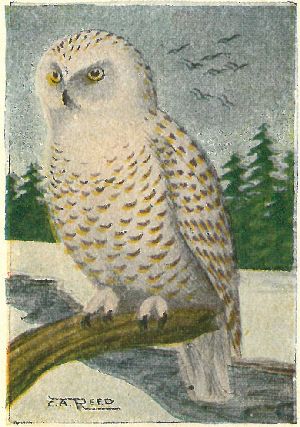
No ear tufts. Plumage white, more or less heavily spotted with black, the female usually being quite strongly barred on the back. They are locally abundant in the far north, preferring low, mossy lands to the more timbered districts. Here they find an abundance of food during the summer months, living upon hares, lemmings, ptarmigan and ducks. They are about the equal of the Horned Owl in strength, and usually will weigh a few ounces more; they will frequently kill animals or birds as heavy, or heavier, than themselves. They also catch a great many fish; these they get in shallow water among the rock-weed covered stones, by reaching down quickly and seizing their prey in their strong claws.
Nest.—On the ground in dry portions of marshes; the 2 to 8 eggs are pure white.
Range.—Breeds from Labrador and Hudson Bay, northward, and possibly farther south; winters casually to the Middle States, and commonly to Minnesota and Maine.

Tail long and rounded; plumage mottled black, white and gray, with little, if any, brownish tinge; heavily barred with black. These owls, curiously resembling a hawk in build, and more so in flight, are very active and hunt more during the daytime than after dark. They feed largely upon small rodents and lemmings which are very abundant in their summer home, and also kill a great many small birds. They seem to be impartial to wooded districts, or open marshes and low lands, where they may be seen skimming about close to the ground.
Nest.—Either of sticks in the tops of trees, or in hollow cavities. The eggs are white, as are those of all owls, and nearly globular in shape (1.40 × 1.25).
Range.—Breeds from Newfoundland and Manitoba northward, and possibly farther south on the mountains. Winters south to northern United States, rarely to New York and Illinois.

Legs very long, and nearly bare on the lower part of tarsi; tail short; no ear tufts. An abundant and useful species in the prairie regions west of the Mississippi. They live in the same region that prairie dogs are found, using deserted burrows of these animals, or taking them by force, for they are more than a match for these curious animals; they do not, as has often been said, live peaceably in the same burrows with them. On the contrary, young prairie dogs, as well as rodents, small snakes and birds, form a large part of their daily diet. They are both diurnal and nocturnal, doing most of their hunting after dusk, but often seen sitting at the mouth of the burrow during the daytime. The six to ten eggs that they deposit at the end of these burrows are white.
Range.—West of the Miss. Valley, north to Southern Manitoba and British Columbia. 378a. Florida Burrowing Owl (floridana), is smaller and whiter; found in southern Florida.
[A] [B] [C] [D] [E] [F] [G] [H] [I] [J] [K] [L] [M] [N] [O] [P] [Q] [R] [S] [T] U [V] [W] X [Y] Z